







Position plays pivotal role in police chief search
By Dana Rieck
By Alvin A. Reid
The St. Louis American
A group of St. Louis Public Schools parents, teachers, and board members were in Jefferson City on Wednesday to voice opposition to a pair of bills that could strip the district of $18 million.
House Bill 1552 and Senate Bill 869 could change existing provisions to the state’s local aid (for SLPS), essentially re-allocating $18 million in public school funding to charter schools.
“There is nothing fair or equitable about an $18 million loss to our district,” said
Emily Koeltzow, SLPS Parent Action Council president.
“SLPS’s doors are open to all and with that comes the need for programs and services that charter schools and few other public districts in the state have ever imagined having to provide, let alone pay for.
“Taking such a large sum away from the efforts to help children makes no sense,” she said.
SB 869 is sponsored by Republican state Sen. Andrew Koenig, who represents parts of St. Louis County. HB 1552 is sponsored by Republican state Rep. Doug Richey from Excelsior Springs.
According to SLPS, there is support from both Democrats and Republicans to exempt SLPS from the proposed legislation.
Matt Davis, SLPS Board of Education secretary and Legislative Committee chair, said, “It is our responsibility, and it is our privilege to provide individual and targeted services to our students, no matter how challenging.”
“However, it comes at a cost. It takes far more funding to provide the services required to educate a child with severe needs or to bridge the gap for students with fewer resources.”
The SLPS parents made the trip “on their own time in order to make their voices heard,” Koeltzow said.
By JoAnn Weaver
With the voter-approved Medicaid expansion amendment again under Republican assault, state Sen. Brian Williams is ripping the effort many see as misguided.
“To think that this is still a conversation after the voters have shown at the ballot box that they want to expand Medicaid in Missouri, well it is extremely frustrating that we are still having this conversation,” Williams said.
“We should be doing everything in our power to ensure that folks have access to health care and not creating any barriers. It is important to be clear about the fact that people under Medicaid expansion are already working, and if they aren’t working, they would have
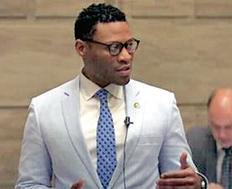
State Sen. Brian Williams called Missouri’s approach to Medicaid enrollment “a mess,” and he blames Republican legislators and Gov. Mike Parson.
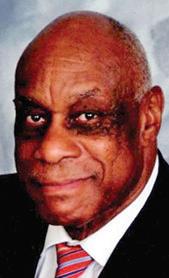
at the
as the
of
Commission continues the
for a
manent
Moten said in a
“I look forward to working alongside department employees to
a strong foundation for
The Civil Service Commission is composed of three
members, appointed by current and past
of
Moten replaces former Personnel Director Richard Frank, who retired in December. Frank told The St. Louis Post-Dispatch this year the police chief finalists would be chosen solely by his department, breaking from the way in which current Chief John Hayden was chosen under Mayor Lyda Krewson, who hired an outside consultant to find and pick the finalists. His department established qualifications for
By Dawn Suggs
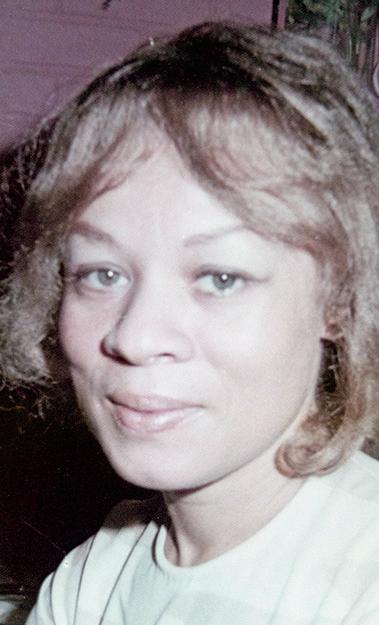

Nelly apologizes for NSFW IG video, says account was hacked
St. Louis rap star Nelly issued an apology on Tuesday after an NSFW video was posted to his Instagram account.
Nelly’s face was not visible in the short clip, but his voice could be heard as he filmed a woman performing a sex act.
The video was promptly removed from the Grammy winner’s account, which has 3.3 million followers. However, some captured screen recordings still circulated on social media.
The rapper issued a statement to TMZ apologizing to the woman involved in the video and her family.
“I sincerely apologize to the young lady and her family, this is unwanted publicity for her/ them,” the statement read. “This was an old video that was private and never meant to go public.”
Nelly’s team also told the celebrity news and gossip site that they believe the video was posted after his account was hacked. They said they are investigating the breach to determine whether additional private personal footage and documents were compromised.
Veteran soul singer Syl Johnson dies at 85, no cause of death confirmed
Soul singer Syl Johnson, who wrote the 1967 song “Different Strokes,” sampled frequently in hip-hop, has died at age 85. A cause of death hasn’t been reported.
“It is with extreme sadness that our family announces the passing of Soul & Blues Hall of Fame legend Syl Johnson (born Sylvester Thompson in Holly Springs, MS). Dad, brother, grandfather, great grandfather, uncle, friend & artist, he lived his life as a singer, musician, and entrepreneur who loved Black music,” Johnson’s family said in a statement.
Born in 1936, Johnson’s music became popular in the 1960s and 1970s.
friends to stay in a hotel when they come visit her so that her husband isn’t tempted to have sex with them.
“My momma has already told me ‘don’t have too many people around your house … I don’t care how good you trust them or whatever it is.’

“Different Strokes,” has been sampled by Public Enemy (“Fight the Power”), Wu-Tang Clan (“Shame on a N***a”) Eric B. & Rakim (“I Know You Got Soul”), Jay-Z and Kanye West (“The Joy” featuring Curtis Mayfield), De La Soul (“The Magic Number”), and many others.
Kierra Sheard requires her girlfriends to stay at hotel when they visit to avoid tempting her husband
Gospel singer Kierra Sheard has sparked a divided debate online about what’s appropriate behavior for close friends.
She told Page Six she requires her girl-



I’m very mindful and careful,” she said “I would buy a friend a hotel room before I let them stay at my house.” Sheard, who is married to landscaper Jordan Kelly said often Christians believe they’re supposed to share with others, but sharing her man is where she draws the line.
since Martin’s passing and speaks of why she advocates for social justice, according to a news release.

“Since I’m not sharing my man, I have to be cautious with everything else that I share as far as with him being there too,” she said. “I think it’s such a thing as boundaries. Some friends don’t know that balance and can’t understand the balance.”
Trayvon Martin’s mother releases personal essay honoring his 10-year death anniversary
Ten years after his death, Trayvon Martin’s mother Sybrina Fulton has released “Trayvon: Ten Years Later,” on Amazon, a heartfelt and emotional narrative of her and her family’s feelings about the situation. Fulton shares life lessons she’s learned
“We all have an obligation to help children and create communities that lead with safety, love, and equity. I hope that with my new essay and the work I have done over the last 10 years, readers, watchers, and supporters will feel inspired to create something positive for the world we live in, and our children’s futures,” Fulton said in a statement. “From small good deeds to large-scale cultural change, these transformations can honor Trayvon and others who senselessly lost their lives.”
“We are privileged to publish Sybrina Fulton’s powerful essay and thank her for her vulnerability, honesty, and inspiration,” Selena James, editor at Amazon Original Stories said. “Sybrina has become one of the most important activists of our time, and we are proud to work with her to share her essay with readers at this crucial moment in history.”
Prime and Kindle Unlimited customers can access the essay at no additional cost., “Trayvon: Ten Years Later,” can be downloaded as a Kindle eBook and also is available on Audible.
Sources: amazon.com, businesswire.com, praiserichmond.com, deadline.com, rollingstone.com, vanityfair.com, pagesix.com, theverge.com

















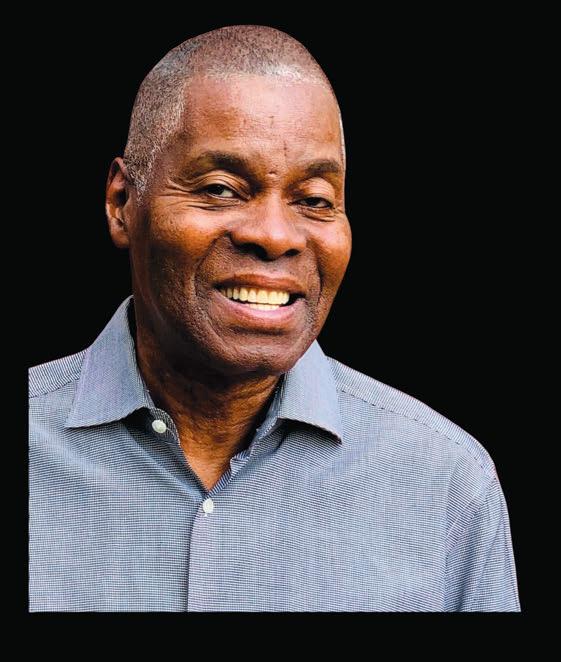



By Dana Rieck
The St. Louis American
St. Louis Mayor Tishaura Jones’ administration is seeking nine people to serve on the city’s inaugural Detention Facilities Oversight Board (DFOB).
The Board of Aldermen passed an ordinance Dec. 3 establishing the DFOB, which will review complaints of corrections personnel misconduct and detention incidents, direct investigations to the commissioner and submit recommendations regarding policy and procedures.
Applications are open to city residents now through Feb. 14 and applications will be reviewed on a rolling basis.
The oversight board was one of 13 urgent recommendations made by a task force assembled after several uprisings at the City Justice Center last year. The recommendations included things such as increasing dayroom recreation, implementing tablets for virtual visitation, upgrading the electronic security system and constructing maximum security gates and auditing the length of stay of current detainees. But creating a civilian oversight board for the corrections department was the task force’s highest priority issue, according to the task
force’s chairman, Rev. Darryl Gray.
“Detainees in city facilities must be treated with respect,” Jones said in a prepared statement. “After receiving recommendations from corrections task force representatives and visiting the facilities covered under this bill, I am proud of our work together with stakeholders to create this board to help ensure claims of injustice from within our detention facilities are taken seriously.”
Appointment to the DFOB requires nomination by either the mayor or chairman of public safety, as well as confirmation by the Board of Aldermen. The DFOB’s members are expected to be fair and objective; to act without bias or favor for complainants, detainees or employees; and make decisions based only upon the facts and the evidence before them.
“Many thanks to Mayor Jones and Public Safety Committee Chairperson, Alderman Joe Vacarro, for accepting the recommendation from the Corrections Task Force in creating the Detention Facility Oversight Board,” Darryl Gray wrote on Facebook in response to the application period opening.
In 2021, the City Justice Center experienced at least six detainee uprisings — all

blamed on faulty locks in the facility. The two most recent
occurred just before and on New Year’s Day. Each time,
—Mayor Tishaura Jones
uprisings were two in July that resulted in the transfer of about 140 detainees to an annex at the now-closed Workhouse.
The first two protests
the inmates refused to return to their cells in protest of inadequate protections against COVID-19 for those being held there.

worker – work with every patient at the ID Clinic. There’s also a phlebotomist, laboratory, psychiatrist, food pantry and pharmacy services available onsite. The ID Clinic specializes in treating patients with HIV/AIDS as well as those patients with HIV/AIDS and other medically complex conditions (e.g. hepatitis B, hepatitis C, pregnancy). The Clinic also helps reduce the number of new cases through its game-changing preexposure prophylaxis (PrEP) program – available in person or via telehealth – designed specifically for those at-risk for exposure.
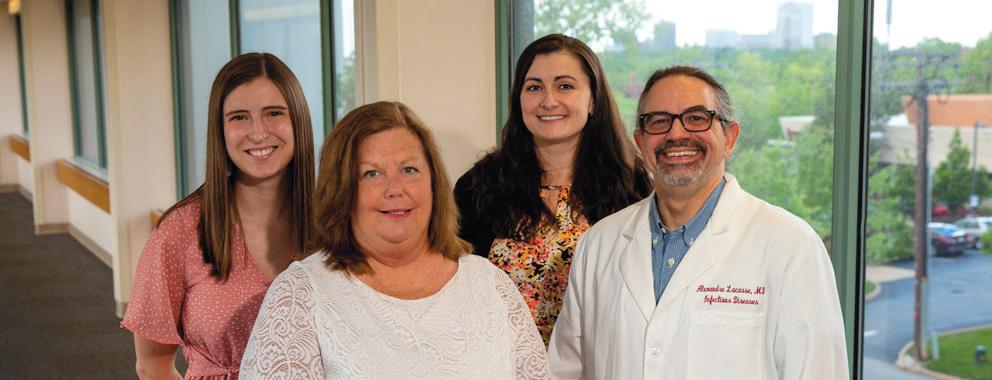
their disease with a commitment to compliance, regular monitoring, lab work, diet, exercise, and stress management. In fact, many ID Clinic patients have undetectable HIV viral loads, boosting the clinic’s undetectable rate to 10 percent higher than the national average. “We enjoy working with our patients, who become like family to us,” said Ewert. “We know each patient personally and want to see them succeed in
and Mary Creamer, MC, LCSW, licensed clinical social
“The key with every patient we treat is consistent monitoring –ideally, every three months; however, I have many patients who only come in every six months because their HIV is so well-controlled,” said Dr. Lacasse. The ID Clinic’s patients with HIV/AIDS successfully manage

of excessive and abusive use of pepper spray by corrections officers. An investigation by The St. Louis American revealed in March 2021 the city put in one order for as much pepper spray as it had purchased in the previous six years combined, for a total of $17,379.
Jones announced in August that an associate warden in Arkansas was chosen to take over as St. Louis’ new correc-
Then, in early February, inmates took over the north side of the fourth floor of the jail, breaking the windows and throwing debris down onto the sidewalk and street. The fourth protest happened on Easter Sunday and mirrored February’s uprising but on the third floor.
In addition to those, the jail faced two high-profile lawsuits. The first one, filed in March, alleged a 40-year-old City Justice Center inmate with paraplegia had not been provided a wheel-chair accessible shower in 160 days.
The second one in June outlined a variety of narratives of inmates who all complained

During the height of the Ferguson uprising in 2014, activist Montague Simmons spoke passionately before thousands of demonstrators protesting the killing of Michael Brown and the systemic racism that allowed his death to happen with impunity.
“We have to show them that the cost is too high,” Simmons said. He was absolutely right.
Yet while making an ethical case for equity is valid, another argument is more likely to resonate and garner the attention necessary to encourage systemic change from the powers that be: the economic cost of racism.
The data show that the economic cost literally is too high to continue racial inequity against Black people and the nation’s self-interest. The financial toll is far-reaching and impacts every American citizen, regardless of their ethnicity.
The moral expense of racism should be sufficient to upend the current power structures from their historical practices. But ours is a nation with power and wealth built on the foundation of unspeakable horrors involving people being sold as property and dehumanized in every way imaginable for centuries. And the current attempt at reconciliation for these crimes against Black Americans is to simply erase them from history books.
But systemic racism in the United States is not something in the distant past. It remains deeply embedded in the DNA of this nation. Granted, there have been some more progressive responses to these challenges in different regions of the country in recent years — particularly the death of Black people by police.
Slavery itself and the persistence of its successive forms of systemic racism make it clear that for many, the
moral fabric of America is an afterthought when the bottom line is involved. If we see chattel slavery in this country as part of larger class interests, we can better understand the ideas, ideologies, and institutions that undergird ongoing systemic racism.
Slavery in this country was monstrous and evil. But we must also understand that simply addressing the current manifestations of systemic racism as a moral imperative — no matter how important that is — will be futile if we cannot also make a convincing economic case for ending racial injustice.
The evidence is compelling and speaks for itself. A study released by Citi in September 2020 concluded that $16 trillion was erased from the U.S. gross domestic product over the previous 20 years due to racial discrimination in education, housing, wages, and business investments.
“Racial inequality has always had an outsized cost, one that was thought to be paid only by underrepresented groups,” said Citi vice chairman and report co-author Raymond McGuire. “What this report underscores is that this tariff is levied on us all.”
While the United States has always been a de facto multiracial country, it has never been a true democracy. The U.S. has always failed to address the harm done by its original sin — the enslavement of Black people — and its varied forms of ongoing racial discrimination despite its declared abolition after the Civil War. It has been Black Americans who have endured, and continue to endure, the brunt of this brutal, inhumane legacy.
The population of Black America currently exceeds 50 million. Yet it remains a largely untapped resource for the country due to systemic barriers that prevent the
realization of our full potential as a community. We are a fertile ground for greater innovation and excellence. But the nation has opted out of leaning more fully into the Black community so that the entire nation could reap from the harvest Black Americans would provide if given the opportunity.
Instead, the country smothers our fertile soil with concrete — maintaining roadblocks that undermine the contributions Black America could make in helping reverse our nation’s diminishing status as a world superpower n addition, a more recent study — a 2021 analysis by the Federal Reserve Bank of San Francisco — showed that racial and ethnic inequalities have cost the United States $51 trillion in lost output since 1990. This study cited persistent gaps in rates of employment, education, and earnings as the key drivers — and confirmed that these persistent gaps add up to a smaller economic pie for the nation as a whole.
The wealth of a nation was cited as justification for the morally bankrupt policies that kept Black people enslaved for centuries and denied basic human rights for more than 150 years after our alleged emancipation.
In his commentary “Slavery Was About Profit,” New York Times columnist Jamelle Bouie wrote, “The point I want to make is that we should not think of the slave system or the slave trade as somehow about racism and hatred. It was about profit. That’s why — and how — it lasted so long.” That same priority can be a powerful, sustainable determinant to help make America a place with greater access, opportunity, and equity for all. The cost of the failure to act is too high — and is a threat to the nation’s future in the increasingly competitive global economy.
“Granted, this is not the bigotry of torches and hoods. No, this rhetorical decoupling of ‘African’ and ‘American,’ of Black people from normal human functions, represents ‘only’ the bigotry of the implicit assumption, the things some people believe without consciously knowing they do — much less interrogating why they do. For them, white is the default position, the color of generic American-ness and truth be told, generic human-ness.” — Leonard Pitts Jr., Tribune Syndicate columnist Senate Minority Leader Mitch McConnell has done everything in his considerable power to enable the wave of racially motivated voter suppression that has swept through state legislatures since the 2020 election. He has led five filibusters against voting rights legislation this session alone. He continues to deny that voter suppression is a problem. And though there was little doubt about the reason it was jarring to hear him admit it so bluntly: Black Americans are not the same as “real” Americans.
(To send a Letter to the Editor to The St. Louis American, visit stlamerican.com or send your letter to editor@stlamerican.com) Making
onymous with “white.” That’s precisely why it’s been so easy for states to pass laws that make it harder for Black and brown people to vote. It wasn’t merely that Donald Trump lost that fueled the rage of the Jan. 6 insurrectionists. It was that Black and brown votes were a major factor in that loss. Trump won most white votes and for far too many, including some at the highest levels of state and federal government, those are the only votes that should count.
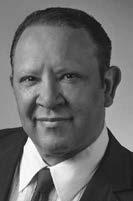
“African American voters are voting in just as high a percentage as Americans,” McConnell blurted in response to a reporter’s question about his obstructionism on voting rights. More than a century and a half after the 14th Amendment granted Black Americans the full rights of citizenship, many still implicitly — and explicitly — consider “American” syn-
The implicit racism of McConnell’s phrasing aside, his statement was blatantly false. Only twice in U.S. history did the Black voting rate meet or exceed the white rate: 2008, and 2012, when President Obama was elected and reelected. In 2013, the U.S. Supreme Court gutted the Voting Rights Act with its decision in Shelby County v. Holder, opening the floodgate for voter suppression in states and counties previously covered by the preclearance provisions of the act.
Within 24 hours of the ruling, Texas announced that it would implement a strict photo ID law. Two other states,
Black people deserve fair share of American Dream
By Charlene Crowell

Regardless of locale, profession, or income, every family needs and deserves a home. But for many – especially Black Americans and other people of color — finding and maintaining affordable housing is increasingly difficult. New research documents not only escalating rental costs, but how Black American efforts to buy affordable homes are blocked by high denial rates nearly double that of white consumers.
While it is encouraging that this new research documents real-life bargains and locales to access the American Dream of homeownership, mortgage lenders must clearly account for their reasons to deny Black Americans owning their own piece of America. The longstanding racial homeownership gap is today only 43% for Black households – 30% less that of white households at 3%.
Further, as long as Blacks are forced to struggle with rising rental costs, these same families are denied the housing cost containment of a fixed-rate mortgage, as well as family stability, and the wealth-building that accrues to homeowners. Despite unprecedented
federal housing assistance during the pandemic, a report by Harvard’s Joint Center for Housing Studies (JCHS) finds stark racial and income divides in its analysis of the nation’s rental market. Nearly a quarter of Black renters were behind on rent in the third quarter of 2021, as well as 19% of Hispanic renters. By contrast, the share of white renters in arrears was half that: 9%.
“This disparity reflects long-term discrimination in labor markets that has consigned many households of color to low-wage jobs in the service industry,” says Chris Herbert, Managing Director of the Joint Center for Housing Studies (JCHS). “And this sector suffered the most drastic employment cuts over the past two years, which has only compounded existing inequalities.”
The term, ‘rental affordability’ is a ratio of monthly housing costs as a percentage of household income. Researchers, lawmakers and other housing stakeholder groups, consider affordable rent to cost no more than 30%. For homeowners, this ratio must also take factors other than the mortgage payment into consideration.
Property taxes, homeowner’s insurance and the required private mortgage insurance for small down payment home purchases, must also be included in the calculation.
But with low rental vacancy rates in most metro areas, rental increases are widespread, and ‘affordable’ rentals are in short supply. The number of units
Congress should put children first
I agree with Sarah Miller’s letter asking the Senate to renew the Child Tax Credit (CTC) extension. (“Senators must pass CTC extension,” January 25, 2022) Unfortunately, Senators Roy Blunt and Josh Hawley didn’t listen to her.
Mississippi and Alabama, also began to enforce photo ID laws that had previously been barred because of federal preclearance.
In the 2014 midterm election, the first after Shelby, Black voter turnout lagged white turnout by almost four and a half percentage points.
Historically high Black and brown voter turnout in some jurisdictions did help swing the 2020 election, but nationally the Black rate lagged the white rate by seven percentage points.
But even if Black Americans had voted “in just as high a percentage as [white] Americans” in 2020, legislators across the county, including McConnell, are working overtime to make sure that doesn’t happen in 2022 and beyond. In 2021, at least 19 states passed 34 laws restricting access to voting, according to the Brennan Center. At least 13 bills restricting access to voting already have been pre-filed for the 2022 legislative session in four states and 152 restrictive voting bills in 18 states will carry over from 2021.
Senator McConnell knows all this. He knows that he holds the power to put a stop to it, and he refuses. We don’t need to hear him suggest that Black Americans aren’t “real” Americans to know where his loyalty lies.
Marc Morial is president and CEO of the National Urban League.
Last year, expansions to the CTC kept over three million children out of poverty every month from July to December. Payments sent out monthly allowed families the flexibility to spend the aid on expenses they needed most. But just when children and families faced additional financial troubles from the COVID-19 Omicron surge, the Senate failed them when they did not extend the payments in the Build Back Better plan.
We need to put our children first. I call on
renting for less than $600 fell by 3.9 million between 2011 and 2019, the JCHS report found. And the 7.2 million renter households headed by a person age 65 and over is expected to continue rising over the next two decades.
In its 2022 Rental Affordability Report, ATTOM, curator of a national property database, found that paying a monthly mortgage on a medianpriced home is more affordable than the average rent on a three-bedroom property in 666, or 58%, of the 1,154 U.S. counties analyzed for the report.
“Home ownership still remains the more affordable option for average workers in a majority of the country because it still takes up a smaller portion of their pay,” said Todd Teta chief product officer with ATTOM.
The Urban Institute’s new analysis of the annual Home Mortgage Disclosure Act compares the race and ethnicity of those denied mortgages in 2020 for purchase loans as well as home improvement and refinance loans. In each of these loan types, the largest gaps in denial occurred between Blacks and whites. Instead of being locked out, it is time to bring the benefits of home equity and wealthbuilding to more families. Black America must have its fair share of the American Dream.
Charlene Crowell is a senior fellow with the Center for Responsible Lending.
our senators as well as Reps. Clay Wagner, and Luetkemeyer to find a new way to extend the expanded CTC for all low-income children and resume the monthly payments as soon as possible.
Cynthia Levin, Town and Country
Correction
In the Health Matters
story that ran in the Feb. 3, 2022, edition of the St. Louis American, quotes made by CEO Angela Brown of the St. Louis Regional Health Commission, were accidentally attributed to Washington University Physician Dr. Angela Brown, including the photo caption.





St. Louis American staff
North County Inc. (NCI) will host its 45th Annual Leadership Breakfast 7:30- 9:30 a.m., Friday, May 6, 2022, at the Marriott St. Louis Airport.
The organization is inviting nominations for exemplary business, civic and community leadership awards for those who work in North County. Nominations are due Feb. 25, and honorees will be recognized at the event. To nominate a worthy candidate(s) for an award go to www.NorthStLouisCounty.com
The Leadership Breakfast will also highlight current initiatives under way that are helping to enhance the region’s growth and quality of life, according to NCI President and CEO Rebecca Zoll.
“Our Annual Leadership Breakfast is an opportunity for NCI to recognize the many professionals, businesses and others who are making a powerful impact in North County,” Zoll said in a release.
“There are very positive developments and work happening in the community, bringing our leadership together to celebrate this growth is always fun.”
Award categories include: Elmer Belsha Leadership Award is presented to an
individual who has had a positive impact on the North County community.
Business Development Awards are presented to those whose efforts have positively affected the economic development and business climate of the North County area.
Community Development Awards are presented to those whose efforts positively benefit youth, residents, civic organizations, or others through selfless acts.
Public Service Awards are presented to individuals, elected, appointed, or employed by a public body whose long-time service has had a positive impact on the community and/or public body they serve.
Diversity and Inclusion Awards recognize individuals or organization displaying exemplary dedication to diversity and equity initiatives while promoting a culture of inclusion.
Founded in 1977, North County Inc., is an economic and community development advocacy organization that focuses on education, health care, infrastructure, and transportation, according to its website.
NCI builds “collaborative partnerships and coordinates resources and efforts of civic and business leaders to speak as a unified voice on regional issues.”
By Sonny Messiah-Jiles
February is Black History Month, even though we as Black folks experience our history every day. Yet, Across America, white conservatives, including governors who want to be president, are using the critical race theory controversy as camouflage to promote a false narrative of white history and minimize Black history.
Could it be that with the growing population of people of color in America, this campaign against everything except a white worldview of history is not just a ploy to avoid guilt or shame but a strategy to demean and disempower people of color as they grow in number?
As early as the 1920s, Carter G. Woodson, recognized by many as the “Father of Black History,” stressed the importance of filing the glaring hole in the United States’ educational system. When you read his words, Woodson spoke truth to power in his book, “The Mis-Education of the Negro.”

“The present system under the control of the whites trains the Negro to be white and at the same time convinces him of the impropriety or the impossibility of his becoming white… the Negros will have no outlet but to go down a blind alley, if the sort of education which they are now receiving is to enable them to find the way out of their present difficulties.”
If you teach the Negro that he has accomplished as much good as any other race he will aspire to equality and justice without regard to race. Such an effort would upset the program of the oppressor in Africa and America. In our public school system back then —as is still the case in some school districts across the United States — there was almost no Black history taught.
As I read more quotes from Woodson’s book, I reflected on my own life journey. My dad was a World War II veteran confronted with racism but who cashed in on the benefits from a GI-funded education at Prairie View A&M University. He met my mom in college. They married after graduation and began their life as educators in the Goose Creek School District in Baytown, Texas, just east of Houston. As the oldest of three children growing up in Baytown, I saw the struggles of my parents in a system that was allegedly equal but was, in reality, fundamentally unjust, and unequal. When the integration of schools came along, I was selected as one of a handful of students to integrate Highlands Junior High. That first year was a hard test for me and my parents as my mom gained a reputation as a Black woman who did not take stuff from anyone. When it came to treating me fairly, that school and those teachers learned you’d better not mess with her child.
In our public school system back then —as is still the case in some school districts across the United States — there was almost no Black history taught except for mentions of George Washington Carver or Frederick Douglass.
When I got to college at North Texas State University, I joined the student movement in protest of no African American Studies on campus, which led me to join the Black Panther Party, where I headed the Breakfast Program and Liberation School for the Dreamland Project kids. There, I witnessed Black children blossom like flowers absorbing sunlight. I saw that learning Black history builds self-pride and self-esteem, which equates to selfconfidence and self-worth.
Granted, we should continue the fight to educate our white colleagues and their children about the true history of this nation, but our top priority should be to educate Black children and build them up. It starts with us — parents, other concerned citizens, and institutions — creating programs to empower our children with our Black history. Woodson’s words of wisdom reinforce this point:
We can’t wait for white politicians to give the green light to critical race theory, or to teaching the truth about who Black people are and how we built — and continue to build — this country.
Sonny Messiah-Jiles is CEO and Publisher of the Defender Media Group in Houston.

Continued from A1
Melvin, Nona and Paul). As the story goes, George, a peripatetic entertainer, ran off leaving Julia May with nine kids when Betty was a baby; and Julia May divorced him. Julia May, a raven-haired beauty, caught the eye and heart of a kind man named Charles Thomas Pulliam who married her and helped her raise her nine children. Tom, as he was called, was a man of few words who saw no reason to contradict Julia May publicly; she and her children would never want for anything, materially, under his roof.
Betty at five
As a young mother, Betty repeated stories to her children (Donald M. Suggs, Jr. , Dawn M. Suggs and Dina M. Suggs) that illustrated their family history, matrilineally, and their mother’s lust for life at a very young age. Betty would later go on to become an award-winning Toastmasters speaker after her children went away to college. Even during the last decade, while residing at a nursing home in North St. Louis, Betty, though wheelchair-bound, traveled to community centers to speak publicly and entertain other seniors.
One of the most delightful stories Betty shared with her children was about her neighbor’s garden. “When I was a little girl, there was a neighbor who had this beautiful, immaculate, garden made up of tulips. I admired this garden so much that one day I took my little bucket and shovel over to the garden and picked every single flower in it, all while singing [a popular song of the day], “I love coffee, I love tea, I love a java java, it loves me.”
“You didn’t leave any flowers?” her children would ask.
“Not a one,” she confirmed shaking her head and still surprised at her own gall as a five-year old. “Oh my mother gave me such a whooping,” she added.
Passing
A particularly painful
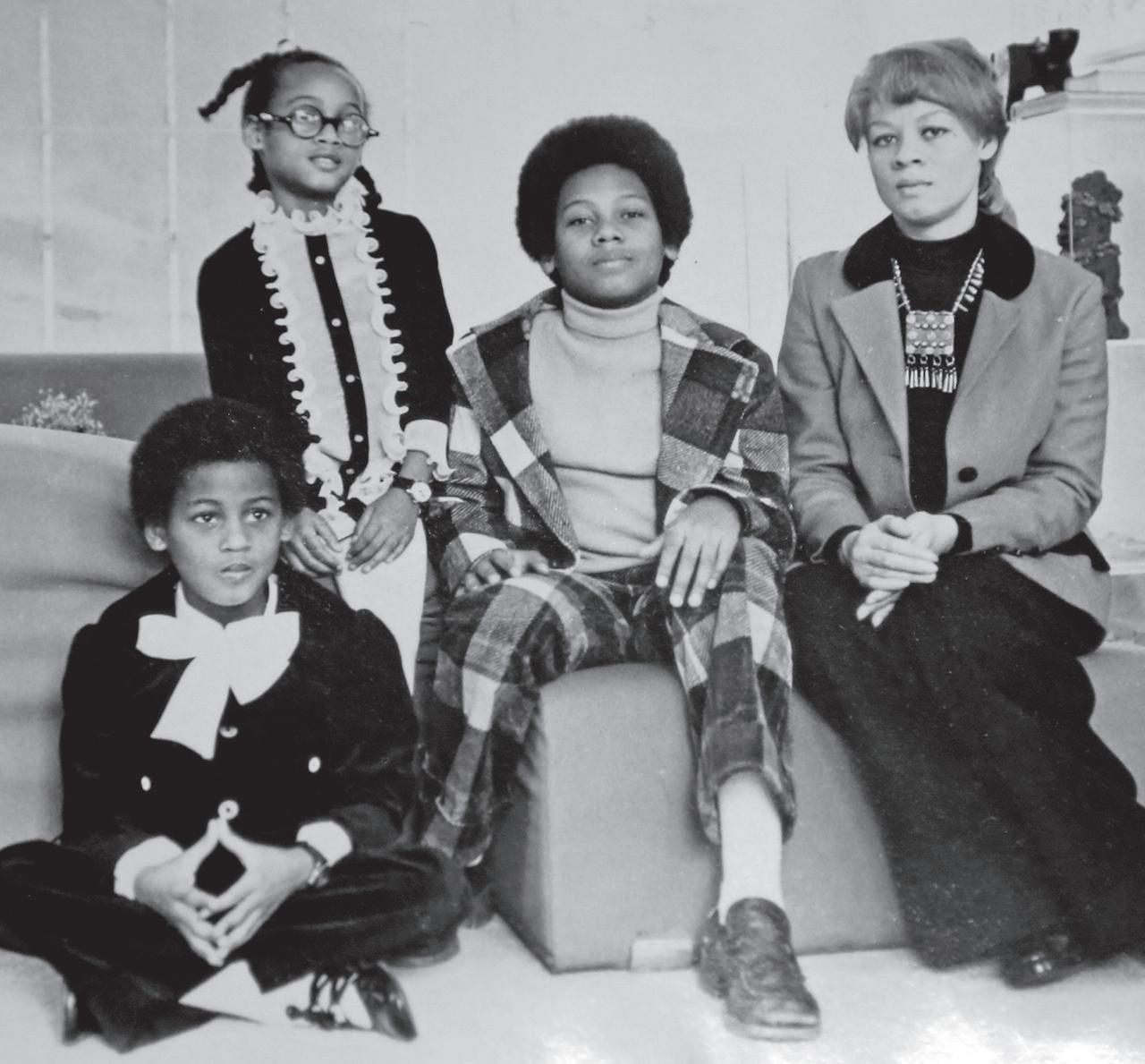
aspect of her childhood was being compelled “to pass” as white when her family went on road trips and ran out of food. “Oh, I hated that,” she sadly recalled. “I was terrified as a child, walking into segregated diners to buy food for my family. What if they could tell I was Black?” She was the fair-skinned baby of the family tasked with something hard for others to fathom. What kind of damage might it do to one’s soul to be cajoled and coerced to pass for another race, to be separated from one’s family, to be cast out, then let back in based on convenience? Betty would become highly annoyed as an adult, and she’d check anyone who called her anything, but “Black.” Her phenotype could be interpreted otherwise, by white folks, but she was quite clear on who she was having been raised by
Black folks in the segregated Midwest. She was Black, her culture was Black, her features were Black, and she thought no better or worse of herself as a Black woman with fair hair and fair skin.
“I loved my school. I loved my teachers”
While there was a school located three blocks from her home, Betty was bused to an all-Black school in Indianapolis, School #42. All of her teachers there were masters and Ph.D.-educated and she felt blessed to go to that school. Those teachers instilled in her respect for educators and elders. She recounted that her teachers loved their students and vice-versa; and Betty believed it was this experience that led to her decision to become an educator.
One summer, Betty was cast as the lead in Cinderella and won a prize, the book Pinocchio, for her performance, She was proud of her accomplishment, but wished she’d received a different book because she’d already read Pinocchio. She read everything that she could. Young Betty often “snuck” books into bed and read them late at night with a flashlight. In a 2019 interview at her nursing home, she had this to say about her passion for reading, “With eight siblings, there was always drama in the home, it was the only way to get away from it.”
Indiana U. Betty studied ballet, and joined a dance troupe at her alma mater, Indiana University. There, she joined the Alpha Kappa Alpha sorority and met

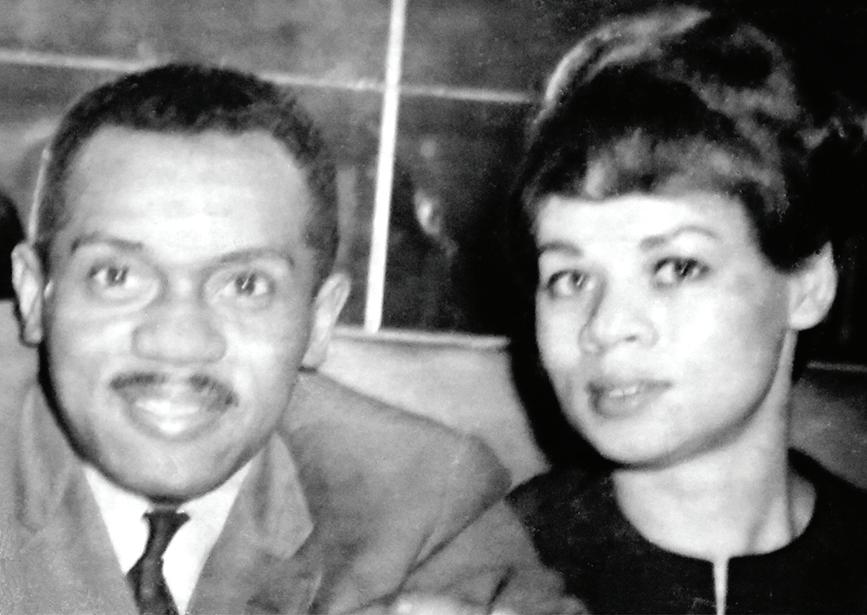
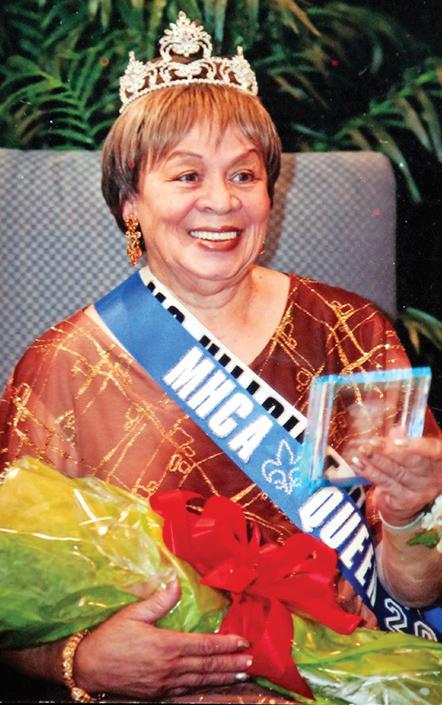
an ambitious upperclassman by the name of Donald Suggs at a basketball game. In the 2019 interview, she detailed the meeting: “A fella was there flirting with me; he was friends with [my future husband] Donald. That fella was bothering me and I ignored him. That night my future husband called me on the phone to apologize for the other boy bothering me, then asked me out on a date. I was a sophomore in college at the time. We dated until I graduated and were married in August of 1956.”
From Dover to St. Louis
Donald sought training as an oral surgeon after his graduation from the Indiana University Dental School and was accepted for a program in New York City. He subsequently turned it down to go to St. Louis to train at the legendary hospital, Homer G. Phillips, which was led by Blacks. Betty said, “St. Louis was noted for having [Homer G. Phillips Hospital] one of the finest medical hospitals in the United States.”
They spent two years in St. Louis before Donald left to serve a couple of years in the U.S. Air Force, in Dover, Delaware, where their first child, Donald, Jr., was born. They became enamored of the East Coast and planned to make their home in Washington, D.C. after leaving the military, but they were seduced into returning to St. Louis when Donald was offered a position at the now defunct Washington University Dental School where he was the first African American to take graduate courses. He would have been the first African American on the faculty, if the offer wasn’t abruptly rescinded after they’d already re-settled. Donald worked as an anesthetist for a few years at Homer G. Phillips before he opened a private practice in North St. Louis, as the first Black licensed oral surgeon in the state.
They remained in St. Louis where both daughters, Dawn and Dina, were born. Donald later accepted a teaching position at St. Louis University. He enjoyed teaching almost as much as his wife Betty, who received her masters in teaching from Webster University. She taught elementary school in St. Louis and would later teach at the college level at University of Missouri – St. Louis. Budget cuts ruined Betty’s opportunity for tenure, so rather than accept a night teaching position, she dedicate herself full-time to raising her children. Betty continued what would amount to 40 years of volunteer work, including giving tours and lectures as a docent at the Saint Louis Art Museum. She fundraised for the YWCA and YMCA, and became the top phone solicitor for the Saint Louis Symphony Orchestra in the late 80s. In the early 90s, she worked in classified advertising at The St. Louis American. After her children entered middle school and high school, she
Betty
was crowned Missouri Health Care Association Queen in 2009 after winning the Queen of Nursing Homes
volunteered at the bookstores of their schools, Country Day (later known as MICDS) and John Burroughs School, before her daughters went to boarding schools in Massachusetts. Betty and Donald’s marriage ended in 1984.
Teaching kindness
Dawn and Dina remember their mother Betty as stalwart about progressive education and values. In the 70s, their mother created a moving puppet show for young children featuring puppets with “disabilities”. She performed in St. Louis public schools to sensitize children and encourage them to respect and show kindness to people of all abilities.
Ageless St. Louisan Later in life, Betty won a local nursing home pageant competition for seniors in St. Louis, then advanced to the state competition and was crowned “Queen” of the Ms. Missouri Nursing Home pageants. Betty regularly worked at election polling sites in St. Louis, taught seniors how to read, worked for Habitat for Humanity and proudly served as a member of the SilverHaired Legislature in Missouri, and as a liaison for her nursing home to the Northside Action Association. Based on her dedicated service to seniors, she was honored as an “Ageless Remarkable Saint Louisan in 2014.”
Betty became the proud and loving grandmother of Delali Suggs-Akuffu, her only grandchild, in 2008. In a 2019 interview, Betty stressed, “Parents and teachers showing kindness to others is extremely important in life.” She modeled this, even in the most trying times of her life. Her unique spirit, panache and dynamism, could still be witnessed in performances as recently as 2018 when she performed a tap dance from her wheelchair, dressed-up for the Halloween talent show at her nursing home. She brought down the house.
Her final days were filled with a deep outpouring of love and attention from family and exceptional caregivers at Laclede Grooves nursing home in Webster Groves. She left this world, as she lived her remarkable life, with dignity and grace.
Donald Suggs, Jr., her first child, preceded her in death in 2012. Betty is survived by daughters Dawn M. Suggs and Dina M. Suggs, granddaughter Delali Suggs-Akaffu and many nephews and nieces. Funeral services were held privately.
Those wishing to honor Betty can make a donation to the Easterseals Black Child Fund that serves St. Louis, Missouri and other communities by addressing racial disparities in healthcare among young Black children with autism and other disabilities. https://secure.easterseals.com.
Continued from A1
“We are parents who have witnessed the district take on a number of challenges over the years with noted success and we recognize the importance of investing in students, including our most vulnerable, and not taking money away from them,” she added.
In addition to protecting the $18 million, the group also sought to “raise awareness of the good work being done at SLPS in support of students.”
“We’re going to stand strong, and we have everybody from entrepreneurs to attorneys to teachers themselves here, and they want to stand up for public education,” said SLPS parent Gloria Nolan
“We keep watching. We write letters. We call. We keep showing up again and again to make sure they know public education and democracy is important to us and it’s important to the city of St. Louis.”
Jennifer Boudreau, an SLPS parent, said she was “proud to be standing with an awesome community of SLPS parents and students to tell our legislators about the great things happening in our district.”
According to an SLPS release, “Over the past 13 years, SLPS has established a record of accomplishment, fiscal responsibility, and accountability. Over time, support services have been expanded and additional services added as the needs of students and families.”
“The district works hard to meet the individual needs of all students and does so with what is now a years-long record of impeccable financial responsibility.”
Continued from A1
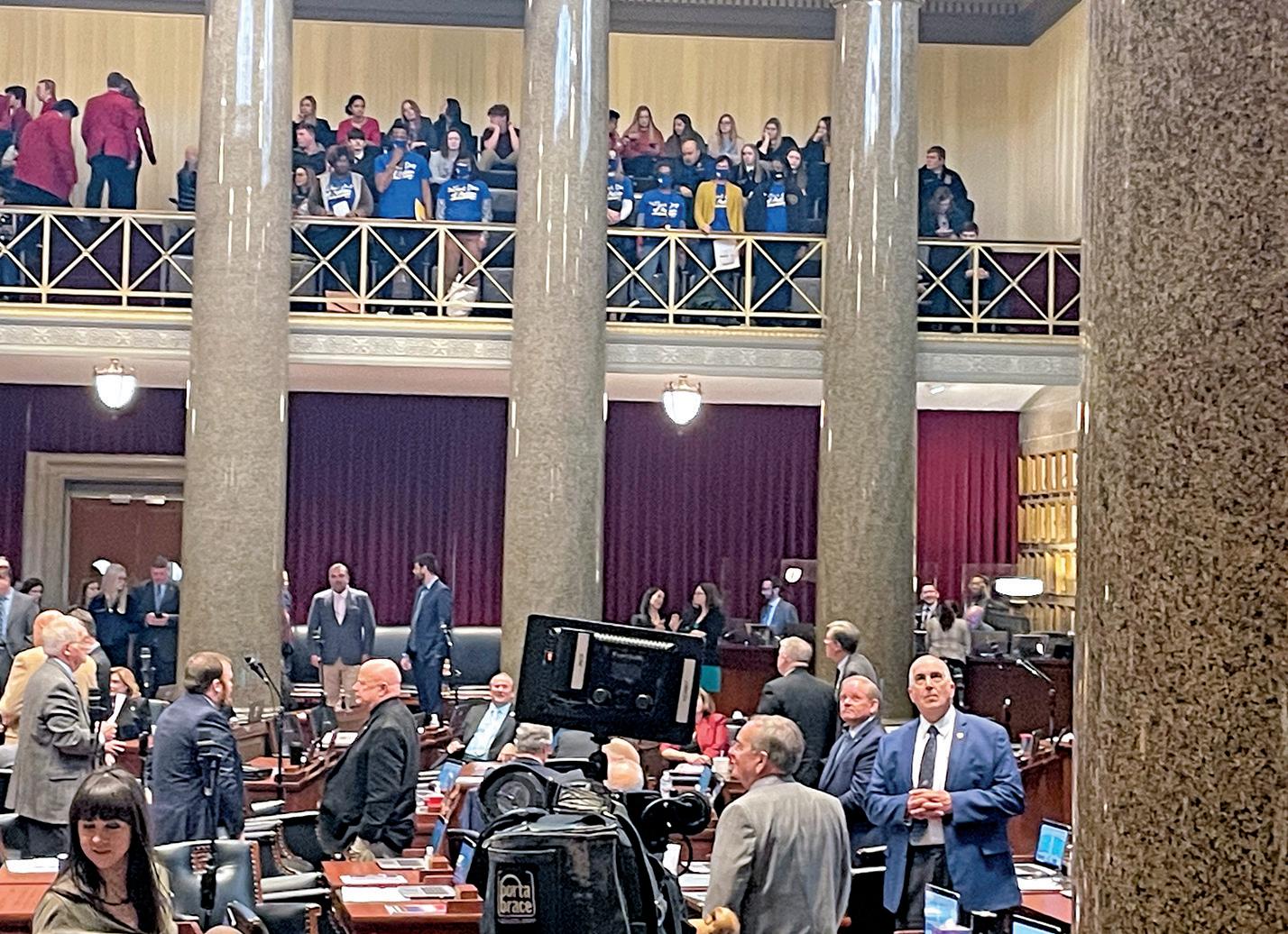
A delegation from St. Louis Public Schools watches proceedings during Wednesday’s legislative session in Jefferson City. The group traveled to the state Capitol to back the district and voice opposition to a pair of bills that could reduce its funding.
In addition, a proposed constitutional change backed by GOP legislators could allow the Legislature to make annual appropriations for Medicaid, or simply not to fund the expansion.
Adults between the ages
Continued from A1 been eligible under the old system.” Republican legislators moved a bill to the House floor on Monday that would include a work requirement for people eligible for Medicaid. The Biden administration has repeatedly said it will not approve any work requirement legislation.
the next chief and selected six finalists, rejecting the majority of 30 people nationwide who applied for the position. He then administered a written test to two internal candidates, who are both white, but did not administer a virtual version of the test to the other four outof-state candidates.
“I only had two white male candidates to choose from and St. Louis is more diverse than white males, our police department is more diverse— there were a lot of diverse candidates within the police department who were kicked out of the first round so I want to start over to find the right candidate,” Jones previously told The St. Louis American The mayor also told The American at the time she wanted the new search to start after appointing an interim personnel director but did not provide additional details.
Hayden announced in January he postponed his February retirement date as the search for his replacement continued.
According to the mayor’s office, Moten has served on search committees for St.
of 19 and 64 who earn up to $17,774 a year, or $36,570 for a family of four are eligible for Medicaid. There is no cutoff date to enroll in this insurance program.
Enrollment has been slow as only 25% of newly eligible Missourians have signed up for Medicaid. Williams believes this is due to the lack of education from the state.
“I don’t think the state has done an efficient job on making it clear on how to enroll; we encouraged people last July to enroll,” he said. According to Show Me Coverage, Missouri enrollment is already higher than it was at the end of Open Enrollment last year. 92% of Missourians enrolling in Marketplace insurance are qualifying for dis-
Louis Community College president, the Missouri Commissioner of Education and St. Louis Public Schools superintendent.
He has also served as chair of the Missouri Commission on Human Rights (MCHR), which develops, recommends and implements ways to prevent and eliminate discrimination through enforcement of the Missouri Human Rights Act.
The Department of Personnel handles all civil service hiring for the city, producing lists of candidates from applications and passing on to departments for interviews and final selection.
Moten worked at Laclede Gas for 40 years, entering the company as chief chemist in 1962. He became senior vice president of operations and marketing in 2001, where he oversaw 2,000 employees.
Since 2003, Jones’s office said he has provided leadership training and consulting services to clients including Wells Fargo Advisors, Emerson, the Deaconess Foundation and the St. Louis Regional Health Commission.
He earned a bachelor’s degree from Morehouse College and attended Washington University in St. Louis’ School of Chemistry.

counts, up from 80-85% from previous years, according to a statement.
However, with the slow enrollment number, there is a question of whether the state is making it clear on how those newly eligible for Medicaid can enroll.
“There have been so many confusing messages on whether or not they will be eligible for it, whether or not they can or cannot apply for Medicaid,” Williams said. “We have a lot of conflicting messages out there and to let politicians here
in Jefferson City move the goal post every year has only contributed to the chaos.”
The bill in question would restrict access to Medicaid rather than affording access to hundreds of thousands of Missourians.
“That’s the real reason why it’s a mess and in return it’s making Missouri less healthy, less safe and less prosperous,” he said. “These people are working and shouldn’t be bullied with bureaucracy and ranting.”
Rep. Peter Merideth, D-St.
Louis, told Missouri News Network the effort is another attempt to reverse the will of Missouri voters.
“It makes me angry, and it makes me tired,” he said.
“Every step of the way, (Republicans are) just trying to fight against the people and against everybody, against common sense.”
Rep. Sarah Unsicker, D-Shrewsbury, Democratic Caucus policy chair and a member of the House Subcommittee on Health Care Reform said a work requirment
could be costly to the state.
“It would block up our entire Medicaid program because work requirements would still be in the constitution, so we would have to do them because that’s what the constitution says,” she said.
“But (the Centers for Medicare & Medicaid Services) wouldn’t authorize it, so they wouldn’t give us the federal Medicaid match. That would leave Missouri on the hook for the 90% of the Medicaid budget funded by the federal government.”

By Stacy M. Brown NNPA Newswire
On the first anniversary of the Biden-Harris administration, the White House teemed with dignitaries, guests, and what appeared a larger press corps.
While that and the enormous Secret Service presence blocking off about a five-block radius on and around Pennsylvania Avenue wasn’t unusual, there remains something different –perhaps even special – about the 46th President and his staff and cabinet.
“Representation matters.
We’ve seen that from the first day of this administration, the President signed an executive order to deal with racial inequity and making sure that we saw diversity and inclusion across the board in the federal government,” said White House Principal Deputy Press Secretary Karine Jean-Pierre.
On January 20, the first anniversary of the Biden-Harris administration, Jean-Pierre sat down with NNPA President and CEO Dr. Benjamin F. Chavis Jr., for a wide-ranging discussion.
The discussion will be part of a 2022 Black History Month broadcast on PBS-TV stations across the nation and PBSWorld’s “The Chavis Chronicles,” and will include a focus on the successes and vision of the Biden Administration. It also highlighted what the President and Vice President are doing to resolve issues like voting rights, police brutality, diversity, equity, and inclusion, and repairing America’s reputation abroad after four years of Donald Trump’s divisive administration.
With a light-up-the-room
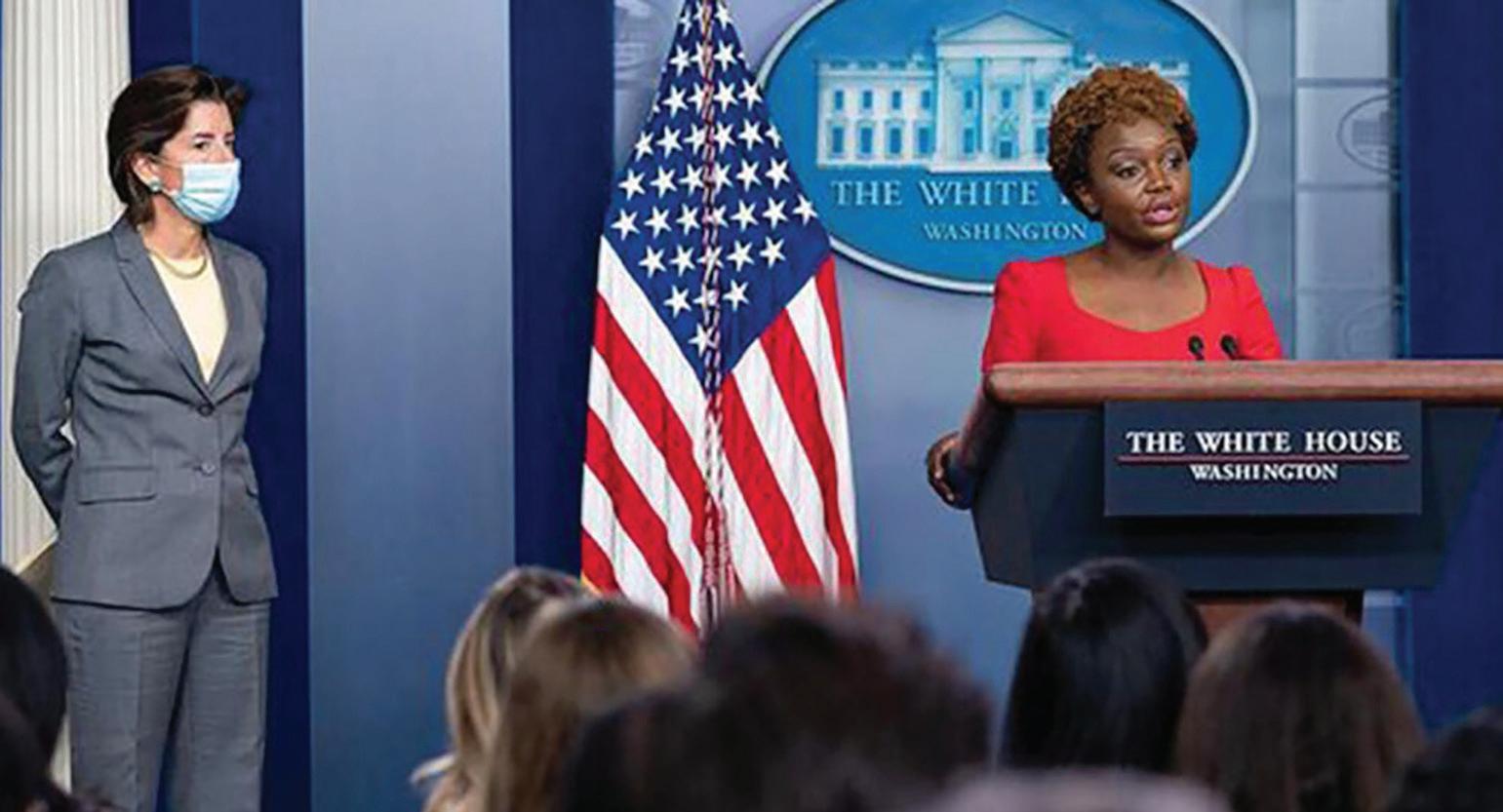
smile and oozing with confidence, Jean-Pierre might best exude why it might just be a matter of time before this White House earns the respect of the world.
“We’re living in a polarized country right now, and the one thing that President talked about when he was running, he wanted to make sure that he was the President for all,” JeanPierre remarked.
Jean-Pierre struck a confident tone despite strong GOP opposition to the administration’s policies and a media that relentlessly highlights any shortcomings.
“It will take more than a year to get to the other side of that so it’s not so polarizing and so we can actually get our mes-
sage through to the American people,” Jean-Pierre insisted.
She understands adversity but also embraces perseverance.
At 44, Jean-Pierre has a unique window into politics and movements.
And nothing was handed to her.
Facing a hard-knock life in their native Haiti, Jean-Pierre’s parents gave birth to their daughter in Martinique and immigrated to the United States when she was a small child.
Her father took a job as a New York City cab driver, which he still does part-time today. Jean-Pierre’s mother began working as a home healthcare aide, which she maintains.
“My parents came here looking for a better life,” Jean-Pierre
reflected.
“They heard of the opportunities here, but it was a Catch-22 because you came here for opportunities, and you also come here as a Black family,” she continued.
“It was very hard for them and they — like so many families across this country — lived paycheck to paycheck.”
But unmistakably, JeanPierre knows how proud her parents are that their daughter has accomplished so much, even making history last year as just the second Black woman to take the podium and lead a White House press briefing.
“It was truly an honor, and one of the things we all recognize and say is to not to forget the shoulders that we stand on,
and I certainly remember Judy Smith, [the first Black woman to lead a White House briefing],” Jean-Pierre stated.
“I wouldn’t be in this position, but President Biden made that decision to put me in this administration. To do the work that we are doing makes me so proud and knowing that I have so many folks out there who are proud of me.”
In many ways, her parents feel they’ve reached their dreams through her, Jean-Pierre offered.
“They came from an impoverished country but left to get a better life for their kids. For them, they are so proud of me, and they feel they have reached their dream because of my successes, but without them, I
Cabinet Secretary Gina Raimondo (left) visited the White House to join
Principal Deputy Press Secretary Karine Jean-Pierre for a press briefing to discuss the bipartisan Infrastructure
wouldn’t be where I am,” she acknowledged.
“They told me I could be whatever I wanted to be, do whatever I wanted to do.”
While her parents encouraged Jean-Pierre to become a doctor or lawyer, she worked in politics in New York, served in the Obama administration, and was a spokesperson for MoveOn, the advocacy and political action group.
Jean-Pierre also taught campaign management at Columbia University’s graduate level for nearly six years. “I’ve seen it all,” she declared.
“Even when I was teaching, my students would ask how I got to work at the White House. I tell them to follow your passion, what you believe in, and it will all come together if you do. So, keep following and believing your heart and what excites you every morning, and what you believe is making change.

By Jonathan Ahl St. Louis Public Radio
Dr. Mati Hlatshwayo Davis, St. Louis health director, said Missouri’s approach to public health is making it harder to fight COVID, especially in nonwhite communities.
During a Washington University virtual panel discussion on COVID-19 and racial equity Tuesday, Davis said Gov. Mike Parson allowing the public health emergency to expire and Attorney General Eric Schmitt suing schools over mask mandates are making it harder to keep pandemic numbers in check.
She also said Missouri has a longstanding history of underfunding public health.
“And with that trickle down to local jurisdictions it means we have very limited budgets to do this work, and we have staff that are underpaid and overworked and are burnt out so we cannot do effective implementation of these strategies,” Davis said. Davis and her fellow panel members said those problems are felt more severely in communities of color because the health care system denies them equal access.
“These communities didn’t even have equal access to masks,” said Angela Brown, CEO of the St. Louis Regional Health Commission. “And when they did have access, they were priced out of reach.” Brown said that scenario played out for a second time when health officials recommended N95 and KN95 masks during the surge of the omicron variant.
“They finally got the surgical masks down in price. On
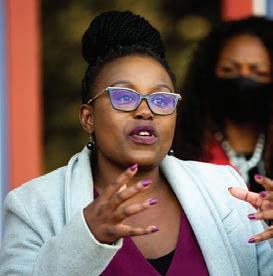
Photo by Brian Munoz/St. Louis Public Radio
Dr. Mati Hlatshwayo Davis, St. Louis Department of Health director.
Amazon they were 100 for $10. The N95s started at $50 for 25 masks,” Brown said. “That definitely priced people out.”
The disparity between nonwhite and white communities is further evidenced through vaccination rates of children, Davis said.
According to the Health Department, among vaccinated children in St. Louis between the ages 5 to 11, 80% of them are white compared to only 20% who are Black.
Davis is concerned that will get worse with the expected FDA approval of a vaccine for children under 5.
“Now knowing that we are going to have this new age group that is likely going to be approved within the next week, this disparity is only going to widen because I think we will see the same patterns,” Davis said.
Davis said her office is working with minority doctors, public health groups and faith leaders to narrow that gap.
We are studying how the pandemic has affected Black allied healthcare workers at home and work

Study sponsored by: Washington University in St. Louis Black Nurses Association
2-part opportunity: In-depth Interview: Receive $90 e-gift card and/or Online Survey: Enter to win e-gift cards $25-$75
Interviews are about 1 hour; can be in-person or on Zoom
To be eligible participants must: be 18 years or older
identify as Black
live or work in the greater St. Louis area
work in home health care; or support care in assisted living or a hospital setting
More info: https://sites.wustl.edu/healthworkerproject/
Sign up with the QR code below to let us know you are interested or want more information. Or contact the team directly at:
Email: ahcw.covid.study@wustl.edu
Phone: (314) 312-3617



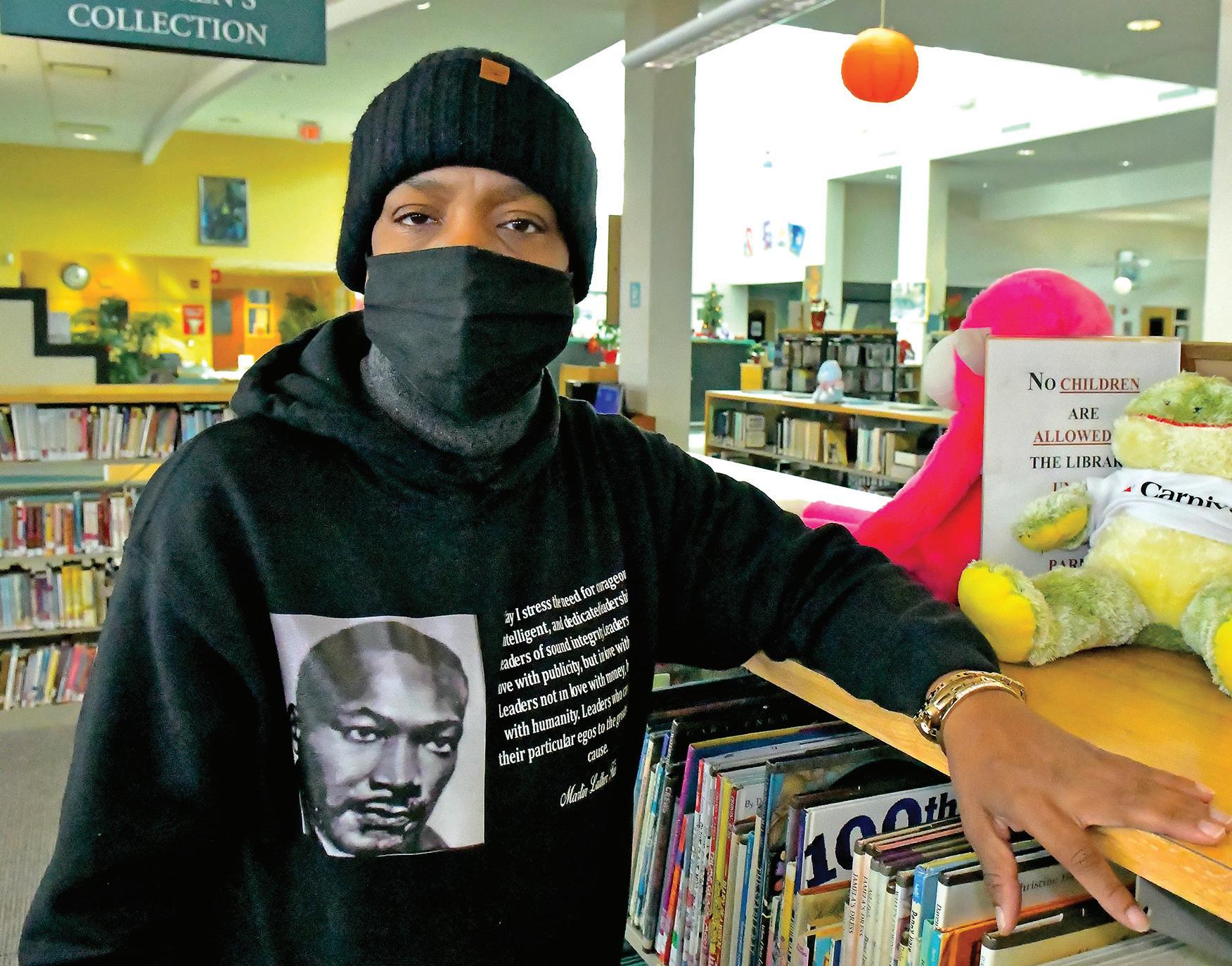
an elementary
Randle.
By Sylvester Brown, Jr.
The St. Louis American

Marshata Caradine-Randall, an educator, and East St. Louis resident, hasn’t been in a classroom since September. That’s the month she contracted the coronavirus. It’s also when her husband, Tarlvin Randle, passed away three days after he was diagnosed.
Marshata, who’s been recovering, grieving, and trying to piece her and her two daughters’ (ages 14 and 15) lives back together, says she’s ready to get back to work. She described her job at Patrick Henry Elementary in St. Louis as an “individual
n “Somebody has to be in those buildings for our children...”
– Marshata Caradine-Randall, Elementary School Teacher
care aid who advocates strongly for inner-city children.”
The first part is official. The second part, advocating for urban youth, is her passion, especially during the pandemic.
not-so-subtle insult to the offspring of generational poverty or as she calls it, “legislated poverty.”
“This is what it’s like to just be poor and Black in America,” Marshata said. “For those of us who’ve been legislated [into] poverty, we deal with death all the time. My babies bring death into the classroom all the time, and nobody flinches an eyebrow. These babies lose their backbone, their support systems every day when all they want to do is come to school and be with their friends.”
By Ella Siegrist
Currently in session, House Bill 1897 proposes to develop a prison nursery in Missouri’s Vandalia Women’s Correctional Center.
Though uncommon, there are about 10 prison nurseries nationwide, allowing infants and incarcerated mothers to remain united for anywhere from 30 days to 18 months. These nurseries are implemented in the face of an indescribable alternative: infants born to incarcerated mothers are taken 24 hours after birth and placed in the care of a family member or a foster family.
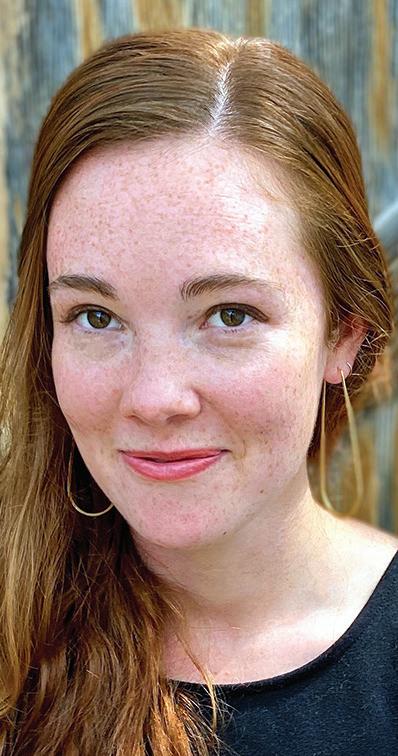
Prison nurseries are the subject of heated debate— no one enjoys the image of a newborn in a carceral facility. Despite this, overwhelming evidence indicates that these programs are beneficial for infants and mothers alike: newborns are able to develop key early attachments, leading to better mental and behavioral health outcomes in the long term; and mothers report better mental health, are less likely to experience postpartum depression, and are less likely to be reincarcerated
n Nurseries are implemented in the face of an indescribable alternative: infants born to incarcerated mothers are taken 24 hours after birth and placed in the care of a family member or a foster family.
passed away three days after being diagnosed. See
“Somebody has to be in those buildings for our children who’s for real,” Marshata declared. COVID, she said, is just another
Standing up for children also means backing teachers, Marshata explained. It means being a thorn in the side of politicians, school administrators or anyone who doesn’t value
The debate often takes a narrow focus on babies within the carceral context, rightly worried that the harsh and punishing atmosphere may harm children’s development. However, we too often fail to zoom out and fully grasp the typical reality of parenthood for incarcerated people. In some cases, when an incarcerated person gives birth, the infant goes to the custody of a relative—often a grandparent. But what commonly happens is that the infant enters the foster system. As with incarceration rates, the over-policing of Black and brown parents leads to the overrepresentation of Black children in the foster system: in Missouri, Black children
Campaign aims to increase state vaccination rates
By JoAnn Weaver The St. Louis American
With the latest rise in hospitalizations from COVID-19, the Missouri Foundation for Health (MFH) launched a statewide campaign in January. The #ThisIsLongCOVID campaign spotlights real Missourians sharing their experiences with surprising and often debilitating long-term symptoms, known as long COVID, according to a statement. It includes a mix of radio and digital ads featuring long COVID patients and physicians from across the state.
According to the St. Louis Pandemic Task Force, the highly transmissible nature of the Omicron variant in conjunction with the low vaccination rates in St. Louis is fueling a dramat-
ic surge in hospitalizations. Currently, only about 54% of Missourians are fully vaccinated, according to the campaign statement. The campaign intertwines facts and compelling long COVID stories told by the patients themselves.
COVID long-hauler Shantell Williams said she hopes the ads will encourage more Missourians to get vaccinated against the virus.
“Seven weeks after recovering from COVID, my hair started falling out. It came out in clumps. My husband had to shave my head. It was devastating,” Williams, a Missouri resident, said. “People may not know all the ways COVID can wreak havoc in your life. I hope people will hear my story and get vaccinated.” According to a campaign statement, Long
See TESTIMONIALS, A11



The White House said on Jan. 28, 2022, that a record 14.5 million Americans have signed up for health insurance through Affordable Care Act (Obamacare) marketplaces since Nov. 1, including more than 10 million enrollments through HealthCare.gov.
Last year’s stimulus bill contained substantial investments in the program, including increased subsidies for people who don’t receive health insurance from an employer or through Medicare or Medicaid.
People who signed up by Dec. 15 saw their new policies kick in on Jan. 1. People who signed up between Dec. 16 and
Continued from A10
the real-world experience of teachers on the front lines of caring for children. She said teachers’ concerns about the safety precautions instituted at the start of the pandemic were flawed, but health officials and school administrators didn’t listen.
“Take the rules about quarantining and that whole ‘six feet apart’ thing, for example. They weren’t designed for our babies,” she said. “If a child tested positive, they’d pull that kid out of class for quarantine. Our kids mostly live in apartment complexes. They can’t go to the west wing of the house. They are in close proximity with other family members.”
Marshata said teachers better understand the conflicting dynamics of impoverished families than health officials or school administrators.
“We realized that parents weren’t getting tested because they had to go to work or had other reasons,” she said. “It was like musical chairs; one grade was out for 14 days then another grade was out, but no one cared what we thought. Administrators were only concerned with having bodies in the buildings.”
Although teachers are aware and accept the risks of educating poor kids during a health crisis, Marshata asserts administrators placed families like hers in jeopardy. Although she has no solid proof, she maintains she contracted the coronavirus at school and
Continued from A10 COVID, also known as Post COVID syndrome or long haul COVID, represents the wide range of new, returning, or exacerbated health problems people experience four or more weeks after a COVID infection.
Continued from A10
make up 12% of the overall youth population and 20% of the foster care population Black and Indigenous children are also significantly more likely to cycle through multiple foster homes, nationally. Once in foster care, reuniting families becomes more difficult.
This is, in large part, due to the Adoption and Safe Families Act of 1997 (ASFA). This legislation, which is still in effect,
Jan. 15 saw their health coverage begin on Feb. 1.
“Health care should be a right, not a privilege, for all Americans. And one year into my Administration, we are making that right a reality for a record number of people—bringing down costs and increasing access for families across the country,” President Joe Biden said.
“This did not happen by accident. The American Rescue Plan did more to lower costs and expand access to health care than any action since the passage of the Affordable Care Act.
“It made quality coverage more affordable than ever— with families saving an aver-
brought it home to her family. She fell ill at the end of the work week in late August. Her husband encouraged her to get tested, and she did. Tarlvin, an engineer at a local hotel, was already on sick leave from an injury, but he was tested as well. The result was “positive” for both. Neither had been vaccinated.
n “Health care should be a right, not a privilege, for all Americans. And one year into my Administration, we are making that right a reality for a record number of people.”
– President Joe Biden
age of $2,400 on their annual premiums, and four out of five consumers finding quality coverage for under $10 a month. As a result, millions of our fellow Americans have now gained the security and peace of mind that dependable health insurance brings.”
Credit is being given to several of the tenets of the
chose not to get vaccinated.
Tarlvin’s death, however, and concern for their daughter’s health, was the motivating factor that convinced Marshata to get inoculated.
“It finally hit home. Somebody has to be here for them,” she confessed.
American Rescue Plan passed in March 2021, which significantly expanded subsidies for more middle-income Americans.
“That law eliminated the income cap for subsidy eligibility in 2021 and 2022, and also made subsidies larger for 2021 and 2022, by reducing the percentage of income that
people have to pay to buy the benchmark plan (second-lowest-cost silver plan),” Louise Norris, a licensed broker and analyst for healthinsurance. org, told Healthline. “All of that is still in effect for 2022, so people who are shopping now will tend to see larger subsidies than they saw during last fall’s open enrollment period.”
The new law expands subsidies to ensure that no family spends more than 8.5 percent of their income on a benchmark plan.
According to federal officials, that should net out to a savings of $50 a person a month or $85 a policy a month. In addition, half of the
enrollees should be able to obtain a Silver-level plan for $10 or less a month. And premiums are down even before those changes are factored in.
“The average premium for a 2022 benchmark ACA [plan] is about 3 percent lower than for 2021, so that’s good news,” said Nathan Teater, a sales manager at eHealth, a website that helps shoppers compare health plans. “When you couple that with the extension of subsidy eligibility to more consumers, a lot of ACA plan enrollees will be paying less from their own pockets toward premiums next year.”
n “I guess I’m listening to my ancestors.”
– Marshata Caradine-Randle, elementary school teacher
“We just didn’t have enough information to make us comfortable,” Marshata said. The couple quarantined in separate parts of their home. After a few days, it dawned on Marshata she hadn’t checked on Tarlvin. When she went to his room, she found him listless and hardly breathing. After emergency technicians arrived, she said the ambulance just sat in their driveway for long agonizing minutes.
“They [medics] said he wouldn’t make it to Memorial Hospital [in Bellville] or Touchette Hospital [in Centreville],” she said. “After about 15 or 20 minutes, I knew then he was gone.”
She believed Tarlvin’s fate was worse than hers because he suffered from diabetes, high blood pressure and other underlying conditions. The couple candidly discussed the risks of working in a highly populated school and hotel. Still, both
A recent study from the Missouri Foundation of Health found as many as one in three people who survive COVID experience long COVID symptoms. Some of the more surprising symptoms include hair loss, brain fog, erectile dysfunction, shortness of breath, prolonged loss of taste and smell, and several other neurological and respiratory conditions.
mandates that custodial rights are terminated when a child spends 15 of the last 22 months in the foster system. The implications are insurmountable: for instance, a mother serving a two-year sentence can permanently lose custody of her child or children if they entered the foster system upon her incarceration.
This draconian law—the ASFA—directly packages up the human right to parenthood with a mother’s punishment. Rather than “punishing the crime” as our current system purports to do, ASFA and simi-
Her daughters are grappling with the loss of their father by throwing themselves into volleyball at school, Marshata said. It was the bond between them and their father. For her, though, isolation has been Marshata’s coping mechanism. She hasn’t been in a classroom since Tarlvin’s passing.
Strangely, it was the recent ABC limited docuseries, “Let the World See,” that resurrected her desire to go back and advocate for low-income black students.
“My daughter saw the documentary about Emmett Till’s mother, Mamie Elizabeth TillMobley and told me about it,” Marshata recalled. “I remembered that Mamie was a teacher, too. I figured, if she could go back and empower kids after what she went through, then I could, too. If Mamie were still here, she’d say, ‘you have a responsibility to go back!’”
Marshata isn’t sure if she’ll be assigned to teach at Patrick Henry Elementary or some other school but next week, she plans to be back in a classroom somewhere. Not only is it her passion, Marshata feels it’s her call to duty.
“I guess I’m listening to my ancestors.”
Sylvester Brown Jr. is The St. Louis American’s inaugural Deaconess Fellow.
“We know that there has been so much information shared since the start of the pandemic, and we hope that by partnering with real Missouri physicians and those who have experienced long COVID firsthand that we are helping families understand the long-term impact,” Dr. Dwayne Proctor, president and CEO of MFH, said. “We are learning that a COVID infection can deliver
lar legislation separate children from parents, often permanently. In so doing, it directly jeopardizes reproductive justice for families by curtailing parents’ ability to care for their children. Reproductive justice fights for the human right to have or to not have children on one’s own term, and to parent children in safe and sustainable communities. Mass incarceration poses a direct threat to this framework of liberty, as children and parents are rendered disposable, placed behind bars for precious years of life. A reproductive justice framework

a major blow to one’s health regardless of age or current health status, so vaccines are still the best protection.”
Proctor said 73% of Missourians aged 18 and older have received at least one dose of the vaccine.
“We want information like that to be known but we also want people to know about ‘long COVID,’” Proctor said. “Having people from Missouri
highlights the way that reproduction is differentially valued by race, class, and other axes of power. In the case of incarcerated mothers and their children, deprivation of the right to parenthood is administered on stark racial lines, making this a pressing issue of racial justice.
The reproductive injustice exemplified by the rending of infants from incarcerated mothers is one stage in a long legacy of undermining the rights of Black and brown peoples’ right to bear and to parent children. Carceral reproductive injustice emerges from centuries of
hear from other Missourians firsthand about their experience with long COVID is what we hope will help them make the decision to get vaccinated.”
Proctor said this is one of the many campaigns that has run during the pandemic, and as the public health crisis shifts, MFH shifts and adapts to meet the needs of the community.
“We know that vaccinations are the best protection out there and quite simply, the goals of the campaign are people to get vaccinated,” he said. “We want people to know that vaccinations are free and available within five miles of their home, and we want groups of people like African Americans, who are lower in their vaccination rates, to really think about this and understand that long COVID is a risk.”
eugenics, reproductive control under a system of slavery, coercive and violent sterilizations, Indigenous boarding schools, and inadequate access to health and prenatal care. While this mechanism is different—the logic is the same.
Missouri’s prison nursery bill would disrupt this punishing process by keeping infants out of the foster system for up to 18 months, allowing babies to develop key bonds and often determining whether incarcerated mothers keep or lose custody of their newborn. While we must keep doing the work
to end mass imprisonment, the prison nursery would mean the difference between upholding or undermining families who are currently impacted. While the abolition of all carceral systems remains the ultimate mandate, until that system is overturned, we must fight for the rights of incarcerated parents. Prison nurseries move us one step towards a more just reproductive future.
Ella Siegrist (she/her), MA PhD Student in the Department of Sociology at Washington University in St. Louis



PRESENT:


















for several different reasons.
your plate into the right size servings, ask your server for a to-go box. Go ahead and box up what you don’t need to eat right away. You can enjoy
Walking is one of the best ways to stay active.
Let’s make a game out of exercise!
As spring approaches, warmer weather allows us all to get more outdoor exercise. Here are some ways to become a more active person.
Throughout the day you can look for ways to increase the amount of steps you take. You can walk around the living room while watching TV. You can take the stairs instead
It’s important that before you embark on any kind of exercise to remember two things: warm up and cool down. Start with some slow stretches and movement (like walking) to increase your heart rate a little. Warm up for a good five minutes before increasing your heart rate.
March 20, 2021, is the first day of spring. With spring comes warmer weather and longer days (later sunset). Make it a habit to spend as much time playing outside as the weather allows.

few weeks until this becomes what you’re used to.
Here are the steps to making a healthy permanent change. We‘ll use the sugary drink change as an example.
First, locate either a deck of cards or two dice. Next you’ll need to make a list of different types of exercise: jumping jacks, sit-ups, lunges, etc. Write each exercise item on a small piece of paper or index
> NEVER walk on a “frozen” pond, lake, river or any other body of water. Just because it looks frozen does not mean it is safe.
Break into small groups and define what it means to be a bully. Share your ideas with the class. Did you have the same things listed (as the other groups) that you would consider as bullying behavior? Now back in your groups, create a newspaper ad that includes at least two of the following:
How much time do you spend each day looking down at a phone, laptop or video game?
While animals can be cute and furry, we should all be careful anytime we are around any kind of animal (especially if it isn’t your own pet). A dog you see while walking down the street might seem friendly, but if it doesn’t know you it could be afraid and jump up on you, or bite. When you see someone walking a dog,
Chiropractors around the country see young patients every day suffering from back, neck and head-aches resulting from the extra strain you put on your body when you look down for long periods of time.
> If you are with someone that falls through the ice, first run (or call) for help. Do not try to go out onto the ice to help your friend. You can fall through the ice too.
> How bullying hurts others.
A BMI (Body Mass Index) is a generic way to calculate where your weight falls into categories (thin, average, overweight, obese). However, it’s a good idea to remember that a BMI may not take into consideration many things such as athleticism (how athletic you are), your bone density and other factors. Discuss your BMI with your
> What to do if you are bullied.
Decide you’re going to switch from soda
Avoid gravies, cheese sauces and other kinds of toppings that often just add fat and
Start by substituting one drink per day
even simmered can all mean, “cooked in oil.” Instead, choose baked or grilled options.
Instead of playing video games — play baseball, football, badminton, or some other active game.
Some fun outdoor games to play include tag, kickball, basketball, Frisbee, and bicycling. Choose activities that increase your heart rate
Instead of surfing the ‘Net — go for a brisk walk around the neighborhood.
Weekly Newspaper in Education Program
Every few days increase the amount of water
After 3-4 weeks, this change will become
of soda — it may not be considered one serving size. For example, a 20-oz bottle contains 2.5 servings. So if the bottle states “110 calories per serving,” that means the entire bottle contains a total of 275 calories! Remember to watch those serving sizes and you’ll have better control over what you’re eating
Stick with water to drink. Not only will you save money, but you won’t be adding in extra calories from a sugar-
When you automatically reach for water instead of soda, it has now become a lifestyle change!
of an elevator, or maybe you can walk to a nearby store instead of riding in a car.
Secondly, when you are finished with any kind of strenuous (very active) exercise, take some time to cool down. You can slowly stretch your arms and
What are other ways to stay healthy while dining out?
Learning Standards: HPE 1, HPE 2, HPE 5, NH 1, NH 5
Learning Standards: HPE 1, HPE 2, HPE 5, NH 1, NH 5
card and fold into a small square. Put these squares into a bowl. Take turns rolling the dice (or drawing a card) and selecting an exercise from the bowl. The total number on the dice or card tells you how many of the exercise you must do. Face cards (king,
Some studies show that kids that take about 12,000 steps per day are healthier. Consider purchasing a pedometer. This small,
Latoya
Debra
Melissa Douglass, MSW
Deborah Edwards, School Nurse

Watkins-Hamer,
LPN, ADN, BSN


Where do you work? I am a family nurse practitioner for BJC Medical Group.
Where do you work? I am a school nurse at Monroe Elementary School.
and breathing. You want to have fun, but it’s also a great way to help keep your heart, lungs and body healthy. Make a list of your favorite 10 activities to do outdoors. Compare your list with your classmates and create a chart to see what are the most popular.
it’s always a good idea to ask the dog’s owner if it’s ok to pet the dog.

Where do you work? I am a school nurse with St. Louis Public Schools.
Where do you work? I work in the perioperative areas at Barnes-Jewish Hospital - I strive to provide excellent care to everyone I encounter daily at BJC, or any other healthcare facility.
Learning Standards: HPE 1, HPE 4, NH 1
> What to do if you see someone else bullied.
> Also — remember to look up! Icicles injure numerous people every year. If you see large icicles forming over your front steps, ask your parents to use a broom handle to knock them off to the side before they break loose from your gutters.
A couple of quick tips that will reduce that strain on your neck are:
> When walking on icecovered roadways or sidewalks, take baby steps. Walk carefully and slowly.
legs again, and continue with reduced speed movements until your heart rate begins to slow down.
This warm-up and recovery period is important for your heart health. It also helps to reduce the amount of muscle pulls and strains.
Learning Standards:
inexpensive device clips onto your waistband and measures how many steps you take a day. Challenge yourself to increase the amount of walking you do. Try adding in more and more walking each and every day.
Instead of watching TV — ride your bike with friends. Can you think of other ways to be more active? Going outside and staying active not only increases your heart rate and burns calories, but it also helps you build friendships!
queen or jack) should all count as the number 10. Aces are “wild” and you can do as many as you want! To really challenge yourself, have one person roll the dice and the second can select the exercise. See who can complete the exercise challenge first!
Learning Standards: HPE 1, HPE 2, HPE 5, NH 1
Learning Standards: HPE 2, HPE 4, HPE 5, NH 1
Beet Chips
Ingredients:
doctor if you have any questions. The formula to calculate your BMI is 703 X weight (lbs) ÷ height (in inches/squared) or search “BMI Calculator” to find an easy fill-in chart online. If your number is high, what are some ways to lower your BMI?
And finally, if you see an unleashed dog (or any kind of wild animal) wandering around, do not approach the animal or attempt to pick it up. Wild animals are scared of you and may lash out at you in fear.
> What to do if YOU are the bully.
1. Most importantly — take breaks! Have a goal of a 3 minute break every 15-20 minutes. Move around, stretch your neck and relax, without looking down!
3 Med Beets
PRESENT: Banana PB Smoothie
Ingredients:
Ingredients:
Learning Standards:
1 Tbsp Olive Oil Salt and Pepper to taste
Ingredients:
1 15-Oz Can Garbanzo beans
1 cup blueberries
Learning Standards: HPE 5, NH 5
Look through the newspaper for examples of ad layouts and design. Discuss the words “compassion,” “empathy” and “sympathy.” How do they each play into your response to bullying at your school?
2. Set your tech device in a holder to keep it at eye level, reducing the need to look down.
> What other ice hazards are there?
Learning Standards: HPE 1, HPE 2, NH 5
Ingredients: 1/2 Cp Vanilla Greek yogurt, 3 Tbsp Natural peanut butter, 1 Ripe banana (sliced and frozen), Splash of vanilla (optional) 6 Ice cubes
1 cup non-fat Greek Yogurt
1 Garlic clove, crushed
(optional)
Directions: Preheat oven to 375 degrees. Slice beets very thin, drizzle with oil and put in a single layer on a baking sheet, sprinkle with salt/pepper. Bake 15-20 minutes, until crisp.
2 Tsp Cumin, 1 Tsp Olive oil, ½ Tsp Salt Directions: Combine all ingredients in a blender until smooth. Enjoy with baked tortilla chips or raw vegetables. grain ingredient.
Learning Standards: HPE 2, HPE 5, HPE 7, NH 5, NH 7
Directions: Spread peanut butter on four of the crackers and top with sliced strawberries. Drizzle with honey and top with the other crackers to make four cracker-wiches. looks like one small bottle
Learning Standards: HPE 2, HPE 5, NH 4
“Questions or comments? Contact Cathy Sewell csewell@stlamerican.com or 314-289-5422
Learning Standards: HPE 1, HPE 2, NH 1, NH 5
Directions: Blend all ingredients until Smooth. Makes 2 yummy smoothies!
Directions: Drop each blueberry into the yogurt. Using a spoon, swirl around to coat and place each blueberry on a cookie sheet topped with parchment paper. Freeze for at least an hour.
Where did you go to school? I graduated from McCluer High School. I then earned a Bachelor of Nursing and a Master of Nursing Practice from the University of Missouri – St. Louis. And finally, I earned a Doctorate of Nursing Practice from Maryville University.
Where did you go to school? I graduated from Sumner High School. I then earned Associate Degree in Nursing from Forest Park College and a BS in Business Administration from Columbia College.
Where did you go to school? I graduated from McCluer North High School. I earned an Associate of Applied Science in Nursing from Meramec College in Kirkwood and completing my bachelor’s degree at Webster University in Webster Groves.
Where do you work? I am the founder and distance counselor for Goal Driven Counseling, LLC. Where did you go to school? I graduated from Whitney Young Magnet High School in Chicago, IL: same as former first lady Mrs. Michelle Obama. I then earned a Bachelor of Science in Social Work, and a Master of Social Work from the University of Missouri – St. Louis. I also completed two more years of supervision and exams to become a Licensed Clinical Social Worker in the state of Missouri.
Where did you go to school? I graduated from Vashon High School. I then earned my Licensed Practical Nurse, an Associate Degree of Nursing from Forest Park Community College and a Bachelor of Science in Nursing from Goldfarb School of Nursing.
What does a family nurse practitioner do? Each day I have office visits with patients to help treat new health conditions and/or manage established health conditions. I perform physical examinations on patients, order labs, read x-rays results, and more.
What does a school nurse do? I love giving students medications, so they’re able to focus on learning. I clean and bandage wounds. I use medical equipment like a stethoscope, for example, to evaluate whether or not my asthmatics are breathing well. Moreover, I teach and promote healthy habits to my students.
What does a Licensed Clinical Social Worker do? I use technology to help teens and young adults explore their emotions, better understand their feelings, work through relationships, and address common challenges completely online through a computer, tablet, or smart phone. Similar to a Facetime call, I support and guide my clients from the comfort of their home or private location where they are comfortable
Why did you choose this career? I chose this career to help improve the health of my community.
What does a perioperative nurse do? I teach healthcare so that the patients fully understand why they are having a certain procedure and what team members will be a part of their surgical cases. Why did you choose this career? I love taking care of others and I also work as a healthcare professional at my church to provide assistance if needed.
What does a school nurse do? I assess the concerns of students who are ill, injured or experiencing alterations in their normal health. Nurses screen daily staff, students and visitors for safety. Monroe School is a pilot school for Covid-19 test sites in partnership with the city. Why did you choose this career? I love nursing because there are many opportunities in hospitals, schools, clinics and offices, insurance, legal and research. My passion is working in the schools with students, parents, staff and community partners.
Why did you choose this career? I am a St. Louis native, and was an asthmatic child who experienced frequent hospitalizations. Besides having the influence of nurses in my family, the local nurses who helped take care of me were my “angels” and always managed to nurse me back to health, thus sparking my interest.
Why did you choose this career? I chose this career because I enjoy being a support to teens and young adults in a very challenging phase of life that can be overwhelming. I enjoy teaching them how to best take care of themselves so they can live healthy and fulfilling lives.
What is your favorite part of the job you have? I love it when I see the patients get well, or stable enough to leave the hospital. I cry sometimes but I know God is still in control.
What is your favorite part of the job you have? Many chronic health conditions (diabetes, high cholesterol, high blood pressure) are preventable, and early detection is key. Thus my favorite part of the job is partnering with patients to establish and manage a plan to help them each live a long and healthy life.
What is your favorite part of the job you have? I enjoy when a child tells you, “I want to be a nurse.” And best of all, I love the smiles, hugs and “thank-yous”.
Learning Standards: HPE6, NH3
Learning Standards: HPE6, NH3
What is your favorite part of the job you have?
My childhood health challenges have given me sensitivity to children suffering with illness. After being given a new lease on life, I consider it an honor to be in a position to promote health to the children of my community, in whatever capacity I serve – in turn, being their “angel.”
What is your favorite part of the job you have? I love that my job makes talking about mental health not as scary and even makes it kind of cool. I love that I get to build valuable relationships with so many people that trust me to be there for them. I love that no matter where my clients are, we can simply connect with a video call and I can not only support them through hard times, but lots of good times as well.
Learning Standards: HPE6, NH3
Learning Standards: HPE 6, NH 3
“Questions or comments? Contact Cathy Sewell csewell@stlamerican.com or 618-910-9551
Learning Standards: HPE6, NH3
“Questions or comments? Contact Cathy Sewell csewell@stlamerican.com or 314-289-5422
“Questions or comments? Contact Cathy Sewell csewell@stlamerican.com or 314-289-5422
“Questions or comments? Contact Cathy Sewell csewell@stlamerican.com or 314-289-5422







The St. Louis American’s award winning NIE program provides newspapers and resources to more than 8,000 teachers and students each week throughout the school year, at no charge.
Questions or comments? Contact Cathy Sewell csewell@stlamerican.com or 618-910-9551

Northview Elementary School teacher Ms. Heather Beasley uses the St. Louis American’s STEM page to inspire science lessons with her fifth grade class. Students Brandon Bradely, Dorien Davis, and Xavier Harris are learning about renewable and nonrenewable energy resources.
Northview Elementary is in the Jennings School District.


Computers are an essential part of our daily life. It is important to protect them from harmful (and expensive) viruses.
What is a computer virus?
A computer virus is a piece of programming code spread through email attachments, application programs on your computer, or application programs installed from disk drives or flash drives.
There are several different types of viruses. The program virus starts with application programs and spreads to other programs on the computer. It

Background Information: In this experiment, you will test your inventor skills to create a security device.
Materials Needed:
• Buzzer • Battery • Cardboard • Electrical Wires (red and black)
• Battery Snap Connector • Scissors
can also be spread when a copy of the program is installed on another computer. The boot sector virus enters your system through a disk and infects the hard drive. With this virus, any time a disk is used, it will be infected. The macro virus specifically targets applications on your computer like Microsoft Word, Excel and Outlook. When you open an infected document in these programs, the program itself becomes infected, allowing the virus to spread to any document opened up inside
the program. The email virus spreads through email attachments and links.
Once an infected attachment is opened, the virus enters your email application, and duplicates itself by emailing everyone in your email list.
In order to protect your computer, be sure you keep an updated version of anti-virus software. Also, do not open email from anyone you don’t know. If you receive an email from a friend that has a link or attachment, check with your friend to be sure they actually sent the link and that it is not a virus.
Learning Standards: I can read nonfiction text for main idea and supporting details.

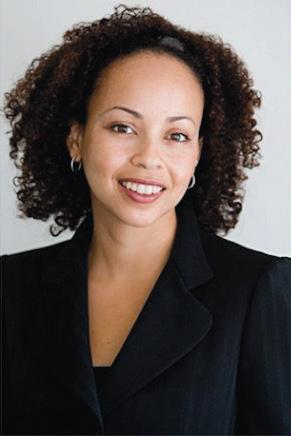
In 1976, Mwende Window Snyder was born to an American father and a Kenyan-born mother, Wayua Muasa. Mwende means “beloved” and is the name of her maternal grandmother. This tradition of passing down the names is customary in Kenya. Snyder’s mother taught her basic computer programming at 5 years old. Snyder learned new concepts quickly and taught herself phrases in Swahili at 9 years old. This came in handy when she accompanied her family on trips to Kenya. Snyder attended Choate Rosemary Hall in the early 1990s and was the youngest of 30 board members there.
Snyder is an IT expert who has worked as director of security for such companies as @stake, Microsoft, Mozilla, and Apple. Snyder even had “chief security of something-or-other” printed on her business cards. In 2004, she coauthored Threat Modeling, an online security guide designed for software engineers. She also co-founded a security company, @stake, that was sold to Symantec for $49 million dollars. Snyder’s approach to security is to think like a hacker and to identify weak points in security.
• Ribbon or String • Concealing Materials (aluminum foil, paper, magnets, tape, push pins) • Large Rubber Band • A Door Tape
Process: Your goal is to build an alarm that will make a buzzing sound when someone enters your room. You will need to attach wires from the buzzer to the battery. The red wire needs to connect to the positive end of the battery and

Computer scientists are excellent problem solvers. They have a good eye for detail and strong logic skills. Solve these multistep word problems. Remember to read all parts of the question carefully and check your work.
z Sami and Krystal have twenty five minutes to walk to school together. It takes them eight minutes to get to the corner where the library is. It takes them another seven minutes to get to the fire station. How much longer do they have to get to school without being late?
___________ minutes
x Joseph earned $15 on Saturday but he only managed to earn half that amount on Sunday. He earned $23 the previous weekend. How much more does he need to earn to give him the $80 he needs to

Learning Standards: I can add, subtract, multiply, and divide to solve multistep word problems. Design & Build a
the black wire needs to connect to the negative end. Use the other materials to conceal the alarm (remember you don’t want others to know it is there).
q Brainstorm a design for your alarm using the materials that you have available. Sketch the design.
w Build the design and test it. If your alarm doesn’t work, try reattaching the wires from the buzzer to the battery.
e Revise and rebuild the alarm as necessary.
r Compare designs with your classmates. Which designs were most effective. Why?
Learning Standards: I can follow sequential directions to complete an experiment. I can analyze results.
buy a new computer monitor? ___________ dollars
c Ashleigh runs 2 miles on Monday and three times that many on Tuesday. If she wants to run a total of 25 miles this week, how many more miles does she need to run? ___________ miles
v A salesman bought a case of 48 backpacks for $576. He sold 15 of them for $18 each at the conference, and the rest were sold to a department store for $25 each. How much was the salesman’s profit?___________ dollars
About 10% of all social media users have received a cyber
Data breaches through September 30, 2021, exceeded the
This special Newspaper In Education initiative is made possible, and delivered to classrooms, through The
Many people are taking notice and praising her success. Dave Goldsmith, president of Matasano Security refers to Snyder as an “online rock star.” Eva Chen, CEO of Trend Micro says, “It’s gratifying to see other women in prominent roles in tech security. For so long, men have dominated the field.” Mitchell Baker, chairman of Mozilla, adds, “She is effective and respected among several constituencies—nitty gritty geeks, customers, and the general public. She has learned to walk the fine line of making complex concepts understandable and accurate.”
To follow Window’s blog, visit: http://www.dec.net/ws/.
Learning Standards: I can read a biography about a person who has made a contribution in the field of science, technology, or mathematics.

Use the newspaper to complete the following activities.
Activity One — Fact and Opinion:
Choose an editorial (or opinion column) in the newspaper to read. While reading, underline the facts, and circle the opinions. Did the writer rely more on facts or opinions? How did this technique affect the reliability of their writing?

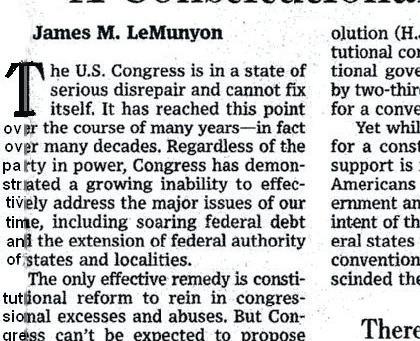
Activity Two —
Digital Citizenship:
Part of digital citizenship involves giving credit to the proper sources. Find examples in the newspaper for crediting others for their photographs, quotes, articles, etc.
Learning Standards: I can use the newspaper to locate information. I can identify fact, opinion, and reliability.


By Jamala Rogers
The challenge with trying to bring sanity and humanity into prisons is that conditions are kept undercover. Some people don’t want to know what’s going on behind the walls and others feel powerless to do anything about it.
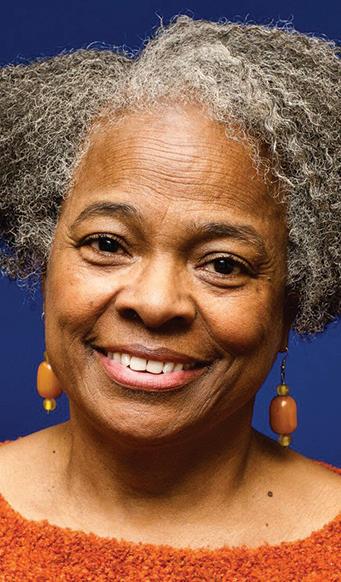
Filmmaker Stanley Nelson brings the 1971 Attica Prison drama to the big screen using video footage never before seen publicly.
Fifty years later, the Attica massacre remains the bloodiest in U.S. history. In 15 minutes, a blaze of bullets was fired by prison guards, state troopers and national guardsmen. It was like shooting fish in a barrel. Before the smoke cleared, 39 lay dead, hundreds were injured and many lives were forever traumatized. This was the human toll it took to bolster the prisoners’ rights movement.
During the Attica standoff, it seemed everyone played their role. The mainstream media told its lies to ensure public sentiment would not side with prisoners. News stories conveyed that inmates had done horrific things to the guards, including slitting their throats. In fact, a special patrol of prisoners was responsible for keeping the hostages safe during the entire time of the siege.
Then there were the politi-
cians. A politically ambitious Gov. Nelson Rockefeller was in regular communication with then President Richard “Tricky Dick” Nixon. They never intended to negotiate in faith, seeking to project the most vivid picture of who could be hardest on crime, aka Black prisoners.
Prisoners had righteous demands like getting medical treatment, receiving more than one roll of toilet paper per month, ending unbridled brutality by guards, and increased visiting hours. They were the same demands echoing in archaic penal institutions across the country.
Having organized inmates and their families since the
n Almost every issue in the Attica demands is alive and well in 2022. There needs to be serious scrutiny of prisons from bottom to top.
early 1970s, I had witnessed firsthand the inhumane conditions at the Missouri State Penitentiary in Jefferson City. When activists heard about Attica, we were looking at the same conditions here; sadistic guards, intolerable environment and inhumane practices. All the ingredients to fuel an uprising. In 2005, my column for
The St. Louis American titled “MSP: Misery, Suffering, Pain” gave a few gory details of the practices at the penitentiary. It caused a firestorm and a flurry of letters to the American but none could refute the uncomfortable truths.
Fast forward to today. Over two million citizens are caged in prisons and jails across the nation. They may get more toilet paper and can see loved ones in bright and colorful rooms instead of behind mesh. The sadistic guards, intolerable environment and inhumane practices are still essential elements of the oppressive prison system. Now, psychological torture, verbal abuse and physical brutality occur away from the ever-gazing eyes of surveillance cameras, according to inmates and families,
Almost every issue in the Attica demands is alive and well in 2022. There needs to be serious scrutiny of prisons from bottom to top. This should include assessing the mental capacity of guards, the qualifications of medical staff, and political connections of state vendors. There hasn’t been a legislative watchdog for prisoners since Rep. Charles “Quincy” Troupe was in the State Assembly and headed up the appropriations committee for corrections. That’s over 25 years ago.
“Attica” is available for free viewing on YouTube until the end of Black History Month. If you have thin skin but an open mind, it is worth checking out. It is real and raw, just like life inside the prison cages.

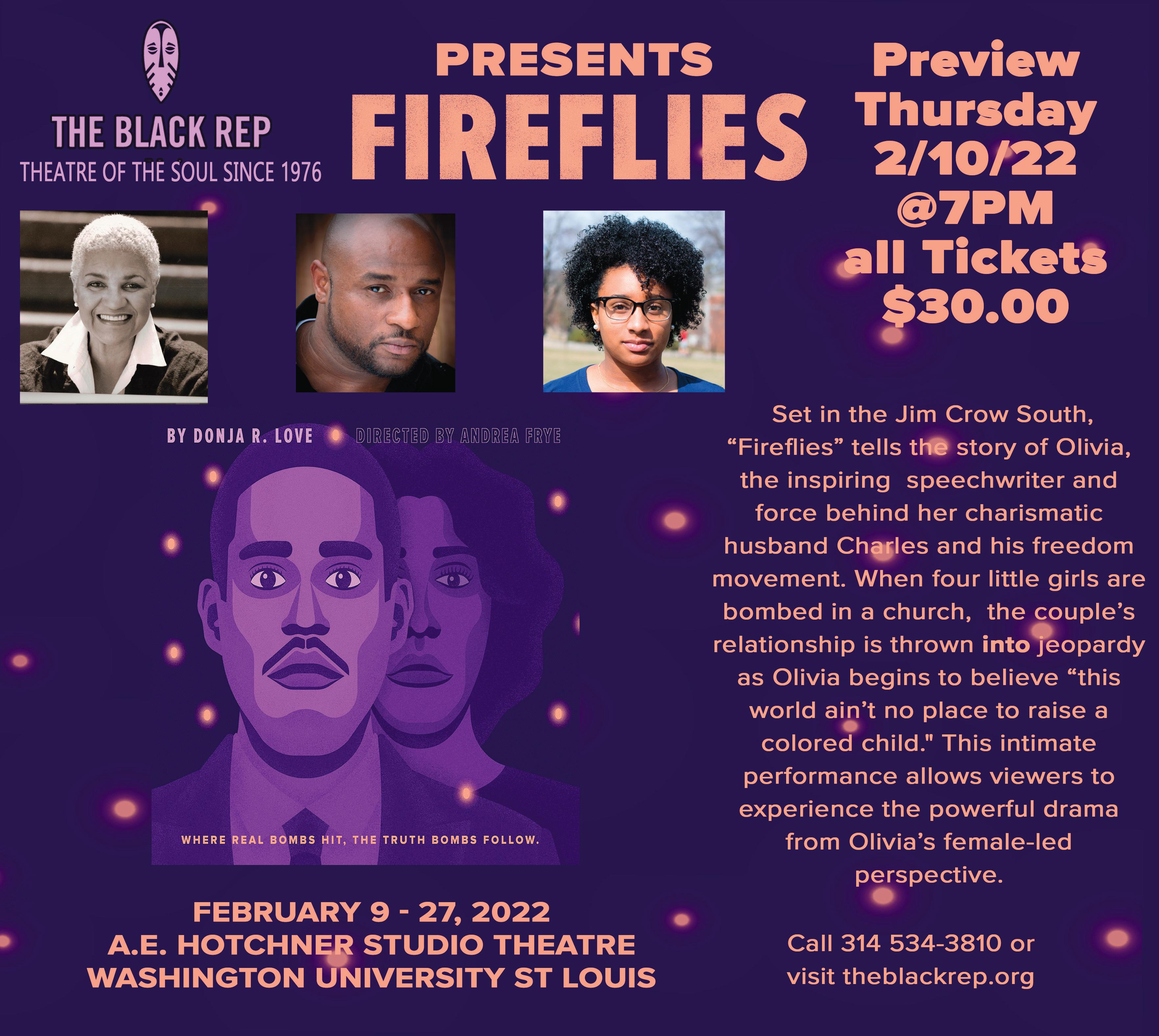

By Alvin A. Reid St. Louis American
When Marcia Fudge was confirmed as Housing and Urban Development (HUD) secretary last spring, one of her first promises was to increase African American home ownership throughout the United States.
Her goal carries the name “3 by 30”, with the aim of increasing Black homeownership by 3 million by the year 2030.
Fudge has a new St. Louis ally in Tenesia Looney-Brown, who recently celebrated the opening of Keys Realty Group at 6140 W. Florissant Ave.
“There are so many barriers that are preventing African Americans from becoming homeowners,” Looney-Brown said.
“I want them to know that the obstacles are just barriers not barricades and Keys Realty Group STL is here to help the continued efforts of many others by ensuring they receive the resources and education from passionate and dedicated Realtors.”
n “We want to create 100 new African-American homeowners in 12 months.”
– Tenesia Looney-Brown
Like Fudge, Looney-Brown has set a challenge to increase Black home ownership.
“We want to create 100 new AfricanAmerican homeowners in 12 months,” LooneyBrown said as the business officially opened on Dr. Martin Luther King weekend.
“Fulfilling an unfulfilled mission for fair housing for all is the basis of Keys Realty Group Inc.”
The Kansas City based real estate brokerage was established in 2017 and has helped create over 400 new African American and minority homeowners in that region.
Looney-Brown said the company’s philos-
ophy is based on the works of Dr. King and his belief in “equality of opportunity, of privilege and property widely distributed, and fair and equal housing.”
In a Jan. 26, 2022, “What’s Up Kansas City?” YouTube interview, Looney-Brown said traveling to St. Louis to visit relatives and her grandson led to her opening an office here.
“I was seeing all these beautiful brick homes,” she said.
Weary of staying in hotels, she bought a house and began renovating it.
“People came by to see what I was doing. I would ask them, ‘do you pay rent?’ If you pay rent, you can afford a house,” she said.
“People in St. Louis are no different than people in Kansas City. There are a lot of renters. It is important that we are a true community Realtor.
“Not everyone is ready to buy a house for different reasons. We do a lot of education. We help people with understanding down payments, improving credit. We help people get there.”
See REALTOR, B2
By Valerie E. Patton For the St. Louis American
At the onset of Black History Month, we are called not only to reflect and learn from our past, but also to look forward to how we, as Greater St. Louis, Inc., can work in support of a future that lifts everyone in our metro, especially our Black residents.
For us, that work centers on inclusive economic growth: the north star of the STL 2030 Jobs Plan That means we grow the pipeline of opportunities and do the work in partnership to reduce barriers so that everyone in our region, regardless of their zip code or the color of their skin, can thrive.
That means committing to the work of promoting community-led development and wealth-building that will have generational impact. It means shining a light on the stories of people that not only shaped our history, but also those that will guide our future.
This month, we launched the application process for both our Diverse Business Accelerator and our St. Louis Business Diversity Initiative Fellows Experience, initiatives focused on investing in Black entrepreneurs and multi-cultural professionals in our metro.
On theSTL.com, part of our STLMade initiative, we are amplifying the stories of Black creatives, business and community leaders, and other Black members of our community who are driving change and shaping the future of our metro.

Valerie E. Patton
We are working with leading businesses across the region, like GDIT, and organizations, like Rung for Women, to strengthen and expand workforce development efforts. To promote community development efforts, we are partnering with the City of St. Louis on its community-led neighborhood planning process and we are leading a metro-wide coalition that has been named a finalist for a federal Build Back Better Regional Challenge grant that would result in millions of dollars in investment in North St. Louis City. To help strengthen wealth building opportunities for our Black residents, we are supporting a new entrepreneurship program at Harris-Stowe State University they recently launched with an investment from PNC Bank.
n To help strengthen wealth building opportunities for our Black residents, we are supporting a new entrepreneurship program at HarrisStowe State University they recently launched with an investment from PNC Bank.
We are working with companies like 8th Avenue Foods in support of high-quality manufacturing and production jobs in North St. Louis County and helped secure a new NASCAR Cup Series race at World Wide Technology Raceway that is driving over $40 million in new investment to Madison, Illinois
While there is much more to be done, these are some of the ways we are committing to drive inclusive growth. That commitment also requires us to acknowledge that as we celebrate and honor Black History this month, our work must be a year-round endeavor.
Valerie E. Patton is Greater St. Louis, Inc. chief diversity, equity, and inclusion officer and Greater St. Louis Foundation president
SEMO’s Dr. Joseph L. Jefferson honored

Dr. Joseph L. Jefferson
Dr. Joseph L. Jefferson, the director of jazz studies at Southeast Missouri State University, was recently named the 2022 Jazz Education Network - Ellis Marsalis, Jr., Jazz Educator of the Year! This award was presented to Jefferson at the JEN Conference on Jan 6, 2022 in Dallas. Jefferson’s honors and awards range across the scholastic and musical spectrum, including: Best Jazz Ensemble and Best Trombone Section (Villanova Collegiate Jazz Festival), finalist in American Prize Competition (as a member in the West Virginia University Symphony Orchestra) and many more.
Curtis named director of Federal Programs

Riverview Gardens School District announced the appointment of LaKena Curtis as the district’s director of federal programs. Curtis will coordinate and monitor grant funds, including Cares Act, ESSER and special projects to ensure compliance with federal and state laws for improved academic performance. She will also manage required Federal and State reporting, secure financial resources for the district and provide support to schools through the procurement of federal, state and private grants. Prior to her appointment, Curtis served as principal at Glasgow Elementary School as well as Central Middle, assistant principal at CMS, and as a communications arts teacher at Danforth Elementary.
Fennoy joins SLCCU as senior vice president
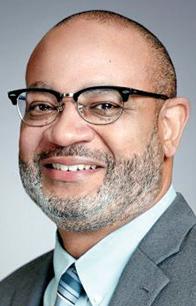
Fennoy
Alex Fennoy has joined St. Louis Community Credit Union (SLCCU) as senior vice president of business services. In this role, Fennoy will lead the organization’s newly created Business Services division that is designed to provide much-needed capital to established business owners in their desire to build wealth. Through this area, up to $5 million in business loans will be offered to qualifying applicants. Fennoy has nearly 30 years of banking experience, including a strong focus on business lending.

Janelle Stowers, owner and broker of Stowers Realty Group, was recently sworn in as a director for the Missouri Association of Realtors in January 2022. She was also recently named vice president of the Ferguson Neighborhood Improvement Board. Stowers is currently working to get the Realty Central Education school started. Stowers has an MBA as well as a masters of education in adult and higher learning, both from UMSL.


$100K grant will be given annually to Black entrepreneur
By Dana Rieck The St. Louis American
In honor of his civic leadership and community involvement, a St. Louis couple has committed to five years’ worth of funding to continue Arch Grant’s Donald M. Suggs Excellence in Entrepreneurship Award.
Suggs, publisher and executive editor of The St. Louis American, was first honored by Arch Grants with its 2020 Entrepreneur Award at the organization’s eighth annual Arch Grants Gala. John and Alison Ferring chaired the award committee, which also led an effort that year to raise funds for two grant awards in Suggs’ honor for 2021.
Emily Lohse-Busch, executive director of Arch Grants, noted Arch Grants will increase this year from 2021’s amount of $50,000 to $100,000 per honoree, so the next five Donald M. Suggs Excellence in Entrepreneurship Awards will be funded through the Ferring Family Foundation. Each year, the award will be given to a Black entrepreneur already in St. Louis or who plans to relocate to the city.
“For us, having a grant named for somebody like Dr. Suggs is so powerful,” Lohse-Busch said. “Not just in the real funds that it will give another company but also [because] these are all founders who [look to] Dr. Suggs [as a] role model … he’s been an extremely active and engaged and influential civic leader, and I think there’s multiple benefits to this in terms of our mission alignment.”
Alison Ferring points not only to Suggs’ civic engagement, but his entrepreneurial spirit as an oral surgeon who took over The St. Louis American
Among his numerous accomplishments and awards, Suggs was the first African American to serve as president of the Convention and Visitors Bureau of St. Louis; was president of the Alexander-Suggs Gallery of African Art from 1970 to 1989; was chairman of the Poor People’s March-OnWashington in 1968; and was chief of oral surgery at Dover Air Force Base in Delaware and became the first Black person to serve as an associate clinical professor at St. Louis University Dental School.
Alison Ferring also emphasized how important it is for young Black entrepreneurs to know there are local resources to help them on their journey.
“There’s so much exciting stuff being done by these millennials, and we just want to be the wind beneath their wings and see them take on this mantle of leadership, that they seem
Continued from B1
Looney-Brown said S. Louis’ urban core, like Kansas City’s, needs more Black

to be doing now, in the future,”
Alison Ferring said. “So, I feel very optimistic.”
John Ferring echoed that sentiment, noting they’ve focused on education, diversification and leveling the playing field within the entrepreneurial world.
“When we saw the response to the Donald M. Suggs grant last year, it kind of made us think that this is something that needs to be done on an ongoing basis,” he said. “… Don has been a good friend for a long, long time, but has become even a better friend over the last 15 years, since we live in the same building. We see him pretty regularly and just felt that this was something that we wanted to do to kind of honor everything that he has done in St. Louis and all the groundbreaking things that he’s done.”
He acknowledged Suggs’s humble nature and noted that while he doesn’t talk about himself a lot, John Ferring believes it’s important for the people of St. Louis to know what an extraordinary individual he is.
“This is just another example of the extraordinary civic leadership and steadfast willingness to invest in a more inclusive and equitable community that the Ferrings have generously provided over the years,” Suggs said in response to the announcement that the award would continue for five years.
The first Donald M. Suggs Excellence in Entrepreneurship Award last year went to St. Louis-based entrepreneurs Tara Nesbitt, David Rygiol and Justin Trusty who founded Harmonee. It’s a mobile application software company that
homeowners. She added that her agents “share my vision, share my passion,” to make home ownership a reality.
Looney-Brown’s words are like Fudge’s on her quest.
“We’re going to do everything we possibly can to

allows businesses to pose questions to targeted groups of people in exchange for donating funds to nonprofits that those people support, raising funds to support community groups and giving businesses valuable consumer insights.
The second Donald M. Suggs Excellence in Entrepreneurship Award went to Derek Canton, founder of Paerpay, an application software platform that allows merchants to accept contactless payments without installing new hardware, changing processors or downloading apps. The company was originally founded in Boston.
Lohse-Busch said because the individual grant amounts are increasing from $50,000 to $100,000, she anticipates there will be around 20 honorees this year, one of those specifically receiving the Donald M. Suggs Excellence in Entrepreneurship Award.
The application process for 2022’s Arch Grants begins March 18 and closes April 15. Of the applications received, 40 to 50 companies will be invited to a live pitch followed by a Q&A session with the competition committee. Awardees will then be notified in September and announced at Arch Grants Annual Gala Fundraiser.
“Arch Grants is uniquely positioned to empower entrepreneurs at an early stage,” Gabe Angieri, Arch Grants’ director of development and strategy, said. “And building a more vibrant inclusive, entrepreneurial ecosystem in St. Louis through this award and others that we will provide in future years is a mission critical for us.”
“We
“Those
down payment assistance program and increasing housing production through land use reforms and economic intervention in distressed communities.
n “I’m disappointed to have my season end this way, but we all agreed that this was the best decision.”
– Washington Wizards guard lamenting he will miss remainder of NBA season because of an injured wrist

FEBRUARY 10 – 16, 2022
By Earl Austin Jr.
Congratulations to St. Louisan Jayson Tatum on being selected to participate in another NBA All-Star Weekend.
The former Chaminade College Prep All-American will start in place of injured Kevin Durant in the All-Star Game on Sunday, Feb. 20, in Cleveland. In his fifth season with the Boston Celtics, this will be Tatum’s third AllStar game appearance. He was a starter in last year’s game.
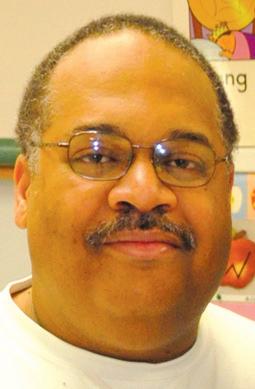
Tatum is having another big season in which he is averaging 25.9 points, 8.4 rebounds and 4.1 assists per game. He is shooting 43% from the field, 33% from 3-point range and 85% from the free throw line in leading the Celtics to a 28-25 record.
The NBA All-Star Game Draft will be held on Feb. 10, with team captains LeBron James and Kevin Durant selecting the teams from the All-Star pool.
Renell Wren in Super Bowl
Renell Wren is headed to this weekend’s Super Bowl in Los Angeles as a member of the Cincinnati Bengals. A defensive lineman, Wren is a former Lutheran North standout who played his collegiate football at Arizona State University. He was selected by the Bengals in the fourth round of the NFL Draft in 2019. Good luck to him and the Bengals.
Chris Brooks digs Badgers
Standout wide receiver Chris Brooks
Jr. of St. Louis U. High has given a commitment to play college football at the University of Wisconsin. A 6’3” 210-pound receiver, Brooks had originally committed to Yale in December, but he changed course and will be headed to the Badgers and the Big Ten Conference. As a senior, Brooks had 49 receptions for 959 yards while rushing for 176 yards. He scored a total of 21 touchdowns in leading the Jr. Billikens to a 7-4 record and a berth in the Class 6, District 1 championship game.

SLU Billikens on the move
The Saint Louis Billikens have been on a nice run as the college basketball season enters the home stretch. The Billikens entered the week with
record in the Atlantic 10 Conference, good for second place. Standout point guard Yuri Collins has been leading the charge with his scoring and passing. He had 35 points and 13 assists and the game-winning
With Alvin A. Reid
at the buzzer in a dramatic double-overtime victory at George Mason last Wednesday.
last Sunday. Senior guard Saniah Tyler led IWA with 20 points en route to being named the Most Valuable Player of the tournament. Senior Eliza Maupin scored 24 points to lead Webster Groves. The Kansas State recruit had a tremendous performance.
• Vashon’s boys continued its stellar play against the top competition with a victory over Chicago Whitney Young at last Saturday’s Bank of O’Fallon Shootout. Whitney Young is one of the top-rated teams in the Chicago area. Junior guard Kennard Davis had a game-high 21 points to lead the Wolverines.
• CBC also picked up a big victory over a Chicago area power at O’Fallon as the Cadets defeated St. Rita 56-51. Senior guard Rob Martin scored a game-high 25 points to lead the Cadets to the victory.
*Games to Watch this Weekend Lift for Life at Whitfield, Friday, 6:45 p.m. Father Tolton at Cardinal Ritter, Friday, 7 p.m. MICDS at John Burroughs, Friday, 7 p.m. DeSmet at CBC, Saturday, 1 p.m. Westminster at Chaminade, Saturday, 2 p.m. Vashon at East St. Louis, Saturday, 7:30 p.m. Confluence Prep at Father Tolton, Saturday, 8:30 p.m.
The late Curt Flood, St. Louis Cardinals Hall of Fame member and a man who changed Major League Baseball, did not prevail in his landmark lawsuit that challenged that game’s “reserve clause.” Flood lost. Baseball players would later win. Free agency became a reality and contracts worth hundreds of millions of dollars were on the way. Former Miami Dolphins head coach Brian Flores will find it difficult to win his bombshell discrimination lawsuit against three NFL teams and the league. Yet, like Flood, his legal challenge could change how business is done.
message from New England Patriots head coach Bill Belichick.
Three days before Flores’ interview with the Giants, Belichick accidentally texted Flores, congratulating him on winning the job. Whoops. Wrong Brian. Belichick thought he was texting Buffalo Bills offensive coordinator Brian Daboll, who got the Giants job.

Alvin A. Reid
Flores’ lawsuit claims he went through multiple “sham” head coaching interviews and was treated unfairly by the Dolphins during his three seasons there. The suit targets the Denver Broncos and New York Giants, too. As luck, or bad luck, would have it for Flores and the NFL, his decision to risk his coaching career hinges on a text
Flores found out first-hand in an offhand way he was interviewing for no reason because the job had already been filled. Flores said Broncos GM John Elway was an hour late for his scheduled interview, adding that Elway “looked disheveled” and “not interested.” The Broncos hired Nathaniel Hackett.
“It was a range of emotions,” Flores told CBS. “Humiliation, disbelief, anger. I’ve worked so hard to get to where I am in football to become a head coach. Put 18 years in this league, and to go on what was a sham interview, I was hurt.

“We’re at a fork in the road right now. We’re either gonna keep it the way it is, or we’re gonna go in another direction and actually make some real change.”
The 58-page lawsuit Complaint-against-NationalFootball-League-et-al-Filed.pdf (wigdorlaw.com) is well worth reading. It does contain a curse word right off the top from Belichick’s text message.
As Curt Flood’s lawsuit did for Major League Baseball, former Miami Dolphins head coach Brian Flores’ legal challenge against three NFL teams could change how business is done.
Texans in Lovie
Former Chicago Bears, Tampa Bay Buccaneers and University of Illinois head coach Lovie Smith has been tabbed as the Houston Texans head coach. He replaces the fired David Culley and brings the number of Black NFL head coaches to three –the same number the 2021 season ended with.
Dolphins owner Stephen
Ross, a pal of the immediate past president, is a point man in Flores’ lawsuit. Ross has a Black general manager, Chris Grier, and his new head coach is bi-racial.
The Dolphins hired Mike McDaniel, whose father is Black, to take over for the fired Flores. McDaniel has been coaching for 15 years but served just one season as offensive coordinator for the San Francisco 49ers. He didn’t call plays last year, either. That responsibility was head coach Kyle Shanahan’s.
The Reid Roundup
Cross country skier Samuel Uduigowme Ikpefan and flag bearer Seun Adigun Nigeria’s first Summer and Winter Olympian and a candidate for the International Olympic Committee, marched in the Winter Olympics opening ceremony in fashion styled by Black-owned Houston based Actively Black. People ranked their outfits fourth behind Jamaica (Puma), Team USA (Ralph Lauren) and Team Canada (LuluLemon)… USA TODAY sports col-
umnist Bob Nightengale wrote this week, “While Brian Flores explosive and courageous class-action lawsuit against the NFL this past week drew everyone’s attention, his powerful claims could easily be shifted to another major sport, too. Yes, deplorable hiring practices are just as bad in Major League Baseball.” …Former St. Louis Rams safety and Hall of Fame member Aeneas Williams, a Southern University product, attended the NFL combine for HBCU players on Jan. 29, ““When scouts come and get a chance to see kids, talk to them, interview them, it’s a whole different thing. That’s what I’m excited about.” … Don’t get your hopes up for a swift end to the MLB players lockout. St. Louis Cardinals pitcher Adam Wainwright on Sunday told the Belleville News-Democrat “the owners current offer is far from a place we could start negotiations from. It would be interesting to see how fast something would be negotiated if they brought a more reasonable offer to the table to start.”
Program advances professional skills of diverse mid- and senior-level leaders
As part of its efforts to drive inclusive economic growth in the St. Louis metro, Greater St. Louis, Inc. is now accepting applications for the 2022-2023 cohort of its St. Louis Business Diversity Initiative (SLBDI) Fellows Experience. The year-long program addresses the challenges professionals of color face as they work to advance their careers. The Fellows Experience participants reflect on their goals, performance, operating styles, and how they adapt
to varied workplace cultures. Access to forums, social events, and conferences fosters a supportive professional and personal network essential to long-term growth and development.
The program runs from September 2022 through September 2023, and includes monthly full-day sessions throughout, as well as a onetime, three-day retreat and optional after-hours events.
The Fellows program was founded in 2006. Since then,
nearly 1,000 Fellows have completed the program, with 90% remaining in the metro.
• 70% of Fellows are promoted within two years of the program.
• 26% of Fellows are elected to boards or appointed to committees.
• Fellows contribute 1,600 hours of community service annually.
Greater St. Louis, Inc. is currently accepting applications through May 13, 2022. To qualify, applicants
Fund will provide $10,000 to
The BOSS Network, an online community of professional and entrepreneurial women who support each other through digital content, programs and eventbased networking, announces its BOSS Impact Fund. The BOSS Impact Fund will focus on investing in Black women led businesses and preparing
these entrepreneurs to build scalable, growth aggressive companies. Its goal is to raise investment funding for 500+ Black women entrepreneurs, over the next three years. As part of its efforts, The BOSS Network is partnering with Sage, the global market leader for technology that provides small and medium
businesses with the visibility, flexibility and efficiency to manage finances, operations and people, for the launch of the Sage “Invest in Progress” Grant Program. Sage and The BOSS Network are working together to remove the barriers that many entrepreneurs face by providing funding to support Black women entrepre-
must be ethnically, racially, or gender diverse mid- to seniorlevel professionals who have been employed a minimum of seven years, offer demonstrated community leadership, have a college degree or the equivalent skill and abilities, and be looking to develop their leadership and professional capabilities and capacity.
For more information on the SLBDI Fellows Experience, contact Rosalind Reese at 314-206-3224 or Rosalind@ GreaterStLouisInc.com

neurs in the first five years of their business.
Through the Sage “Invest in Progress” Grant Program, 25 Black women entrepreneurs will have the opportunity to receive a capital investment of $10,000 toward successfully starting and growing their business in addition to an entrepreneur-
ial mentor program in support of Black women-owned small businesses. To register or for more information, visit BOSSImpactFund.com. The deadline for submissions is Feb. 25. The Sage “Invest in Progress” Grant will also provide coaching, curriculum, and connections while removing capital barriers to help this group achieve success. Founded by CEO Cameka Smith, the mission of The BOSS Network, which stands for “Bringing Out Successful Sisters,” is to promote and encourage the small business spirit and career development of women of color.
Annual program connects students with scholarships while celebrating inspirational Black Americans
Regions Bank recently announced the launch of a scholarship contest that invites students to celebrate inspirational Black Americans by creating essays describing how their contributions have made a positive impact in various communities or around the world. While 2022 marks the eleventh year for the Regions Riding Forward Scholarship Contest, it marks the first year the contest has a video component. Further, the amount of scholarships awarded this year will be doubled when compared to the amount of scholarships awarded annually in previous years. Essays can
focus on any Black American who has inspired the applicant, from well-known, high-profile figures to relatives, educators, or other community members who have served as an inspiration in the student’s life.
Applications are currently being accepted, and the window for applications will

remain open through March 31, 2022.
High school seniors and college freshmen, sophomores, and juniors who are residents of (or who are currently enrolled in accredited colleges in) the 15 states that have Regions Bank full-service branches may apply.
Scholarships for winning essays are granted in the amounts of $5,000 for high school winners and $3,500 for college winners.
New this year, applicants can choose to submit either a written essay or a video essay. High school and college winners will be selected from both the video essay and written essay categories. For official rules, complete entry details, and eligibility requirements, visit the contest website at www.regions.com/ ridingforward. No purchase or banking relationship is required to enter the contest.


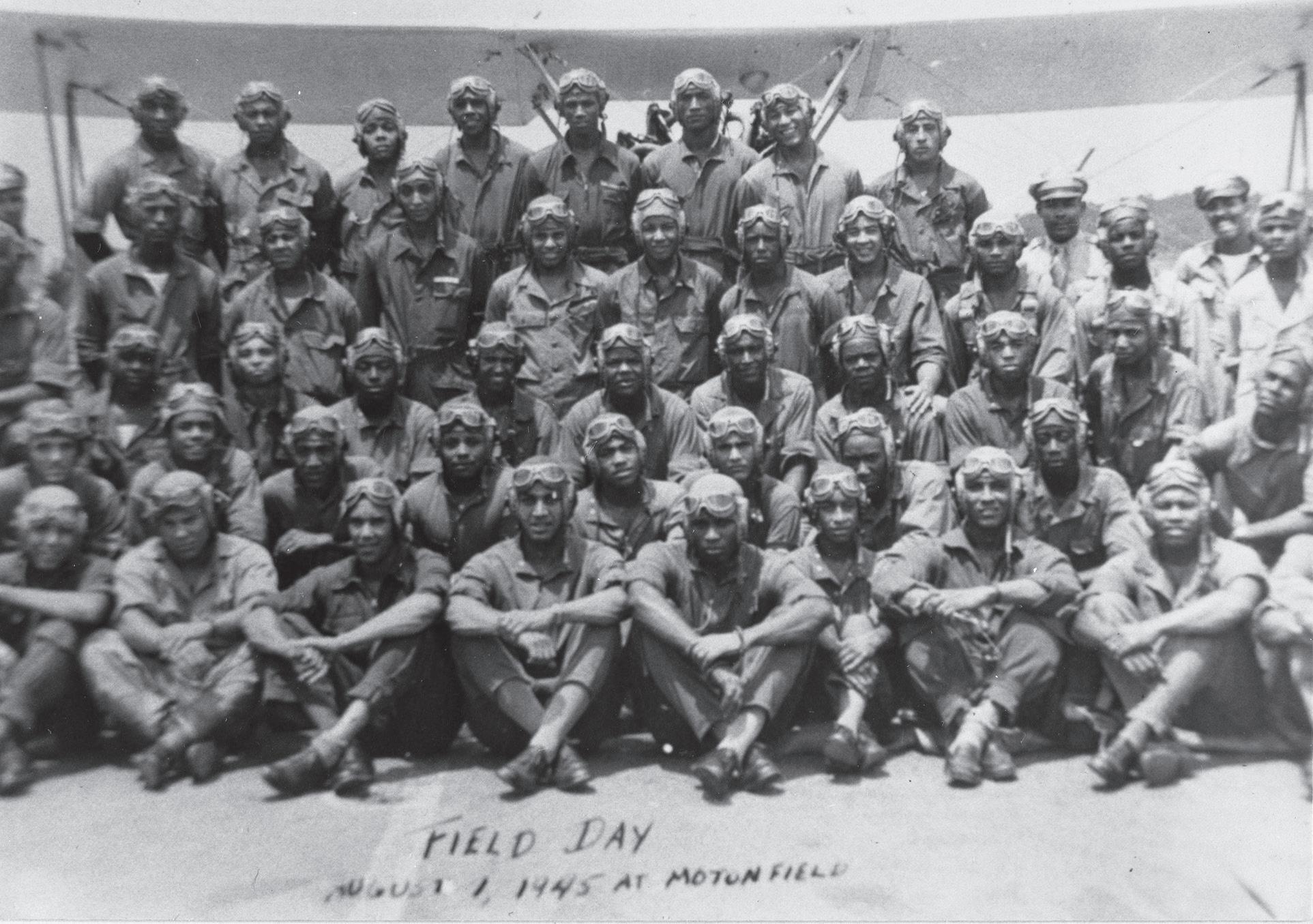
By the Missouri Historical Society
Known for their courage and determination during an era of segregated military service, the famed Tuskegee Airmen started training at Tuskegee Army Air Field in July 1941. Nearly 1,000 pilots and thousands more bombardiers, navigators, and support staff graduated from the all-black aviation program in Tuskegee, Alabama.
The Tuskegee Airmen served with distinction in the US Army Air Forces during World War II, where the red tails on their planes and their strong record as bomber escorts earned them the nicknames Red Tails and Red-Tail Angels.
The Tuskegee Airmen’s accomplishments helped pave the way for military integration, which started in 1948. More recently, they were awarded a Congressional Gold Medal, the highest civilian award presented by Congress. The medal itself cites an “outstanding combat record
[that] inspired revolutionary reform in the armed forces.”
Dozens of Tuskegee Airmen hailed from Missouri, and many of them called St. Louis home. Here are three of their stories.
Captain Charles White
Charles White grew up in St. Louis and was one of the first African Americans trained as a military airman at Tuskegee Army Air Field. He flew a P51-D Mustang known as Creamer’s Dream and was stationed in Ramatelli, Italy, in 1944.
Capt. White earned both the Distinguished Flying Cross and an Air Medal Distinguished Unit citation for his service during World War II. In an oral history, White described an intense bomber escort mission where the sky was “black with German aircraft” and he had to weave his way through dozens of planes. In that mission, White
took down two enemy planes. After fighting for freedom abroad, White’s experience as a Tuskegee Airman led him to be more outspoken about inequality at home. “If you fight and risk your life . . . then you want to make demands when you come back,” White said. Back in St. Louis, White served as a teacher and then a principal in the St. Louis Public Schools. He passed away in 2007.
Captain Wendell O. Pruitt
After graduating from Sumner High School and Lincoln University, Wendell O. Pruitt enlisted in the Army Air Corps and trained in Tuskegee, Alabama. He later served in the Mediterranean Theater as a fighter pilot.
Capt. Pruitt and Lt. Lee Archer became known as the Gruesome Twosome for racking up the
MVC has long history of being progressive


By K. Michael Jones The St. Louis American
The NCAA’s Missouri Valley Conference, headquartered in St. Louis, has a long history of breaking color barriers in college sports.
Throughout its long history, the Missouri Valley Conference has been a progressive force in intercollegiate athletics. MVC institutions were among the first to break the color barrier in college basketball, with the recruitment of Black student-athletes in the 1950s and 1960s, many years before schools in other regions of the country followed suit.
In 1962, MVC regular-season champ Cincinnati scored an historic first as the Bearcats open the NCAA Tournament title game against crosstown rival Ohio State with four Black players in the starting lineup. Just a year later, Loyola Chicago, an institution that would join the MVC a half century later, started four Black student-athletes against an all-white Mississippi State team in the second round of NCAA Tournament. This memorable showdown has been famously called the “Game of Change” due to the obvious racial overtones leading up to the contest.
Missouri Valley institutions also made NCAA Division I history with the hiring of the first ever Black head coaches in the sport of men’s basketball (Will Robinson at Illinois State) and football (Willie Jeffries at then-member Wichita State).
“The Valley has and will continue to be a pacesetter in this extremely important space,” says Commissioner Jeff Jackson. “As someone who has greatly benefited from having the opportunity to stand on the shoulders of many courageous Trail Blazers, I encourage everyone to reflect on and appreciate the important achievements and contributions of men and women of color not just in the MVC, but throughout all aspects of society.”
By Stacy M. Brown
NNPA Newswire Senior National Correspondent
He built his first telescope at the age of 10, and by age 25, George Carruthers earned a Ph.D. in aeronautical and astronautical engineering. Upon graduating from the University of Illinois, Dr. Carruthers started work at the U.S. Naval Research Laboratory.His telescope and image converter identified molecular hydrogen in space, and his ultraviolet spectrograph was used by the Apollo 16 crew in their flight to the moon.
“In March 1610, Galileo Galilei reported
the first use of a telescope to view mountains and maria on the moon,” Dr. Carruthers wrote in 1972. Many reported that his project collaborator, Thornton Page, a white man, acknowledged Carruthers’ brilliance and allowed him to lead on the project.
After all, just three years earlier, Dr. Carruthers was awarded a patent for his groundbreaking “Image Converter for Detecting Electromagnetic Radiation Especially in Short Wave Lengths.” Following that, the scientist’s UV telescope and image converter provided the first proof



Continued from C1
most air victories of any pair of Tuskegee pilots. Pruitt flew a P-47 Thunderbolt and was credited with shooting down three German planes over the course of 70 combat missions. He also helped sink a German destroyer, for which he received the Distinguished Flying Cross.
On December 12, 1944, the City of St. Louis celebrated Wendell O. Pruitt Day and commemorated Pruitt’s achievements with a ceremony held downtown. Pruitt then returned to Tuskegee as a flight instructor but was killed during
a training exercise just four months later. Pruitt was later chosen as one of the namesakes for the Pruitt-Igoe housing project in St. Louis. A school and two American Veteran Posts were also named in his honor.
Lieutenant Everett Bratcher
Originally from Poplar Bluff, Missouri, Everett Bratcher was fascinated by aviation from a young age. He attended Lincoln University and was one of the first graduates of the Civilian Pilot Training Program.
Bratcher enlisted at Jefferson Barracks in 1943 and served for three years as an Armament and
His father, George Sr., was a civil engineer with the U.S. Army Air Corps. and reportedly encouraged his son’s interest in science.
of molecular hydrogen in interstellar space.
His invention was used on Apr. 21, 1972, during the first lunar walk of the Apollo 16 mission.
It marked the first-time scientists examined the Earth’s atmosphere for concentrations of pollutants and see UV images of more than 550 stars, nebulae, and galaxies.
Dr. Carruthers earned NASA’s Exceptional Scientific Achievement Medal for his work on the project.
“On Apr. 21, 1972, the Apollo 16 commander positioned a somewhat more complex optical instrument at the Earth from the moon and obtained several remarkable photographs showing atmospheric rather than surface features,” Dr. Carruthers wrote.
One of the first and few Black scientists of his time, Dr. Carruthers died on Dec. 26, 2020, in Washington. He was 81.
Born Oct. 1, 1939, in Cincinnati, Ohio, Dr. Carruthers had three siblings.
According to his biography, the elder Carruthers died when Dr. Carruthers was just 12. After his death, the family moved to Chicago, where Dr. Carruthers’ mother, Sophia, went to work for the U.S. Postal Service.
But Dr. Carruthers continued pursuing his interest in science.
“As one of only a handful of African-Americans competing in Chicago’s high school science fairs, he won three awards, including first prize for a telescope that he designed and built,” his biographers wrote.
In 1957, Carruthers graduated from Chicago’s Englewood High School and entered the engineering program at the University of Illinois’ Champaign-Urbana campus.
While an undergraduate, Carruthers focused on aerospace engineering and astronomy.
After earning a bachelor’s degree in physics in 1961, Carruthers remained at the University of Illinois, where he earned a master’s in nuclear
Chemical Officer. He supervised air and ground crew units in Tuskegee, Alabama; Walterboro, South Carolina; and Scott Field, Illinois. After the war, Bratcher tried to work as both a commercial pilot and an air traffic controller but had difficulty advancing due to perceived racism. Ultimately, he became a civilian cartographer for the Defense Mapping Agency, a position he held for 35 years.
As a member of the Scott Air Force Flying Club, Bratcher continued to fly planes recreationally for many years, until his eyesight declined. Lt. Bratcher passed away in 2015 at the Missouri Veterans Home in St. Louis.
engineering in 1962. In 1964, he earned a Ph.D. in aeronautical and astronautical engineering.
In a 1992 interview with the American Institute of Physics, Dr. Carruthers was asked whether it takes anything different to get an African American student interested in science instead of a white child.
“One of the things that most people agree on is just giving them lectures is not really very effective. In other words, if you say that you are going to give a lecture on space science, that is too much like what they already get in school, so it is not going to make a lasting impression on them or necessarily attract them to the field,” Dr. Carruthers stated.
“So, what we have been trying to do is give them hands-on activities, use videos and demonstrations that get across information in a way that’s more like entertainment, because certainly students are interested in seeing science fiction movies on television, they like to see ‘Star Trek’ and ‘Star Wars’ and ‘Battlestar Galactica.’ So, what we’re trying to do is cast real science in a way that’s as attractive to them as science fiction is.”
By Missouri S&T
A Missouri University of Science and Technology history professor has recently made new discoveries about the life and work of America’s first Black newspaperman.
Peter Fleet, a slave, was the typesetter for an early Boston newspaper. In an article featured in the journal Slavery and Abolition, Dr. Justin Pope, assistant professor of history and political science at Missouri S&T, examines Fleet’s life through the wording of his will and the newspaper the enslaved man helped to print.
“Fleet was one of the first Black newspapermen in early America,” says Pope. “But few people have ever heard of him.”
While searching for rumors of slave unrest in colonial newspapers, Pope noticed the Boston Evening-Post printed more stories of slave rebellion than any other in New England. Pope says he was surprised to discover that a slave set the type for those stories.

As the enslaved typesetter of the Boston Evening-Post, Fleet composed more stories of slave unrest than any newspaper in New England during his time at the press, Pope says. And Fleet’s labor in the print shop placed him at the center of communication regarding rumors of rebellion and freedom in the early British Atlantic.
“Fleet provides a fascinating connection between printed news and the Black communities of New England,” says Pope. “There are very few references to Black men and women reading newspapers in the first half of the 18th century. Historians cannot be sure that Black Britons had any knowledge of published reports of resistance, uprisings or stories of freedom that appeared in British newspapers. Fleet’s place at the print shop represents just such knowledge of the public prints.”
Newspapers did not have reporters in the 18th
century – printers and their apprentices were mostly confined to their shops.
At the Evening-Post, Fleet performed the work of a printer’s apprentice, setting the type and carving the woodcuts or illustrations.
“The paper published stories about Black people that did not appear in other newspapers, such as a rare report of a Black family in Rhode Island that purchased their way out of slavery and bought transport back to West Africa in 1734,” says Pope.
Pope says he was also surprised to learn that Fleet had dictated a will before his death.
“Fleet’s may be the earliest known will created by a Black slave in the English-speaking world,” Pope argues. “Fleet used his will to try and leave something for his son and his master’s children. It shows an enslaved man fighting to own some part of his labor.”
Historians have known about Fleet’s will since 1924 because it was transcribed from a private collection, but scholars rediscovered the original copy at the Massachusetts Society only a few years ago.
“Having access to the original document has offered surprising insights into Fleet’s life and work in the print shop,” Pope says. “Examining the manuscript, I could tell that Fleet dictated his will rather than wrote it himself because Fleet’s signature did not match the script. Fleet’s friend, a young white Bostonian, wrote the document and witnessed it.”
Pope says Fleet left a legacy for the history of printing.
“Fleet helped train a young, enslaved man named Pompey in the art of printing,” explains Pope. “During the Revolution, Pompey ran away to British lines and eventually joined an expedition to Sierra Leone in Africa. They brought the first printing press to Sub-Saharan Africa, and that journey began with the lessons in printing from Peter Fleet.”












































By Stacy M. Brown NNPA Newswire Senior National Correspondent
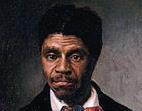


There’s little question that African Americans have been a significant part of Washington, DC’s civic life and identity since the city was first declared the new national capital in 1791. According to Cultural Tourism DC, African Americans were 25 percent of the population in 1800, and most of them were enslaved. While most were free by 1830, slavery was still in practice.
On April 16, 1862, nine months before President Abraham Lincoln issued the Emancipation Proclamation in January 1863, the U.S. Congress passed the District of Columbia Emancipation Act, making the District of Columbia’s slaves the first freed in the nation.
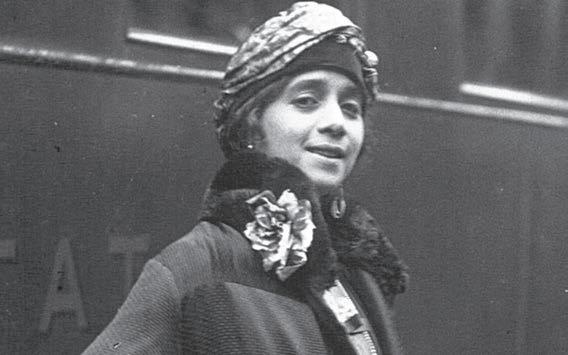
ing facade, Evanti performed before a desegregated audience.
Broadway.”

























African Americans flocked to the District, where the nightlife became famous, and U Street was the thriving center for Black culture and social exchange.
Reportedly, iconic figures like Zora Neale Hurston and Mary McLeod Bethune found refuge in what became known as Black Broadway. Performers like Louis Armstrong and Billie Holliday were regulars. And so was Madame Lillian Evanti.
Born Lillian Evans in D.C. in 1890, Evanti was the first African American to perform with a major European opera company. A Howard University graduate, she made her professional debut in Nice, France, in 1924 and adopted the stage name Evanti.
According to whitehousehistory.org, Evanti returned periodically to the District and performed on Lafayette Square several times in the 1920s and 1930s. At the Belasco Theater, a six-story building had a soar-
During one 1926 appearance, Marian Anderson joined Evanti for a performance before a football game between Howard and Lincoln universities. Later, Evanti performed for President Franklin D. Roosevelt and First Lady Eleanor Roosevelt. “She made me feel right at home,” Evanti reportedly said after chatting with the First Lady.
“That was a time when colored people – as we were known – could feel good, could have some hope that the world wasn’t all bad,” Cleveland McFadden, a Northern Virginia-based art collector and “sometimes historian” noted.
“We hadn’t ‘made it’ by any means, but you could feel D.C. was more home than just about any place in the United States,” McFadden offered.
“Singers and performers like Madame Evanti helped to take us different places in our minds and spirits. And, because she was from here, from the area, her impact was probably felt deeper than the superstars who visited and performed on Black
Whitehousehistory.org historians wrote that, on August 28, 1943, Evanti made her most acclaimed performance in the capital, portraying Violetta in the National Negro Opera Company’s La Traviata, which was staged on a barge floating in the Potomac River.
“Throughout the 1940s and 1950s, she traveled to Latin America as a good-will ambassador on cultural outreach journeys organized by the State Department and received decorations from the governments of the Dominican Republic, Haiti, Liberia, and Nigeria,” the historians wrote.
“Beginning in the mid1930s, Evanti was an advocate for the establishment of a national cultural center in Washington for classical and contemporary music, drama and dance – legislation establishing such a center was approved in 1958.” Evanti, a composer and a collector of works by African American artists, died in 1967 in Washington, DC.


St. Louis American staff
A list of highlighted events is below. A full schedule of events is available at www.slcl. org/black-history-celebration
7 p.m. Tuesday, February 15
IN-PERSON at the Florissant Valley Branch (195 New Florissant Rd. South)
The Black Rep Presents “Stamping, Shouting and Singing Home”
Inspired by the life of Sojourner Truth, this performance tells the story of her fictitious great-great-granddaughter Lizzie Walker, and her transformation from child to adult activist. Registration required.
7 p.m. Thursday, February 17
IN-PERSON at Library Headquarters (1640 S. Lindbergh Blvd.)
Author Event: Mashama Bailey and John O. Morisano
“Black, White, and The Grey: The Story of an Unexpected Friendship and a Beloved Restaurant.” Presented in partnership with Sauce Magazine.
7 p.m. Friday, February 18
IN-PERSON at the Florissant Valley Branch (195 New Florissant Rd. South)
Set the Night to Music

Enjoy a soulful performance and the smooth jazz styles of Robert Nelson & Renaissance. Registration required.
7 p.m. Friday, February 18
IN-PERSON at the Florissant Valley Branch (195 New Florissant Rd. South)
Was first Black high school basketball coach in Missouri to take team to state Final Four
By Frank Cusumano 5 On Your Side
Gift of Gospel
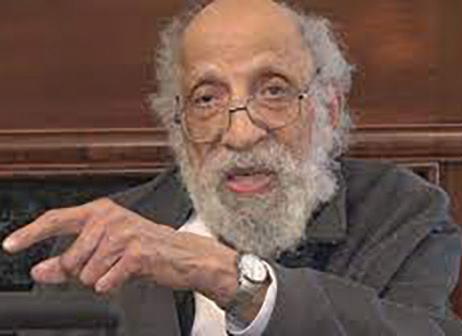
7 p.m. Tuesday, February 22.
IN-PERSON at the Lewis & Clark Branch (9909 LewisClark Blvd.)
The Black Rep Presents “Waiting for Martin”
A poignant and heartfelt tale of three homeless teens living in rural Alabama during the early sixties, patiently waiting for Dr. King to come, with the expectation that his visit would change their lives forever. Registration required.
Enjoy a soulful performance and the smooth jazz styles of Robert Nelson & Renaissance. Registration required.
7 p.m. Thursday, February 24
VIRTUAL
The Legacy of Dr. Venable
Celebrate the resilience of Dr. Howard P. Venable, an ophthalmologist and university professor who worked for equity in health, education, and legal justice. Registration required.
1 p.m. Saturday, February 26
IN-PERSON at the Florissant Valley Branch (195 New Florissant Rd. South)
Enjoy the melodious sounds of gospel music with Michelle Sargent, Daphne Rice-Bruce and Kathy Horry, and interpretive dance from Angelica LaGrone. Pastor Shaun Williams will serve as Master of Ceremonies. Registration required.
Program sites are accessible. Upon two weeks’ notice, accommodations will be made for persons with disabilities. Contact St. Louis County Library by phone 314-994-3300 or visit www.slcl.org
During Black History Month, AARP recognizes leaders taking action to give back and help build up their communities.
Hope Harley, Cofounder and President of the Board of Directors at the Bronx Children’s Museum, educates children in the area on the borough’s notable places, cultures, and history through dance, art, literature and science.
AARP believes the efforts of one person can truly make an impact. But when our efforts drive change for the greater good, we thrive together.
He is usually alone in his room. The only sounds you will hear come from ESPN on the television. It’s usually a basketball game. That’s because the sport was always a big part of the story of George Cross. He was a 6-foot-4 forward once for Illinois State. He says he wasn’t that good. He says that a lot about everything he did. However, George Cross was a really good high school basketball coach. In 1962, he became the first Black coach to lead a team to the Final Four in Missouri. Cross coached at Hadley Tech which later became Vashon. He coached from 1952 to 1969. In his final season, he guided the team to a 20-1 record. He had a basketball philosophy back then which would surely work today in all sports.
George Cross coached at Hadley Tech which later became Vashon. He coached from 1952 to 1969.
“I credit much of my success as an educator and coach to Mr. Cross. His impeccable mentorship to me on and off the court was immeasurable. As players, we were blessed to have someone like him in our young lives,” Irons said. Cross is 99 years old now. He moves pretty well and has a gentle smile for everybody in his residence at the Naomi House in Bridgeton. However, you can see the sadness in his eyes when he talks about the love of his life. Althea Cross died three years ago at age 94. They were married for 70 years. “I want to cry every time I think about her, but life goes on. I hope to join her in heaven because if there is a place for good people, she is there,” Cross said.
“I tried to communicate with my players without being derogatory and without attacking my players,” Cross said. Cross coached some of the best players from The Public High League who later became great coaches themselves. People like Jim Gant, the outstanding coach from Central High School and Floyd Irons, the legendary coach from Vashon.

Hope Harley, President of the Board Bronx Children’s Museum Bronx, NY To learn more about this community leader and their journey, visit aarp.org/blackcommunity
By The Missouri Historical Society
Brooklyn, Illinois, was established during the 1820s as a refuge for those escaping enslavement. Situated along the Mississippi River and directly across from St. Louis, Brooklyn became the hub of community and self-determination for many of its early residents. One of its founders was Priscilla Baltimore (affectionately known as “Mother”), an antislavery activist who dedicated her life to saving others. Baltimore was born in 1805, the daughter of an enslaved mother and a white enslaver from Bourbon, Kentucky. Some sources cite her early years in New Orleans. By the time Baltimore reached the St. Louis region, she had been bought and sold at least twice, including being sold by her enslaver father to a Methodist missionary for $1,100.
Although Baltimore wed during this period, her husband tragically died three weeks later due to cholera. When she married again, it was to an enslaved man named John Baltimore, who would help her found Brooklyn. Once Baltimore converted to Methodism, she was permitted to preach to enslaved men and women in the area. According to legend, her spiritual gift was so powerful that she was allowed to take 300 enslaved people to Illinois to participate
in religious services. Baltimore was an enterprising woman who held various jobs. She worked as a chambermaid on steamboats that traveled up and down the Mississippi River and as a domestic nurse to predominantly white families. At one point, she operated a ferry service, which transported food and other goods across the river. This work positioned Baltimore to achieve inspiring feats during the mid-1820s. After seven years of hard labor, Baltimore was able to purchase her freedom for the same price she had been sold for by her father. She continued to work after being liberated from bondage. According to legend, Baltimore bought a property in St. Louis and then mortgaged it to purchase the freedom of her husband and mother, who was still enslaved by her father. Once freed, Baltimore and her husband dedicated their lives to helping others in bondage escape to freedom.
By the late 1820s, Baltimore led a group of 11 families from St. Louis to the free state of Illinois, where they established a freedom village, which later became Brooklyn. This task wasn’t easy; although Illinois was a free state, laws known as Black Codes were designed to hinder African Americans. The Illinois Black Code of 1829 states that “No colored person who was not a citizen of
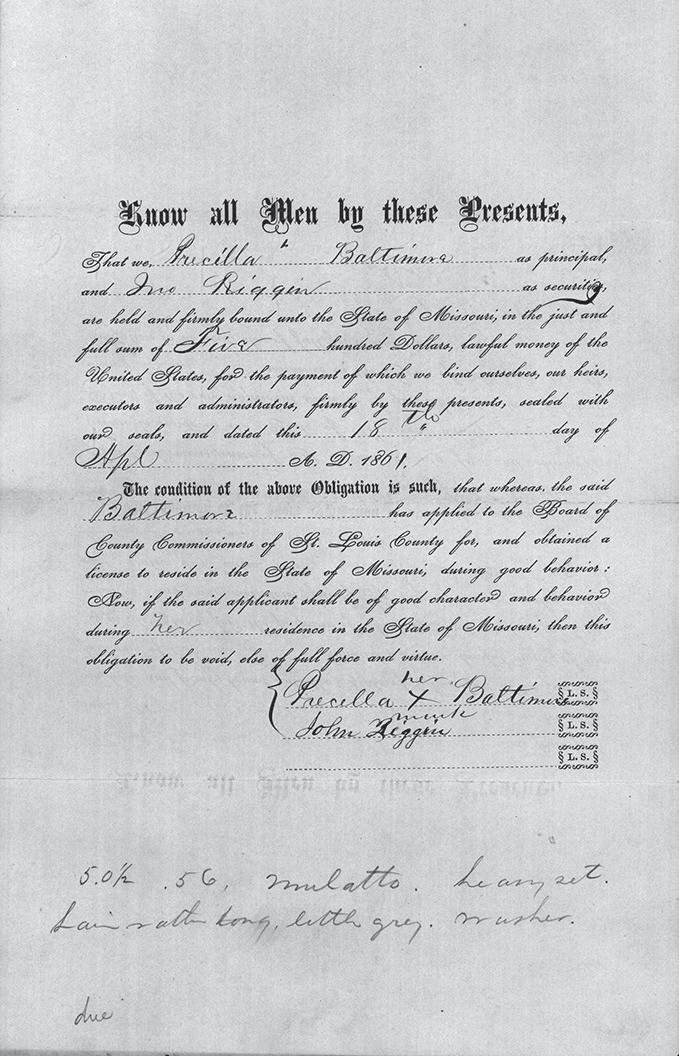
another state could gain a residence in Illinois without first filing a certificate of freedom in the county commissioners court

and giving $1000 that would be self-supporting.” Additionally, any person who harbored or hired a Black person who
hadn’t followed the law would be fined $500. But knowing the risks that were involved in helping enslaved people escape captivity didn’t stop Baltimore from creating a haven for them. Shortly after assuming her role as an early founder of the town, the new settlement began to take shape. Although the town was settled around 1829, it took many years for the Baltimores to secure funding to purchase the land from Thomas Osburn, one of five white abolitionists who platted the area in 1837.
While Black Codes in Illinois circumscribed the rights of African Americans in many ways, the Town Plat Act contained no racial restrictions.
Town founders were required to own land, survey it, and make a map available for the county surveyor. On December 5, 1841, Priscilla and John Baltimore, along with a wealthy free Black artisan, became the first African American property owners in Brooklyn. The Baltimores purchased 23 lots in Brooklyn, one of which eventually became the home of the Brooklyn African Methodist Episcopal (AME) Church.
During the 1830s, Bishop William Paul Quinn arrived in Brooklyn as a missionary minister for the AME Church.
Prior to his arrival, many of the town’s residents attended church at Baltimore’s home.
After receiving the blessing of Baltimore and other families
in town, Quinn helped found the Brooklyn AME Church, which was later renamed Quinn Chapel AME in 1839. The church became an integral part of the community and served as part of the network of AME churches that formed the Underground Railroad in Illinois. As Brooklyn continued to grow, the community consisted of both African Americans and European Americans, but at the time of its incorporation in 1873, its population was predominantly African American. According to the 1880 census, Brooklyn was made up of 371 Black residents and 203 white residents, which distinguishes it as the first Black town in America to be incorporated under a state legal system. By the time Baltimore passed away in 1882, she had witnessed the evolution of her freedom settlement into a Black municipality. We owe a great debt



Dr. Patricia Era Bath was born November 4, 1942, in Harlem, New York. Her mother was an African slave and her father was an immigrant from Trinidad. In high school Bath was a National Science Foundation scholar
and her research was featured on the front page of The
Patricia Bath graduated with honors from Howard University College of Medicine in 1968 and was awarded the Edwin Watson Prize for Excellence in Ophthalmology. She was the first African-American to serve their residency at New York University. Bath then began a Corneal Fellowship program at Columbia University.
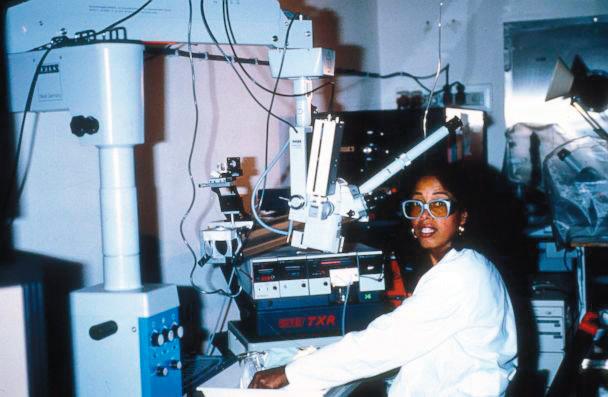

Her focus always remained ophthalmology, and the human eye would be her life’s work.
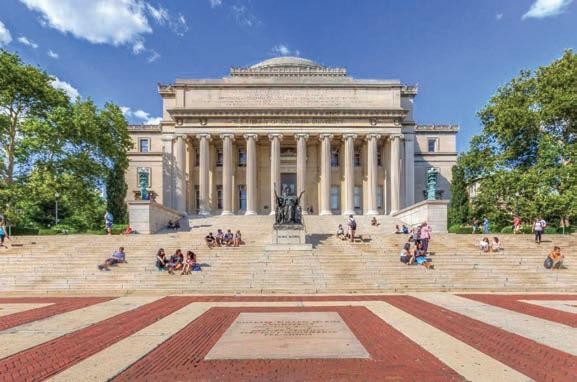






After Dr. Martin Luther King Jr. was assassinated, Bath dedicated her medical service to The Poor People’s campaign, one of King’s dreams. Bath went on to found the American Institute for the prevention of Blindness.
Dr. Patricia Era Bath holds five patents and was the first African-American woman doctor to receive a patent for a medical purpose. She invented laser cataract surgery and her invention called Laserphaco Probe healed her patients’ sight and revolutionized ophthalmology.

By Wendy Todd UMSL Daily
The University of Missouri–St. Louis has a long history of celebrating Black History Month and providing a variety of events for students, faculty and staff to engage in, learn from and enjoy.
This year’s celebration kicked off Tuesday afternoon with a viewing of the “King Richard“, a biographical account of Richard Williams, father of the tennis stars, Serena and Venus Williams, in the Student Government Association Chamber in the Millennium Student Center.
It was one of several planned events tied to the national Black History Month theme of Black Health and Wellness. This month’s lineup will also feature a discussion about black mental health and trap yoga sessions.
“I’m just so appreciative and excited about what the committee was able to put together this year,” said Ariana Smith, coordinator of LGBTQ+ Initiatives in the Office of Student Involvement. “We have 16 different events on the schedule this month. I think people are just really excited about bringing culture, history and Black excellence to this campus. I think the planning committee has been amazing about pivoting from all the Covid protocols when needed and are honestly excited about bringing some impact to campus.”
Black History Month was developed from an effort launched by Carter G. Woodson, a historian and scholar known as the “father of Black history.” In 1926 he set out to designate a period of time where Black history would be highlighted and taught in public schools. He

organized the effort with other historians via the Association for the Study of African American Life and History, of which he was president. It began as “Negro History Week,” had a theme and took place during the second week in February, coinciding with the birthdays of Abraham Lincoln and Frederick Douglass. More than three decades later, the week evolved into what we now know as Black History Month, which President Gerald R. Ford formally recognized nationally in 1976. The month commemorates Black history, achievement and contribution and is celebrated throughout the country, in organizations and institutions. Kent State University was the first
university to observe it.
UMSL students in attendance at Tuesday’s kickoff event shared their thoughts about
amples of the Black experience.
“I grew up in a very mixed racial community so there wasn’t much uplifting, Black represen-
n Black History Month was developed from an effort launched by Carter G. Woodson, a historian and scholar known as the “father of Black history.”
what Black History Month means to them. Dejah Mason, who is a junior studying education, appreciates Black History Month as a supplement to her experience growing up that didn’t include many positive ex-
tation,” Mason said. “But now it is really cool seeing the history behind everything, what we’ve been through and the important people that have paved the way for our community.”
Cynthia Okoulatsongo, a
senior pursuing her BSN in the College of Nursing, has an African background but was raised in Italy. So she appreciates what she lovingly refers to as African History Month as a means to further connect to American history in a way she was unable to while living in a predominantly white environment. “African History Month is very important to me, especially being in a different country that didn’t have a lot of black culture, ” Okoulatsongo said, “When I came here I didn’t really know much about the people or the civil rights movement. It’s very interesting and cool to see people that look like me, the culture and all this new stuff I didn’t know. My family didn’t really know
Photo by Wendy Todd
because they’re not African American. So we need to incorporate that culture in our life too.”
While Black History Month is an opportunity for some to learn and be enriched about history and Black achievement, for many it’s a highlight in an effort to continuously affirm the value of African Americans and the African diaspora in this country. “Black History Month is everything,” said Krissi Henderson, a sophomore majoring in early education. “You have to have the mindset that it’s every year, every day. It shouldn’t just be one month. It’s about celebrating who we are, what we do and how we want to be –knowing that we’re important. We matter.”








Nationally, Black-owned businesses are seeing greatest rebound in wake of pandemic
By Maureen E. Brinkley
District Director, SBA St. Louis District Office Acting Regional Administrator, SBA Region VII
We can’t properly celebrate Black History Month without addressing Black business owners who made their marks on the history of our nation. There are many Black business owners, often former slaves or descendants of former slaves who made it big. We know some of these entrepreneurs by name-- Annie Malone, Madame C.J. Walker, John H. Johnson, and Reginald F. Lewis rose to financial success in the past. More recently, Daymond John, and Janice Bryant Howroyd have achieved great-
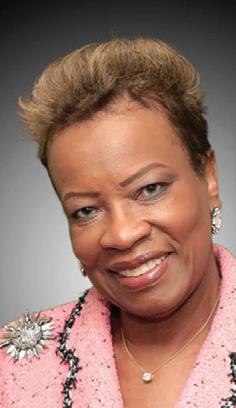
ness in business despite all obstacles. Oprah Winfrey, Tyler Perry, Michael Jordan, Beyonce, and George Foreman, among others, parlayed their fame into successful business empires. Every small business owner of color owes a debt of gratitude to those who came before him or her.
Locally, we recognize Elliott Henry, innovative founder of Unlimited Water Processing; Tameka Stigers, owner of the Locs of Glory Salon; Wilber A. Stuart II of Centrex Electrical Supply; Oscar Johnson, of O.J. Photo Supply; Brenda Newberry, of The Newberry Group; and Michael Kennedy, Sr., of KAI Enterprises, Inc.; all SBA successes. These current and former entrepreneurs exemplify excellence and pro-

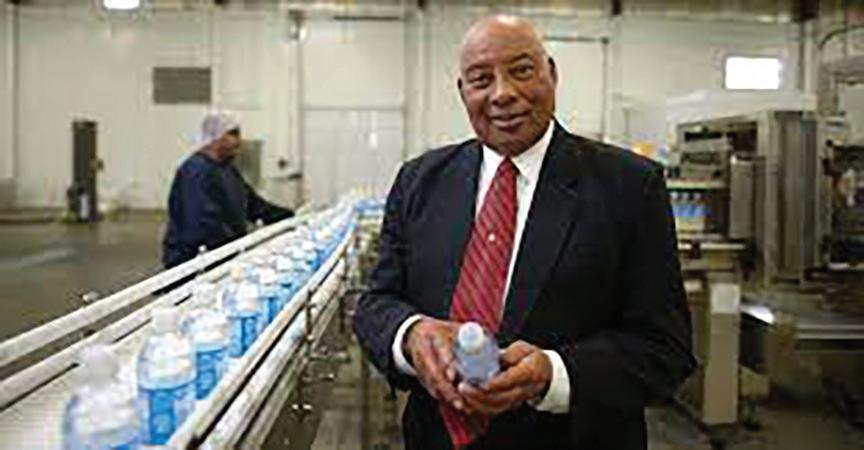
vide mentorship and role mod-
els for future Black business owners.
Almost all entrepreneurs must overcome obstacles on their way to success, but people of color usually have additional hurdles, and those who preceded us had even greater barriers. Minority small business owners continue to face issues such as lack as capital, role models, and business networks. However, there is help available. The U.S. Small Business Administration (SBA), their resource partners, and their lending network offer assistance to small business owners, including those of color.
SBA’s lending network includes most banks and credit unions, microlenders, and certified development companies. The three primary lending programs are Section 7(a) and
504 guaranteed loans (the lenders are guaranteed a percentage of the loan if the borrower defaults), and microloans. (See www.sba.gov/Loanprograms for more information.)
SBA’s resource partners include Small Business Development Centers (SBDCs), Women’s Business Centers (WBCs), SCORE, and Veteran’s Business Outreach Centers (VBOCs). These resource partners offer free counseling and technical assistance and free or low-cost training. We also work closely with the Procurement Technical Assistance Centers (PTACs), which assist clients with federal, state, and local government contracting at no cost. Last, but not least, is the assistance provided directly by SBA. We run several government contracting programs,
including the 8(a) Business Development Program, the Historically Underutilized Business Zone (HUBZone) program, the Women-Owned Small Business Federal Contracting program, and the SBA Mentor-Protégé program and Joint Ventures. (The U.S. Veteran’s Administration currently manages the VeteranOwned and Service-Disabled Veteran-Owned Small Business Programs). SBA also oversees the 7(j) Management and Technical Assistance Program and the Surety Bond Guarantee Program, which guarantees bid, performance, and payment surety bonds issued by certain surety companies. SBA district offices, including the SBA St. Louis District Office provide regular training. The St. Louis District Office has been privileged to host Emerging Leaders
for several years.
SBA St. Louis District Office engaged in a Strategic Alliance Memorandum with the Urban League of Metropolitan St. Louis, the first in the US. This resulted in the Urban League of Metropolitan St. Louis assuming the oversight of the Women’s Business Center in St. Louis. SBA district offices also assist the VBOCs with Boots to Business training for veterans,
or one of our
partners. The SBA St. Louis District Office can be
at www.sba.gov/mo/stlouis. We look forward to more successes to share during future Black History Months.


By James T. Ingram For the St. Louis American
You may never have heard the name Abraham Bolden. And despite being a name which should be synonymous with black history and Black History Month, his has been relegated, according to his accounts, to the ash heap of history by the United States government.
Today, he is an 87-yearold black man residing on the South Side of Chicago who hopes to clear his good name and reputation after a history of patriotism and service to America.
He was born into poverty in East St. Louis, IL, graduating from Lincoln High School, classmates with both my late mother and uncle. He later graduated from Lincoln University, then went on to serve four years as a decorated Illinois State Trooper.
His distinguished record caught the attention of President Dwight Eisenhower who, in 1959, appointed him to the United States Secret Service in Chicago where he received two commendations for his distinguished work in cracking counterfeit rings.
Then, on April 28,1961 his life took an historical turn when President John F. Kennedy attended a dinner with Mayor Richard Daley at Chicago’s McCormick Place Hotel.
Being a black agent, he was given the lowly assignment of guarding a basement toilet reserved exclusively for JFK. But that assignment literally
took him from the outhouse to the White House.
Upon emerging from the restroom Kennedy asked Bolden if there had ever been a black Secret Service agent at the White House.
One month later, history was made when Bolden was assigned to the White House Secret Service detail.
But what should have been a blessing soon became a curse for Bolden when, out of concern for JFK’s safety, he threatened to reveal the laxity in the agency’s security detail for the president.
Much of this is covered in Bolden’s 2008 memoir “The Echo from Dealey Plaza”. But I also had the honor of interviewing Mr. Bolden, recently, regarding his days on the Kennedy detail and the repercussions of his efforts to divulge what he knew. In our interview

which compromised Kennedy’s security.
After complaining about these flaws in the JFK security detail, as well as the segregated housing facilities for black agents during southern trips to James J. Rowley, head of the Secret Service, Bolden was demoted and sent back to the Chicago office. He’d only served three months on JFK’s security detail.

Mr. Bolden pulled no punches in describing much of Kennedy’s Secret Service detail as mostly “racist southerners” who despised JFK and his civil rights overtures and empathy toward the “negroes” during that time.
Bolden went on to state that one agent in particular said that “Somebody should blow his head off ”. He also alleged that many of the agents engaged in “excessive drinking and womanizing”, often reporting for duty unfit,
Fast forward to October of 1963, Bolden claims that Chicago Secret Service received a teletype, in advance of a visit by Kennedy, that a four-man Cuban hit squad from “a dissident Cuban group” with high-powered rifles would make an attempt on JFK’s life during his upcoming visit to Chicago on November 2, 1963, twenty days before Kennedy’s assassination in Dallas.
Following Kennedy’s assassination and the subsequent investigation by the Warren Commission, Bolden met with President Lyndon Johnson in 1964 to inform him of what he believed were alleged inaccuracies, omissions and misinformation. He was arrested upon leaving the White House and was eventually charged with discussing a bribe with two
known counterfeiters. He was convicted of accepting a bribe in 1966 and served three years of a six-year sentence.
Abraham Bolden believes that he was framed and alleges that it was in retaliation for his refusal to remain silent, regarding JFK’s assassination, which lead to trumped-up charges against him.
Now, after 57 years, he wants his name cleared and his record expunged. He’s reached out to U.S. presidents from Nixon to Obama, with no result.
When I asked him who he thinks was responsible for JFK’s assassination he stated, without equivocation that “It was an inside job”. That we may never know.
However, if you’d like to read more of his amazing story you may purchase his book, “The Echo from Dealey Plaza” on Amazon.
Or if you’d like to express your desire to have his record expunged you may reach out to East St. Louis native, Senator Richard Durbin at (202)2242152 or President Joseph Biden at (202)456-1414.
Every phone call matters and politicians only understand two things: money and votes. Let’s help Abraham Bolden reclaim his place in black history which, in this case, is American history.
Email: jtingram_1960@ yahoo.com Twitter@
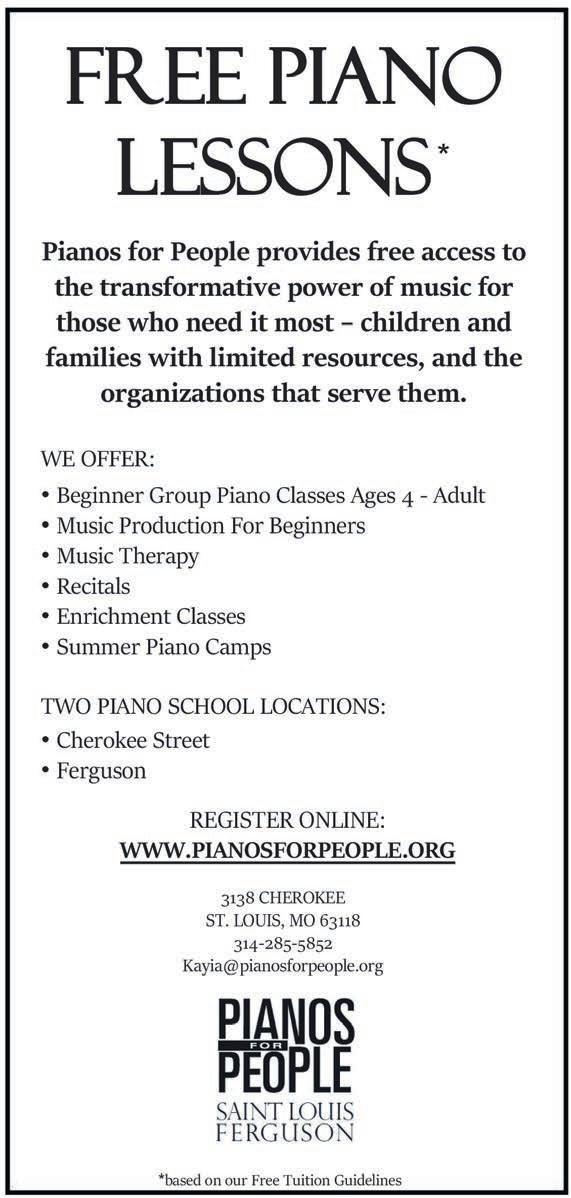
Mark your calendar for a virtual book discussion with author Malaika Horne, PhD, on her book Mother Wit –Exalting Motherhood while Honoring a Great Mother.

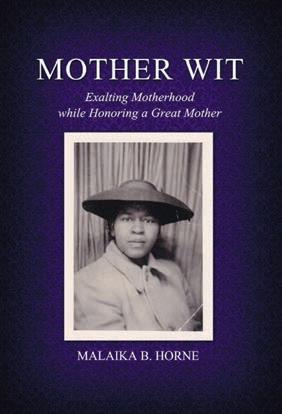
The author will read a short excerpt and then be joined by her sister Gwen Moore, curator at the Missouri Historical Society, followed by participant Q&A moderated by journalist Jade Harrell.


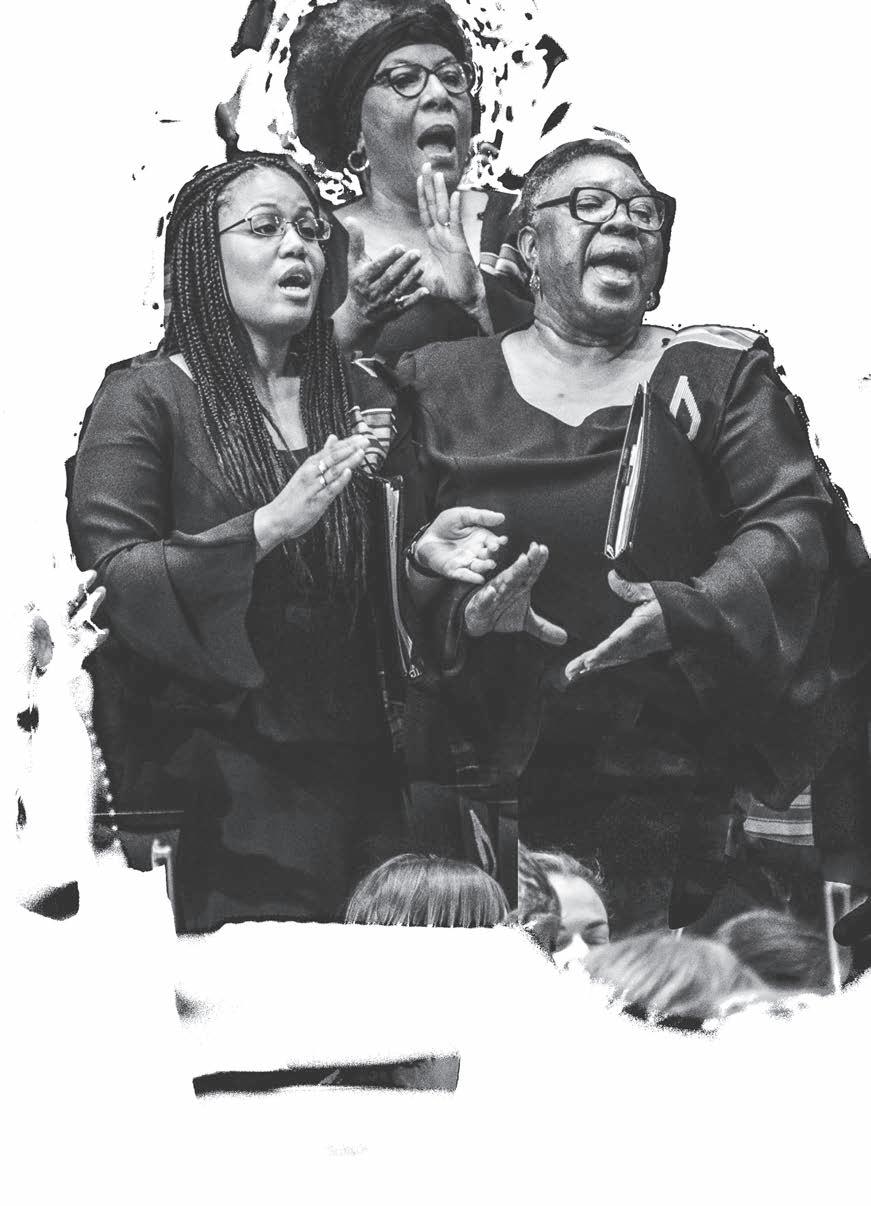
By WGU For The St. Louis American
This month, as we pay tribute to the generations of prominent African American leaders who have broken barriers and made significant contributions to our society – often while facing adversity and discrimination – it’s important to remember that people of color are still fighting for equal representation throughout the country.
While more opportunities exist for African Americans today than generations before, the injustices of racial and income inequality are still evident, especially when it comes to access to high-quality college education. That’s why nonprofit, fully online university WGU Missouri is committed to providing equal opportunities in higher education to all adults.
Now celebrating nine years since it was established in Missouri by Gov. Jay Nixon, WGU consistently receives recognition for its efforts educating and graduating minority student populations. The university is committed to providing students of all backgrounds with access to affordable, high-quality, career-boosting education. Most of the university’s students are underserved, and approximately 40 percent of graduates are among the first generation in their families to complete college. These students – who may not have otherwise been able to complete a degree through traditional means – have found success at WGU.
The university offers more than 60 bachelor’s and master’s degree programs in the high workforce need areas of business, education, IT and health

professions, including nursing. Its industry-leading, competency-based structure allows students to leverage previous education, training and work experience to graduate faster.
Most students work fulltime and raise families, and WGU’s innovative model allows them to move quickly through material they already know and focus on what they still need to learn, accelerating degree completion at low cost.
WGU’s tuition is about $3,800 per six-month term, and it provides scholarships to many new and returning students to make tuition even more affordable.
In honor of its 9th anniver-

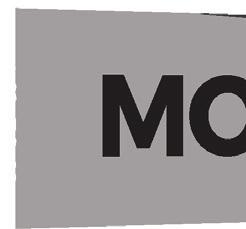

sary, WGU Missouri is awarding $450,000 in scholarships to new students enrolling in any of the university’s undergraduate or graduate degree programs. The scholarships – valued at $9,000 each – represent just one example of how WGU is working to make education more equitable by empowering adults to go back to school so they can advance their careers and change their lives.
To learn more about WGU Missouri, its scholarship initiatives, programs and its mission of making high-quality college education more accessible and affordable for all adults, visit Missouri.WGU.edu.


Join SLPL for a series of online adult, teens and kids programming throughout the month celebrating Black History Month and focusing on health and wellness.
REGISTRATION IS REQUIRED. Visit the Events Calendar at slpl.org for a list of programs and to register.
Made possible by St. Louis Public Library Foundation
february 25 friday at 7:30pm
Capathia Jenkins, vocalist Kevin McBeth, conductor St. Louis Symphony IN UNISON Chorus
Come together with the SLSO and IN UNISON Chorus to celebrate music of African American and African traditions, and their influence on St. Louis and the world. This annual evening of reflective and soulful music is one to remember.

second
By Danielle Brown
The St. Louis American
Rather than talk and complain without a solution in place, AK Brown, fashion stylist, and creative director said she saw the necessity for her Black in STL Fashion photoshoot project to not only advocate Black and brown visibility in the industry but also to celebrate them.
Brown she said she didn’t expect the inaugural editorial to receive the attention that it did, but she’s happy about it because it shows diversity and inclusion.
n Now that we have content for the group that make sense, people can put a face to what Black in STL Fashion is.
- AK Brown
This year’s shoot, “A Seat At Our [Black A**] Table launched on Feb.1 and showcases 22 Black fashion professionals and creatives, including Brown, in her PinkMuse magazine. It is set to be released March 16, and will only include Black in STL Fashion content. In addition to the photoshoot, video footage of the group was captured seated at a long dinner table. The video can be found on Brown’s Instagram @akbrownstl. It was challenging for Brown to narrow down her choices for the shoot, but she said word-of-mouth, social media, and connections she had already fostered helped.
“It’s really doing my own research because I don’t know everyone, there are people I still don’t know,” Brown said. “I’ve gotten backlash for the list I had last year. People said, ‘you should have this person or this person,’ but people don’t know who I have invited. Everybody I invited did not show up. You don’t know who I did include, who I had in mind for this project, all you see is the final project. My list is subjective but at the end of the day my opinion isn’t the final word.”
Dionna Stevenson, social media fashion influencer, and owner of Imaj (pronounced image) brand is one of the participants this year. She said she first fell in love with fashion at six years old, but she didn’t realize she could be an influencer. She initially thought her only path to making it in the industry was to be a


Tracie ‘Divine Tea’
Daily morning show spreads positivity, joy for all especially women and young girls
By Danielle Brown
The St. Louis American
Tracie ‘Divine Tea’ Berry-McGhee and Yolonda ‘Lady Yo’ Lankford both agree their daily motivational wellness morning show, “Own Your Now Show,” is divine timing.
“Owning your now is being a CEO before the pandemic or even a bus driver, but you have to own your now and it is enough,” Lankford said. The impact of a global coronavirus pandemic still plaguing the nation, civil unrest from George Floyd’s slaying, lives lost to COVID-19, and other causes of death, motivated Berry-McGhee to spread positivity with Facebook Live videos in 2020.
By

AK Brown
is hosting her second annual Black in STL Fashion
with the theme “A Seat At Our (Black A**) Table as a way to continue celebrating and highlighting Black fashion creatives and professionals in St. Louis.
“I went on Facebook Live and I got my cup of coffee as I do every morning,” Berry-McGhee said. “I start asking everybody what’s in your cup, is your cup full, is it overflowing, what’s going on?’ Then I gave an affirmation.”
Berry-McGhee said she began doing the videos every day, which sparked interest from Lankford and Alderwoman Shameem ‘MeMe’ Clark Hubbard (Ward 26), who not long after became her co-hosts.
Poet Justice Key, a former mentor in BerryMcGhee’s ‘I Define Me Movement’, part of her 501(c)(3) nonprofit organization SistaKeeper Empowerment Center, is the show’s fourth cohost.
Berry-McGhee said their first season functioned See AK, D8
Elim Chan is the kind of visiting conductor whom a symphony will build themes around with references to the Chinese calendar and the Asian Chamber of Commerce, as the St. Louis Symphony Orchestra did on Saturday night. So it was an interesting choice to pair her on the program’s opening piece with another featured artist, a guest soloist, who is not Asian and stole the show.
Multi-percussionist Martin Grubinger, from the distinctly non-Asian city of Salzburg, Austria, did steal the show in a piece by an Asian composer, “The Tears of Nature” by Tan Dun (born in 1957 in Changsha, China). And it was inevitable that Grubinger would snare the spotlight from the featured conductor and orchestra because this is a show piece composed for him.
“While composing I thought about nature,” Tan Dun writes in the program notes,” and
focused on the passion of Martin Grubinger.”
The passion and the athleticism, that is - Grubinger prowled the Powell Hall stage during the performance like the tiger that also came to Tan Dun’s mind in composing the notes.
A percussion concerto that meditates on nature might be expected to depart from the calmer aspect of nature that can be evoked by strings

See SLSO, C8 Conductor Elim Chan



St. Louis Convention and Visitors Commission
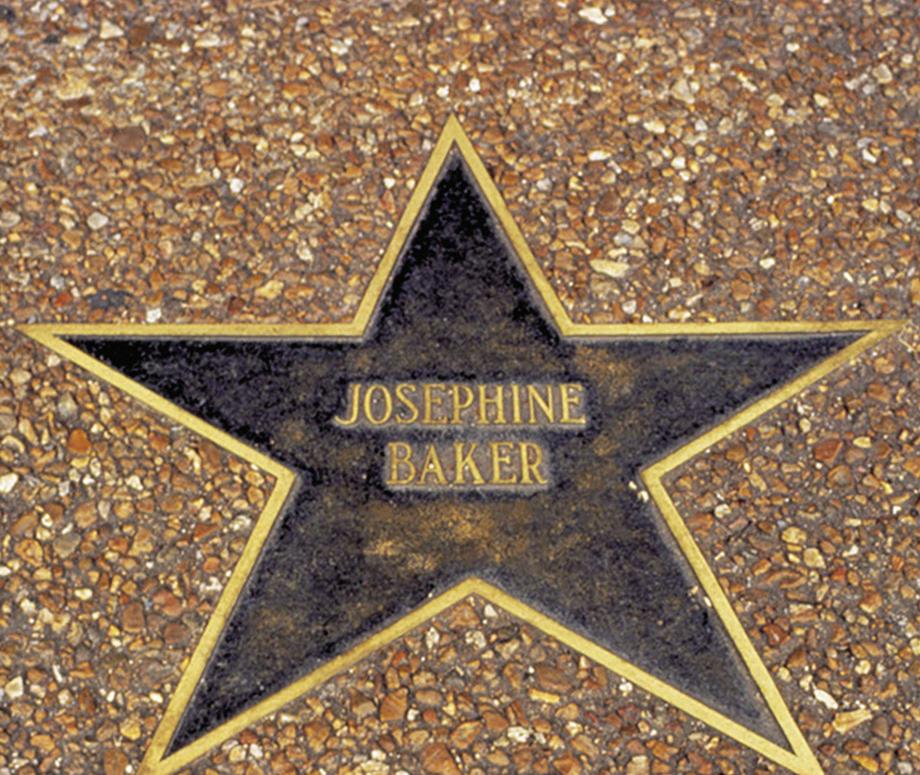
Photo courtesy of explorestlouis.com

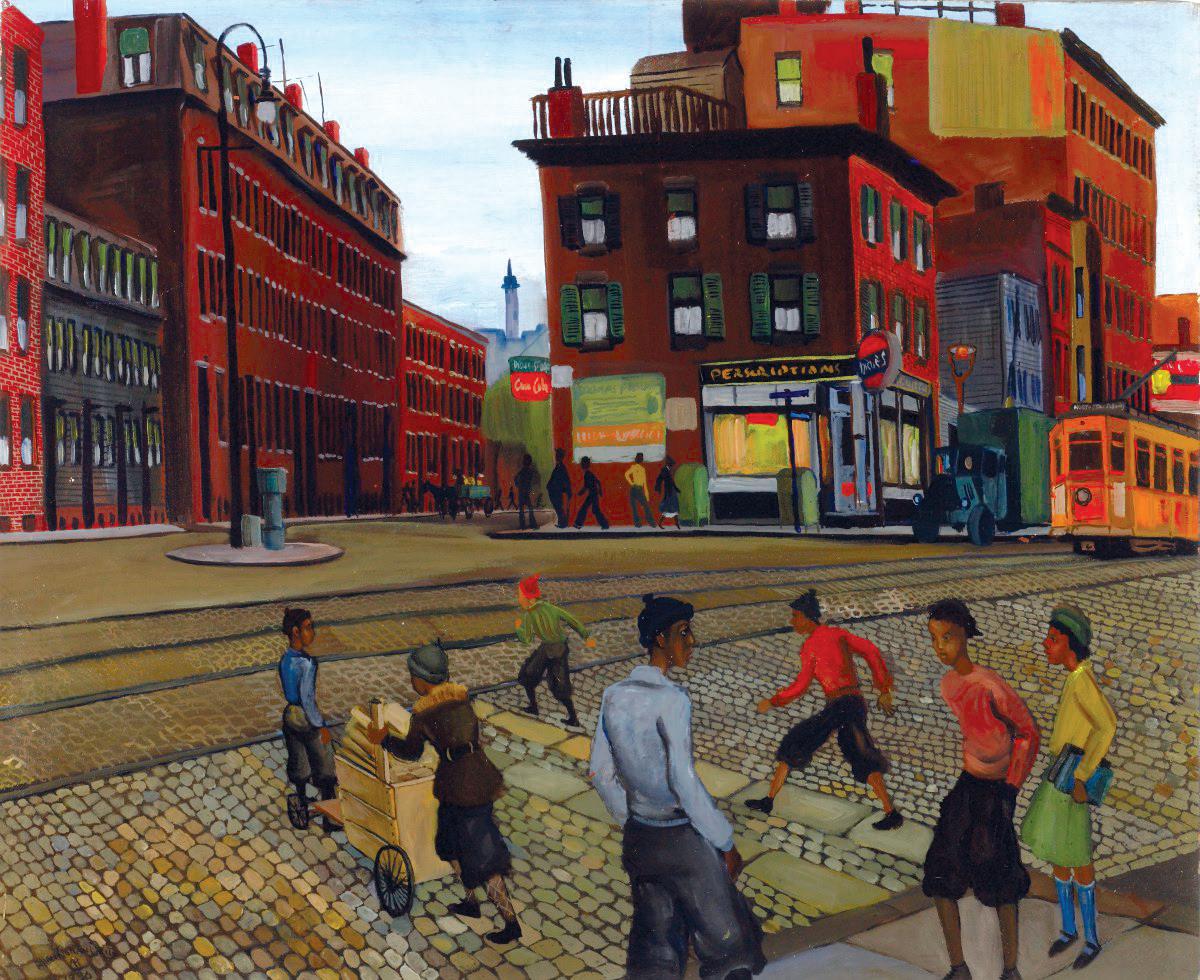
Photo courtesy of the Missouri Historical Society Collections
Allan Rohan Crite, American, 1910–2007; Douglass Square, 1936; oil on canvascovered artist’s board; 23 1/2 x 27 inches; Gift of the Federal Works Agency, Works Projects Administration 354:1943
By Barry Draper
Explore St. Louis
There are many historic sites to visit around St. Louis to help tell the stories of the past, both the struggles and achievements that got us here today. This month as you celebrate Black History Month, find ways to honor the rich culture and great achievements of African Americans in the Gateway City. Take a walkthrough history at these sites, events and attractions perfect for you and your family:
1. The St. Louis Walk of Fame is located along The Delmar Loop and honors notable people from St. Louis who made contributions to the culture of the United States. Visit the stars of notable African American figures such as Maya Angelou, Tina Turner, and Chuck Berry. All of the inductees were either born in the Greater St. Louis area or spent their formative or creative years here.
2. Nine PBS is sharing stories from the St. Louis community about trailblazing Black citizens who are from the region. Airing in February, these stories include In Their Own Words: Chuck Berry (February 1) and My Journey with Annie Malone: James Agbara Bryson (February 14).
3. Head to the National Blues Museum, located on Washington Ave between 6th and 7th streets and celebrate the genre as the foundation of all modern American music. Walk around and discover an entertaining environment that includes high impact technology driven experiences, a state-of-theart theater, and artifact-driven exhibits.
spent time there composing some of his famous songs.
6. Take a stroll through the George Washington Carver Garden at the Missouri Botanical Garden. The inspirational garden honors the life and accomplishments of the famous scientist who greatly influenced 19th and 20th-century agriculture and education. The focal point of the garden is a life-size bronze statue of Carver sculpted by Tina Allen. The garden is one and a half acres and features inspirational inscriptions from Carver’s writings and speeches, a reflecting pool and is landscaped with viburnums, hydrangeas, and holly trees to give it an intimate feel.
7. Check out the Missouri History Museum for Black history programming throughout the month. Their newest addition of “See STL Walking Tours” includes a walking tour of “The Ville” which is home to several Grammy Award winners, rock and roll hall of famers, Kennedy Center honorees, one of the first Black woman millionaires, three Grand Slam titleholders, and the founder of the first Black collegiate sorority. Ebony and Jet were the magazines to read for Black perspectives on lifestyle, culture, and politics during the heyday of the magazine industry.

8. The Contemporary Art Museum St. Louis hosts a community conversation about these two iconic publications for its free program. We ask the question, what does Ebony and Jet mean to you? Before or after, check out acclaimed artist Lorna Simpson’s videos on CAM’s street facade, which feature images from vintage editions of Ebony and Jet, enhanced with shimmering, watercolor hairdos.
The Saint Louis Art Museum’s global collection celebrates people’s creativity around the world every day. With more than 30,000 works of art across all times and continents, new, engaging, and educational experiences always await visitors at the Art Museum.
February has the distinction of being Black History Month, celebrating the achievements of African Americans as an integral part of U.S. history. The brainchild of noted historian Dr. Carter G. Woodson and other prominent African Americans, Black History Week was created by the Association for the Study of Negro Life and History (ASNLH), known today as the Association for the Study of African American Life and History (ASALH). It was announced in 1926 that the second week of February—coinciding with the birthdays of Abraham Lincoln and Frederick Douglass—would be Negro History Week. In 1976, the week of observance received U.S. government official recognition and expanded into Black History Month. Canada, Ireland and the United Kingdom also officially recognize Black History Month.
In celebration of Black History Month, the Museum’s February programming is an opportunity to bring ever greater attention to the thousands of works in the collection created by and about people of the African Diaspora. February kicked off with a virtual Zoom presentation cel-
ebrating renowned artist Elizabeth Catlett whose career as a visual artist, social advocate, and teacher spanned more than 60 years across the United States and Mexico. The program was presented on February 3 by Delyn Stephenson, the Museum’s 2021-2022 Romare Bearden Graduate Museum Fellow. If you missed it, check the Museum’s website for the YouTube recording, which is released with closed captions a few weeks after the live program.
Shaka Myrick, the inaugural two-year Romare Bearden Graduate Fellow (2021-2023), will take us on a virtual tour into the art and life of St. Louis Vashon High School graduate Oliver Lee Jackson. She will address Black stories and the importance of abstraction in contemporary art as she explores his techniques and narratives about historic Black experiences.
The Saint Louis Art Museum is returning to onsite programming. We invite you to join us on February 25 and February 26 for docent-led tours featuring art by Black artists with lively and engaging conversation. The tours are limited to 10 visitors on a first-come, first-served basis. The Museum is pleased to offer free posters of Allan Rohan Crite’s 1936 painting, Douglass Square Simply email renee.franklin@slam. org with the number of copies that you need for yourself, students, or group members.
Art Speaks: But You Feel Me
Thursday, February 10 | noon–1 pm CST | Free
4. Check out the St. Louis County Public Library’s website for the 2022 Black History Celebration Enriching Culture with Hope and Healing, including a variety of online educational and inspirational events throughout February. All events will be held virtually via Zoom or on the Library’s Facebook page.
5. Scott Joplin was a famous pianist and composer who achieved fame for his ragtime compositions. You can visit the house Joplin and his wife, Belle, lived in for some time. The Scott Joplin House State Historic Site plays some of his famous melodies as you walk through the modest flat on Delmar Boulevard. It is furnished and lit by gaslight as if it were 1902 when Joplin
9. Enjoy a night of music on Feb. 25 at Lift Every Voice: Black History Month Celebration performed by the St. Louis Symphony Orchestra. Starting at 7:30PM, the SLSO and IN UNISON Chorus will celebrate African American culture through reflective and soulful music. Kevin McBeth conducts this concert and Capathia Jenkins is the vocal soloist. There is so much rich history in our great city. Take some time this month to explore these attractions, embrace the culture of the city, and honor the lives and accomplishments of St. Louis’ most notable African American figures.
Join Shaka Myrick, the inaugural two-year Romare Bearden Graduate Fellow, as she discusses artworks by Oliver Lee Jackson, exploring his techniques and narratives about historic Black experiences. Visit slam.org to register to receive the Zoom link. The capacity for the live program is limited.
Drop-In Collection Tour:
Art by Black Artists
Join a Saint Louis Art Museum docent for a lively and engaging tour of the Museum’s collection. Tours begin in Sculpture Hall at the Information Center. Tours are limited to 10 visitors on a first-come, first-served basis.
St. Louis American staff
Tennessee pastor Willie McLaurin has been named interim president and CEO of the Southern Baptist Convention’s Executive Committee. This is the first time a Black person has headed the predominantly white denomination.
“My prayer is that this season will bring healing and unity to our convention,” McLaurin said in a release.
“When we love each other the way Jesus loves people, then we create the atmosphere for cooperation.”
The church’s executive committee is facing allegations of racism and mishandling of sexual abuse claims.
McLaurin said in the release his focus will be on the committee’s day-
to-day operations, including cooperating with the sexual abuse investigation task force.
“All of us here on this earth are interims, and I am humbled and honored to be selected and wholly dependent on the Lord to carry out His will in this time of transition,” he said.
McLaurin was named the committee’s vice president for Great Commission relations and mobilization in 2020. The position was created by the organization to focus on spreading the gospel and fostering relations with various demographic groups of Southern Baptists.
McLaurin worked at the Tennessee Baptist Mission Board for 15 years and previously held pastoral roles in churches in that state.
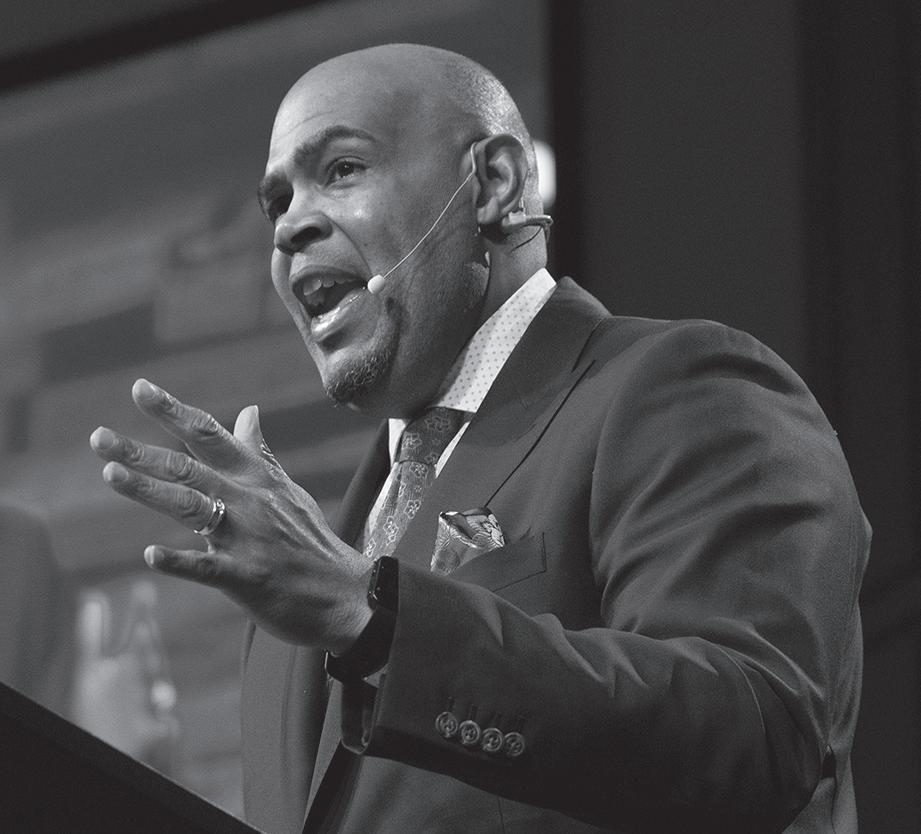
In June 2020, the Rev. Rolland Slade, senior pastor of Meridian Baptist Church in El Cajon, California, was elected as the first African American chair of the Southern Baptist Convention’s Executive Committee. The office runs the business of the nation’s largest Protestant denomination outside its annual meetings.
“We hope that he will help us to reset the tone by which the EC serves Southern Baptists,” Slade told the Baptist Press, the SBC’s news service. “Immediately before us is the challenge to regain the sense of trust of Southern Baptists.” Following Slade’s appointment, the Rev. Emmett G. Price III told Boston
Public Radio the organization has been dealing with issues of racism and sexism for years.
“The culture has been inbred to the fact that no matter if you have people of color who are pastors of churches, they’ll never get to be decisionmakers at the table,” said Price.
And you have women who have suffered tremendously, who have been horrifically traumatized, who have not received justice or even an opportunity to tell their story. So, at this moment, you have a couple of leaders choosing to move away from the centerpiece of that table.”
Russell Moore, leader of the Southern Baptist Convention’s public policy arm, left the position in June to join Christianity Today magazine. Two letters he sent to Southern Baptist leadership in which Moore described a culture of racism and mishandling of sexual abuse claims were leaked to the public.
“As George Floyd was an inflection point last year, this change right now is an inflection point for the Southern Baptist Church,” Price said.
You know, life at times can appear to be just one big roller coaster—a frightening one, at that! It’s full of twists and turns, people and events, ups and downs that would make anyone skeptical at best as to its purpose. Free will is supposed to have something to do with how we live our lives by the decisions we make or do not make.
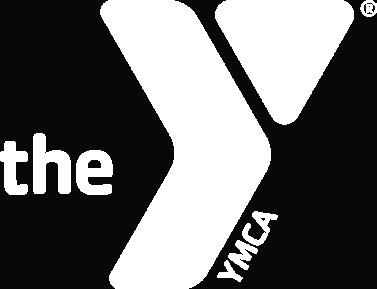
We find ourselves caught up in quagmires of discontent due to situations we created by simply making the wrong decisions, taking the wrong path or by making the wrong choice. Believe me. It can make your stomach turn.
That’s why I’m finding the subject of change in scripture so fascinating.
“In paths that they have not known,
I will guide them.” Isaiah 42:16 clearly indicates that when you attempt to change your life, seek God because divine help will be needed. Whenever someone in the Bible begins to accept God’s Word, change is inevitable, fear is prevalent, and faith gets challenged. I mean, walking by faith and not by sight is unnatural in the natural world. This kind of change in your spiritual life speaks to everything in your supernatural existence. Joshua 1:9 lets us know that from the moment we begin to expand our awareness of God, we must take Him everywhere we go or constantly lose ourselves to our own
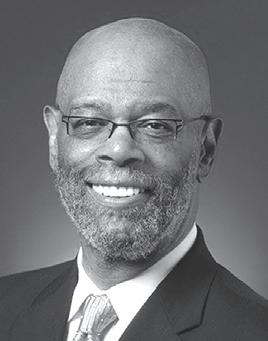
devices much like the Israelites in the desert. “Be not dismayed; for the Lord, thy God is with you wherever you go.”
The easiest thing to fall prey to in this life is all the temptations that come your way every day. I mean, we do live in a materialistic society that is framed in 30-second soundbites and news of instant wealth and fame and the pursuit of more. If there is no spiritual fallback position, one is forever caught up in defining oneself by how much you have, what you can buy and what pleasures you can exploit. Under those conditions alone, life will make you feel inadequate, alone,




and anxious. You see more is never enough. Spiritual awareness, now that’s different. “My presence shall go with you and give you rest.” Exodus 33:14. The understanding of eternal existence and the spiritual side of man, allows you to put into perspective the absurdities and contradictions in life.
Focus on God brings clarity to the soul and subsequently, order to chaos. Peace of mind abounds in the hearts of those who seek His truth.
Purpose is simplified and life becomes much easier to navigate. In this context, free will merely acts as confirmation of the obvious. “Whatever is born of God overcomes the world.” 1 John 5:4.
May God bless and keep you always.




Location:
Single Specialty Endoscopy Center located in Central West End
G. I Registered Nurse:
Skills:3-5 years of GI experience. ACLS certified. MO licensed. Detailed oriented, in assessment, implementing and recording, comprehensive nursing care in GI setting. Colonoscopy, with biopsy, EGD, PEG Resume: nanette.escueta@cweestl.org
G.I. Technician: Skills: GI experience. Knowledge, preparation, Set-Up, GI cases & Sterile technique. BLS certification. Decontamination and high-level disinfection. Preparation, GI set up, infection prevention and sterile techniques. Resume: nanette.escueta@cweestl.org
Medical Assistant (MA)
Requirements 2-3 years’ experience working in outpatient setting, BLS certification. Good people skills, Familiar with intake of insurance information, scheduling, follow up appointments, HIPPA, Privacy Act. Resume: rachel.demouchet@cweestl.org
The City of St. Louis is now accepting applications for Probationary Fire Private. Applicants must be at least 18 years of age. For more information or to apply, please visit the City website at http://stlouis-mo.gov/jobs
LAST DATE FOR FILING APPLICATION IS FEBRUARY 18, 2022
DIRECTOR OF PLANNING AND DEVELOPMENT SERVICES, CIVIL ENGINEER, PRINCIPAL CIVIL ENGINEER, AND MUNICIPAL SERVICE WORKER II-PARKS
The City of Clayton is now hiring for Director of Planning and Development Services, Civil Engineer, Principal Civil Engineer, and Municipal Service Worker II-Parks. Apply: www.claytonmo.gov EOE

The City of Jennings is accepting applications for the position of Administrative Assistant I in the Building Department. Duties include assisting with routine clerical and administrative work in answering phones, receiving the public, providing customer assistance, data processing, and bookkeeping. Assists in the sewer lateral program, processing permit applications, monitoring progress for status reports and maintaining records of the permit process. Minimum two years office experience required, with excellent clerical, computer and customer service skills and attention to detail. High school diploma or GED equivalent. Starting salary $31,152 (GS-10-C). Application available at Jennings City Hall or online at www.cityofjennings. org. Application and resume MUST be submitted together. NO RESUMES ACCEPTED WITHOUT COMPLETION OF OUR APPLICATION! Completed applications with resumes may be delivered to City Hall, mailed, emailed to jobs@cityofjennings.org or faxed to 314-388-3999.

Cor Jesu Academy, an all-girls’ Catholic college-preparatory school in Affton, is currently seeking applicants for the position of College Counselor beginning with the 2022-23 academic year. The College Counselor will be responsible for working closely with students and their families to educate and successfully guide them through the college search and application process. Offering information, resources and support for students/families in both group and one-on-one settings, Cor Jesu college counselors work collaboratively in seeking to assist each student in finding her “best fit” college choice. For more information, visit www.corjesu.org/careers#CCW or email Cynthia Wilhelm, Director of Cor Jesu’s Career, College and Wellness Center, at cwilhelm@corjesu.org
The City of Jennings is accepting applications for the position of Permit Clerk in the Building Department. Duties include serving customers in person and by phone, maintaining files, entering information into the computer and issuing permits. Good computer and customer service skills required, familiarity with building permits and zoning codes preferred. Hours of work are 8:30 a.m. to 5:00 p.m., Monday through Friday. Starting salary of $28,541 (GS-8). Application available at Jennings City Hall or online at www.cityofjennings.org Application and resume MUST be submitted together. NO RESUMES ACCEPTED WITHOUT COMPLETION OF
Full Description and Apply for this and other open positions at https://www. employmentstl.org/ come-work-with-us. Other positions include: Housing Specialist, Behavioral Health Career Specialist, Licensed Counselor. Also hiring for Patient Access and Environmental Services positions at major St. Louis area hospital.

ADVERTISE YOUR JOB OPPORUNITIES WITH US

Provide tier 1 technical software, hardware and network problem resolution to all SN computer users by performing question/ problem diagnosis and guiding users through step-by-step solutions.
To apply, please visit: https://www.safetynational.com/ careers-page/


Lead overall HR employee engagement initiatives for University, including recognition, employee appreciation and other related programs. This role manages communication and engagement personnel to ensure an integrated approach to overall HR communications and programming, aligning with the university’s branding and strategy. All initiatives serve more than 20,000 employees.
JR62067 Senior Career Counselor - Law School Responsible for creating and executing large scale initiatives to ensure career success for law students, as well as directing short and long term career strategies for a portfolio of students. Leads strategies and initiatives for highly ambitious students seeking jobs in a variety of areas. Collaborates closely with law school leadership to identify areas for program innovation and improvement. The successful candidate would meet the following required qualifications: Bachelor’s degree and five years’ experience in recruiting from the employer perspective or related experience.
Medical Assistant Apprenticeship- JR64741
How would you like to be a Medical Assistant, but don’t have time or the funds to go to school? We have a solution! Once you pass our entrance requirements and are hired through Washington University, you can complete our Apprenticeship program in just 12 weeks. Upon completing, and passing the credentialing exam, along with being a continued employee for 1 year, you will receive recognition as a Certified Medical Assistant. Class times will be during working hours (4 hours a week), and there will be no tuition costs to you.
JR61608 External Relations Associate - Office of the Vice Chancellor for Research
The External Relations Associate is responsible for the overseeing the implementation of the University’s External Professional Activities Policy and providing support the schools in implementing the policy. This person also serves as the lead preliminary reviewer of faculty disclosed external professional activities, and frequently engages with faculty, Deans, Department Chairs, and other delegated reviewers. This person develops educational content and resources to aid faculty and schools in meeting policy/procedural requirements the EPA policy. Required qualifications include advanced degree, MS or PhD in the life/biological science, medicine, biomedical engineering, engineering, or physical sciences; three years of work experience in a university or similar academic environment; demonstrated understanding of a research, academic, and regulatory environment, and ability to interpret regulations, policy and legal documents.
JR50607 Expedited Review Specialist - Human Research Protection Office Position is responsible for reviewing all proposed research for compliance with HIPAA and will also review expedited/exempt research including minimal risk continuing review for ethical and regulatory issues. Position will attend committee meetings to assist and educate committee members and make recommendations about privacy and risk issues. Will be responsible for letters to investigators whose proposals were reviewed as well as generating reports for meeting minutes. Required qualifications include bachelor’s degree; working knowledge of the federal regulations governing research, including the
Responses for St. Louis Community College on RFP B0004151 for EMS Equipment & Supplies will be received until 3:00 PM (CST) on March 4, 2022. Go to https://stlcc.bonfirehub.com for bid document and submission.
Notice is hereby given that the Metropolitan St. Louis Sewer District Requests for Quotes, Bids and Proposals are posted online for public download. Please navigate to www.msdprojectclear.org
> Doing Business With Us
> View Non-Capital Bids (commodities and services) or >Visit Planroom (capital construction bids)
Metropolitan St. Louis Sewer District is an Equal Opportunity Employer.
Alberici Constructors and the Saint Louis Zoo seek bids from qualified construction firms to submit proposals for a project at the Saint Louis Zoo WildCare Park. The project consists of the interior fitout of a barn and includes the following categories of work: Fencing, Concrete, General Trades, Insulation, HVAC, Plumbing and Electric.
To request bid documents, please send an E-mail to stlzoobids@alberici.com
La Salle Charter Schools, Inc. –Agreement Number 115-928 is accepting bids for cost+fee food service management companies for the 2022-23 school year. Bids are due by April 15, 2023 at 9:00am. There will be a walkthrough for bidders on March 1 at 10am. For a copy of the RFP, please contact Mike Hall at mhall@lasallemiddleschool.org
La Salle Charter Schools, Inc. reserves the right to reject any and all bids. La Salle Charter Schools, Inc. is an equal employment and educational opportunity institution.
INVITATION TO BID
FERGUSON-FLORISSANT SCHOOL DISTRICT DISTRICT WIDE FLOORING REPLACEMENT
Sealed bids for the above project are being requested from the Ferguson Florissant School District and will be received and publicly opened on Friday February 25, 2022 @ 1:30 pm CST at the Operation and Maintenance Dept. located at 8855 Dunn Rd. (REAR) Hazelwood, MO 63042. Pre Bid Meeting Friday February 18, 2022 @ 8:00 am at Wedgwood 6th grade Center 14275 New Halls ferry Rd. Florissant MO 63033. Bid specs must be obtained at http://new.fergflor.k12.mo.us/ facilities-rfq. Contact Matt Furfaro at mfurfaro@fergflor.org for further information/questions.
LOUIS
Responses for St. Louis Community College on RFP B0004154 for preplacement physicals & Immunizations will be received until 3:00 PM (CST) on March 4, 2022. Go to https:// stlcc.bonfirehub.com for bid document and submission.
The Saint Louis Zoo seeks bids from qualified firms to submit proposals for American Red Wolves Plaza RFP 2022. Bid documents are available as of 2/9/2022 on the Saint Louis Zoo website: stlzoo.org/vendor
Bids for REBID: Replace and Install Generator, Missouri State Highway Patrol General Headquarters, Project No. R2109-01, will be received by FMDC, State of MO, UNTIL 1:30 PM, 3/3/2022 via MissouriBUYS. Bidders must be registered to bid. For specific project information, go to: http://oa.mo.gov/ facilities
Bids for Replace 6 Gates & Controllers
Fulton Reception Diagnostic Correctional Center, Fulton, Missouri Project No. C1918-01 will be received by FMDC, State of MO, UNTIL 1:30 PM, March 3, 2022. For specific project information and ordering plans, go to: http://oa.mo.gov/ facilities
> Proposal for Elevator Services
> Proposals will be received by City of St. Louis Treasurer UNTIL 3:00PM 2/28/2022
> For specific project information, go to > https://www.stltreasurer.org/ Request for Proposals/
Sealed bids for the Dielman Road ARS Infrastructure project, St. Louis County Project No. AR-1554, will be received electronically thru the County’s Vendor Self Service portal at https://stlouiscountymovendors. munisselfservice.com/Vendors/ default.aspx, until 2:00 PM on March 9, 2022
Plans and specifications will be available on February 7, 2022 from the St. Louis County Web Site (www.stlouiscountymo.gov) or by contacting Cross Rhodes Print & Technologies, 2731 South Jefferson Avenue, St. Louis, Missouri 63118 (314) 678-0087.
DIRECTOR OF PROCUREMENT AND ADMINISTRATIVE SERVICES ST. LOUIS, COUNTY
Responses for St. Louis Community College on RFP B0004149 for Food Products, Utensils & small kitchen equipment will be received until 3:00 PM (CST) on March 4, 2022. Go to https://stlcc.bonfirehub.com for bid document and submission.
Great Rivers Greenway is soliciting bids for demolition of improvements at 571 Yarnell Rd. Fenton, MO 63026. Go to www.greatriversgreenway.org/ jobs-bids and submit by March 9, 2022.
Great Rivers Greenway is seeking bids from qualified firms to install seven (7) Eco-Counters and three (3) Bike Fix It Stations. Go to www.greatriversgreenway.org/ jobs-bids and submit by February 24, 2022.
BID NOTICE
Great Rivers Greenway is seeking an Administrative Assistant to join our Development Team. Go to www.greatriversgreenway.org/ jobs-bids and apply.
Paric Corporation is seeking proposals for the following project: THE BRIDGE APARTMENTS
PARIC Corporation is soliciting bids for the CORE AND SHELL ONLY for THE BRIDGE APARTMENTS. This is a five story structure located on Delmar Ave scheduled for a 04/1/2021 tentative construction start. Access to documents is available from our Smartbid link, if you have not received a bid invitation send your company information to tlalexaner@paric.com
The Core and Shell consisting of Site & Civil Drawings, Structural Foundation Drawings and Structural Steel. The last day for questions is currently 2/26/22. BIDS WILL BE DUE ON MARCH 03, 2022 Send all questions to Cory Paschen CPaschen@paric.com. Goals for Construction Business Enterprise
Goals for Workforce (field) participation
23% City of St Louis Resident
All bids should be delivered to Paric via e-mail (bids@ paric.com) or fax (636-561-9501).
PARIC CORPORATION IS AN EQUAL OPPORTUNITY EMPLOYER
Paric Corporation is seeking proposals for the following project: MU Teaching Hospital Renovations to 2W Dialysis Unit for The University of Missouri.
The scope of work includes but is not limited to Demo, Casework, Drywall Finishes, Fire Protection, Plumbing, HVAC and Electrical.
This project has a diversity participation goal of 10% MBE and 10% combined WBE, DBE, Veteran Owned Business and 3% SDVE.
Bids for this project are due on March 2, 2022, before 3:00 p.m. For any questions or would like to find out more detailed information on this opportunity, please contact John Davis at 314-704-6075 or jcdavis@paric.com.
All bids should be delivered to Paric via e-mail (bids@paric.com) or fax (636-561-9501).
PARIC CORPORATION IS AN EQUAL OPPORTUNITY EMPLOYER
CITY OF ST. LOUIS BOARD OF PUBLIC SERVICE
REQUEST FOR PROPOSALS for DISPOSAL OF SOLID “CLEAN FILL” for CITY OF ST. LOUIS – WATER DIVISION. Proposals are due by 11:00 A.M. CT, TUESDAY, MARCH 1, 2022 at Board of Public Service, 1200 Market, Room 301 City Hall, St. Louis, MO 63103. RFP may be obtained from the Board of Public Service website www.stl-bps.org under ON-LINE PLAN ROOM – Plan Room, or call City of St. Louis, Board of Public Service, at 314-589-6214.An Equal Opportunity and Affirmative Action Employer
CITY OF ST. LOUIS
CITY COUNSELOR’S OFFICE REQUEST FOR QUALIFICATIONS— OUTSIDE LEGAL SERVICES
Date of Issuance: January 19, 2022
Proposal Due: February 18, 2022 at 5:00 pm CST
The City of St. Louis has issued a Request for Qualifications (RFQ) to compile an approved list of law firms to perform various legal services at the request of the City Counselor. This RFQ may be found at https://www.stlouis-mo.gov/ government/departments/counselor/index.cfm under “Procurement”, on the City’s procurement page (https://www.stlouis-mo.gov/government/ procurement/), and by emailing Nancy Walsh at walshn@stlouis-mo.gov. The deadline for questions regarding the RFQ is Friday, February 11, 2022. The deadline for submitting a sealed statement of qualifications is 5:00 pm on Friday, February 18, 2022. The statements of qualifications must be submitted in strict accordance with the instructions in the RFQ. The City shall not be bound based on any SOQ/proposal submitted. Minority and Women-Owned Business Enterprises are encouraged to apply

Aging Ahead invites proposals for: multipurpose senior centers, alternative congregate sites, kosher home-delivered meals, legal services, ombudsman, and long-term care information within the counties of St. Louis, St. Charles, Jefferson, and Franklin.
Awards to be made are governed by Titles III of OAA regulations and specifications of U.S. Dept. of HHS, MO Div. of Senior and Disability Services and Aging Ahead Agency reserves the right to award multiple contracts within each program.
The total cost for all IIIB programs mentioned above is $428,996; the total cost for all IIIE programs is $12,814; 85% ($353,291) of IIIB and 75% ($8,543) of IIIE is funded through Contract # ERS10521008 from MO Dept. of Health & Senior Services and U.S. Dept. of Health & Human Services, Administration on Community Living. The remaining 15% ($75,705) IIIB and 25% ($4,271) IIIE is funded through non-Federal resources as a match requirement.
Contract period is July 1, 2022 to June 30, 2023. Contracts may be extended up to three fiscal years. Specifications and proposal packets may be obtained at Aging Ahead office beginning noon, February 21, 2022, 14535 Manchester Road, Manchester, Missouri, 63011, 636-207-0847 or online at https://www.agingahead.org/who-we-are/ financials/. Closing date for receipt of proposals is April 1, 2022 at 4:00pm. Agency reserves right to accept or reject any or all proposals.
REQUEST FOR QUALIFICATIONSSOLICITATION OF RD21-07 GENERAL ARCHITECTURAL AND ENGINEERING SERVICES
SOLICITATION NO: RD 21-07 ISSUE DATE: FEBRUARY 6, 2022
The St. Louis Housing
for modernization projects included in programs for Fiscal Years 2022, 2023, 2024, 2025 and 2026. All offers must comply with Section 3 requirements and MBE/WBE requirements.
Proposal documents will be available Tuesday, February 8, 2022 at https://www.slha.org/for-partners/vendors/ ormat www.questcdn.com under Login using QuestCDN eBidDoc# 7853077. Contact QuestCDN. com at 952-233-1632mor info@questcdn.com for assistance in membership registration, downloading this digital information and onlinesubmittal of your proposal.
A Pre-Proposal Conference will be held Tuesday February 22, 2022 at 2:00 PM (Local Time) via ZOOM at: https://us02web.zoom.us/j/81174460898?pwd=czRMQlh6aXRmT0Q1VmpKbEhmLzRGZz09
SLHA will receive sealed quotes for this service until 3:00 PM (CST), on Thursday March 10, 2022. Alana C. Green Executive Director AN EQUAL OPPORTUNITY EMPLOYER
Sealed bids for Bid 22-129 – Glock Handguns will be received by the City of St. Peters, Purchasing Department, City Hall, One St. Peters Centre Boulevard, P.O. Box 9, St. Peters, Missouri 63376 until 2:00 PM local time, Thursday, February 24, 2022 and then opened and read aloud.
Contract Documents will be available on Thursday, February 10, 2022, and may be obtained from the City of St. Peters, One St. Peters Centre Boulevard, St. Peters, MO 63376 or requested in writing to Bids@stpetersmo.net under the subject line “Bid 22-129 – Glock Handguns”.
All questions regarding this project shall be submitted to the City of St. Peters Purchasing Department in writing to Bids@stpetersmo.net under the subject line “Bid 22-129 – Glock Handguns” or by mail to City of St. Peters Purchasing Department, One St. Peters Centre Boulevard, P.O. Box 9, St. Peters, MO 63376 before noon local time, Thursday, February 17, 2022.The City reserves the right to waive any informality in bidding, and to accept the bid most advantageous to the City.
St. Louis County Port Authority will accept bids from qualified firms for demolition and site restoration services at the Former St. Louis County Family Courts Building (the “Project”) located at 501 S. Brentwood. Interested firms or joint ventures should submit one (1) original and two (2) copies of their fully completed and signed Bid Proposal, along with all required documentation, in a sealed envelope marked “CONFIDENTIAL: Proposal for Former Family Courts Demolition and Site Restoration Project” to the offices of Sandberg, Phoenix & von Gontard, P.C., 120 S. Central Ave., Suite 1600, Clayton, MO 63105, Attn: Andrew C. Ruben, by March 3, 2022 at 3:00 p.m. (CST) at which time the bids will be opened and read aloud. There will be a mandatory pre-bid meeting and walk-thru on Wednesday, February 16, 2022 at 9:00 a.m., at the Project site. The Project Request for Proposals may be obtained from the Port Authority’s web site at https://stlpartnership.com/ rfp-rfq/. Copies of all Contract Documents may be viewed or purchased at County Blue Reprographics, 811 Hanley Industrial Ct., St. Louis, MO 63144 (http://www. countyblue.com) or at Cross Rhodes Print & Technologies, 2731 S. Jefferson, St. Louis, MO 63118. All questions shall be submitted via email to Elizabeth Noonan at bnoonan@ced-solutions.com, no later than February 22, 2022 at 5:00 p.m. The Port Authority actively encourages submission of proposals from disadvantaged business enterprises and companies owned by minorities, women, immigrants and veterans. The Port Authority does not discriminate on the basis of race, color, religion, creed, sex, sexual orientation, gender identity, age, ancestry, national origin, disability or veteran status in consideration of this award. Equal Opportunity Employer.

REQUEST FOR PROPOSALS (RFP)
Service: Airport Landside Traffic Control Services
Pre-Proposal Meeting Date: February 2, 2022
Meeting will be held via Zoom. See RFP for details.
Question Due Date: February 3, 2022
Proposal Due Date: March 2, 2022
M/WBE Goals & Incentives:
MBE goals: 25% WBE goal: 5%.
A 15% M/WBE incentive credit shall be applied to the evaluation of professional service prime contracts who are currently certified MBE-African American, Hispanic American, Asian American, Native American and WBE-Women owned Business Enterprises.
Point of Contact: Briana Bryant– bnbryant@flystl.com
Proposal documents may be obtained at St. Louis Lambert International Airport, Airport Properties Division, Monday through Friday between 8:30 a.m. and 5:00 p.m., or by calling (314) 426-8174. This RFP may also be obtained by visiting our website at www.flystl.com/business/contract-opportunites
Robert Salarano Airport Properties Division Manager
St. Louis Community College will receive separate sealed bids for Contract No. F 22 401, Childcare Expansion and Athletics Renovation, St. Louis Community College at Forest Park, until 2:00 p.m. local time, Thursday, February 10, 2022. Bids will be opened and read by the Acting Manager of Engineering and Design, 5464 Highland Park Drive, St. Louis, MO 63110-1314 Specifications and bid forms may be obtained by emailing Angie James at ajames84@stlcc.edu
Pre-bid Meeting: Tuesday, February 1, 2022
9:30 a.m. South East side of Athletics Building at Forest Park Campus
An Equal Opportunity and Affirmative Action Employer
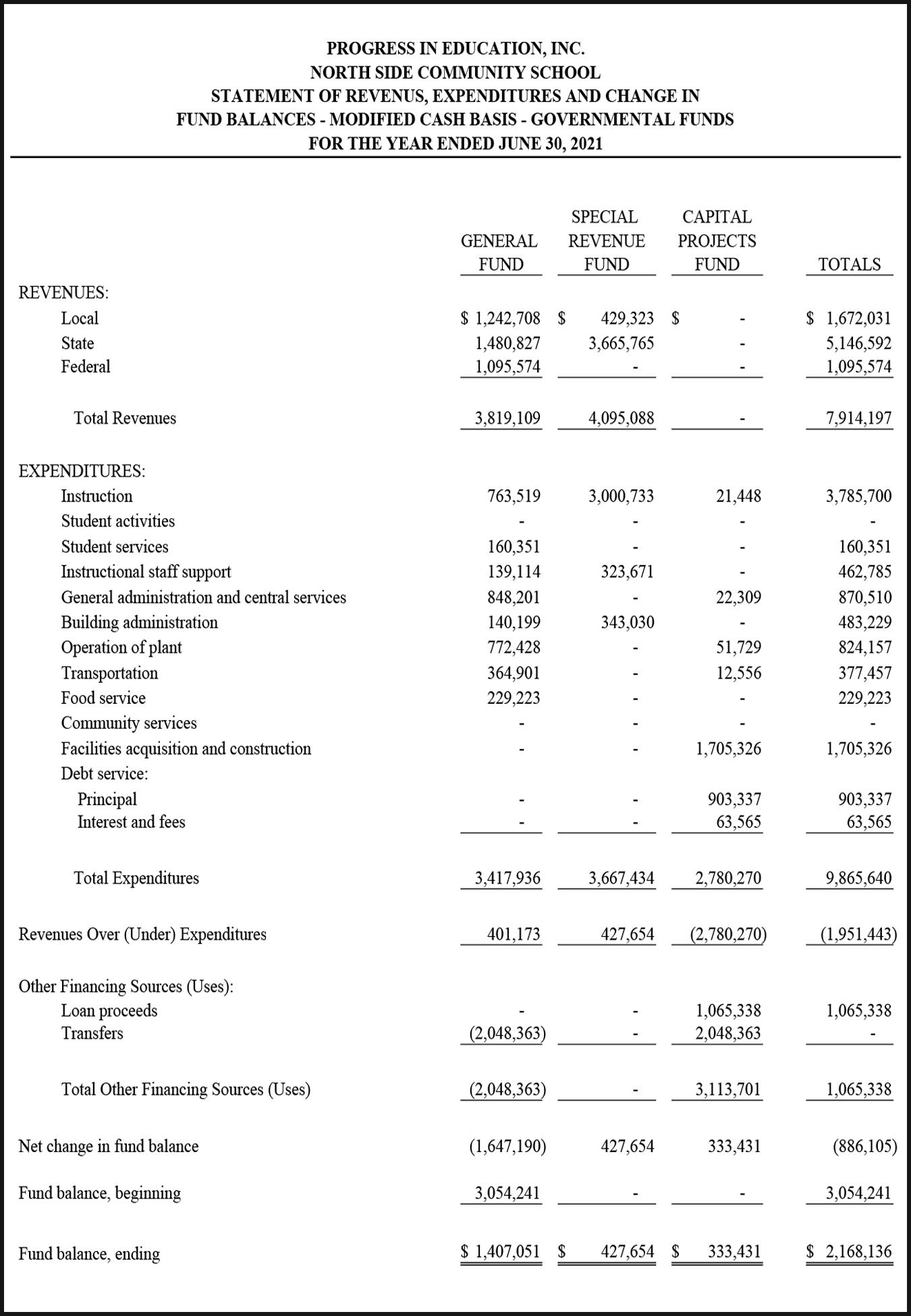
Goodwin Bros. Construction Co. is requesting subcontract bids and/or material quotations from qualifying minority business enterprises for relevant phases of work for Metropolitan St. Louis Sewer District, Lower Meramec WWTP Expansion Phase II, Contract Letting No. 12255-015.1. Interested parties should contact the Goodwin Office at (636) 931-6084. A pre-bid meeting for all interested MBEs will be held at Goodwin Brothers office at 4885 Baumgartner Road, St. Louis, MO 63129 at 8:00 am on Tuesday, February 15, 2022. Subcontractor/ Supplier bids are due March 7, 2022 at 5:00 p.m. An Equal Opportunity Employer
The Saint Louis Zoo seeks bids from qualified firms to submit proposals for Leadership Development Program 360 & Coaching RFP 2022. Bid documents are available as of 2/9/2022 on the Saint Louis Zoo website: stlzoo.org/vendor
REQUEST FOR PROPOSALS (RFP)
Greater St. Louis, Inc. hereby gives public notice that it is requesting proposals from interested and qualified environmental firms for the purpose of an environmental review and report of lot 4300 Finney located in the City of St. Louis. Copies of the Request for Proposal (RFP) can be found at: www. GreaterSTLinc.com/AMIC-RFP Deadline for submission is 12 p.m. (noon) on February 14, 2022.

2 BEDROOM
APARTMENT FOR RENT City’s Northside. $650/mo $1950 total to move in ( = deposit, 1st & last month)Proof of employment required. Please contact AL @ 314 320-9204
APARTMENTS FOR RENT
2 Bedroom, 1 Bath, completely re-decorated new carpet 314-346-1302

and woodwinds. The nature Tan Dun evokes here is the cataclysmic nature of earthquakes, tsunamis and hurricanes. “The Tears of Nature” sounded more like the raving, furious outburst of nature. It was the single loudest piece of music I have ever heard performed at Powell - the symphony as Stomp. For much of “The Tears of Nature,” which the orchestra was performing for the first time, Grubinger may as well have been performing alone. He was a one-man earthquake, tsunami and hurricane, drowning out all of the other instruments. This clearly is by design rather than a product of overplaying, for when Grubinger shifted from drum to vibraphone, he blended in beautifully with the woodwinds, brass and strings.
In the second half of the program, the St. Louis Symphony Orchestra sounded like the balanced yet dynamic ensemble we know and love. Elim Chan conducted Tchaikovsky’s relatively underplayed “Symphony No. 2 in C Minor.” It was last performed by the orchestra in 2012, when the young guest conductor was still a graduate student in music at the University of Michigan.
In this symphony, Tchaikovsky was not inspired by the brute force of natural disaster but rather the human voice - and the voice singing, not shrieking. This is a symphony built around Ukrainian folk song with the woodwinds and brass pitched in the range and tonalities of plaintive human song. The first folk song the composer quotes is “Down the Mother Volga,”

Multi-percussionist Martin Grubinger, from Salzburg, Austria, stole the show in a piece by an Asian composer,
a song about a mighty river with a thunderstorm in the lyrics (which are not sung in the symphony), but after the Martin Grubinger show even the suggestion of thunderstorm with rumbling timpani sounded like a light snowfall. Left alone at the head of the orchestra without the prowling Martin Grubinger, Elim Chan was not the sort of flashy conductor who imposes her personality on a piece of music.
She was passionate but precise, and the orchestra sounded fluent and confident in her hands. The Hong Kong of her childhood may be far in culture and association from the Ukraine where Tchaikovsky lifted snatches of folk song sung by the household butler for his second symphony, but together the conductor, composer and orchestra made Powell Hall glow like a warm home on a cold February night.
Continued from D1
designer or a stylist.
“I started getting consistent with taking pictures and posting them on my Instagram,” Stevenson said. “I was like I’m ‘bout to get a tripod and take my own photos. I got all these outfits. Why am I not showing them? I wasn’t trying to get paid, I was just doing it just to post. Man, it was like I posted one photo in December and it went viral.”
Stevenson said from that point on, brands started reaching out to her to collaborate and review their product.
“I was like, so you mean to tell me I’m a stylist putting clothes on other people but I get paid to do what I do every day,” Stevenson asked rhetorically. “I rebranded my company Imaj and made me the brand. It’s just been mind-blowing. I have finally found what I’m supposed to do.”
Terrill Keith, wardrobe consultant, model liaison, and bowtie designer said he appreciates Brown for the platform she’s giving veterans and newcomers to the industry.
“I also appreciate the fact that she’s bringing people together, bringing Black folks together because the fashion industry is so segregated, it’s so clique-ish, so childish,” Keith said.
Since its first installment, Black in STL Fashion’s success has spanned into a Facebook community and a nonprofit organization.
Brown said in addition to the photo campaign, she’s also started a small business grant program. Her website says the program is designed to help and support Black fashion small businesses in the St. Louis and Metro East area. Three recipients will receive grants between
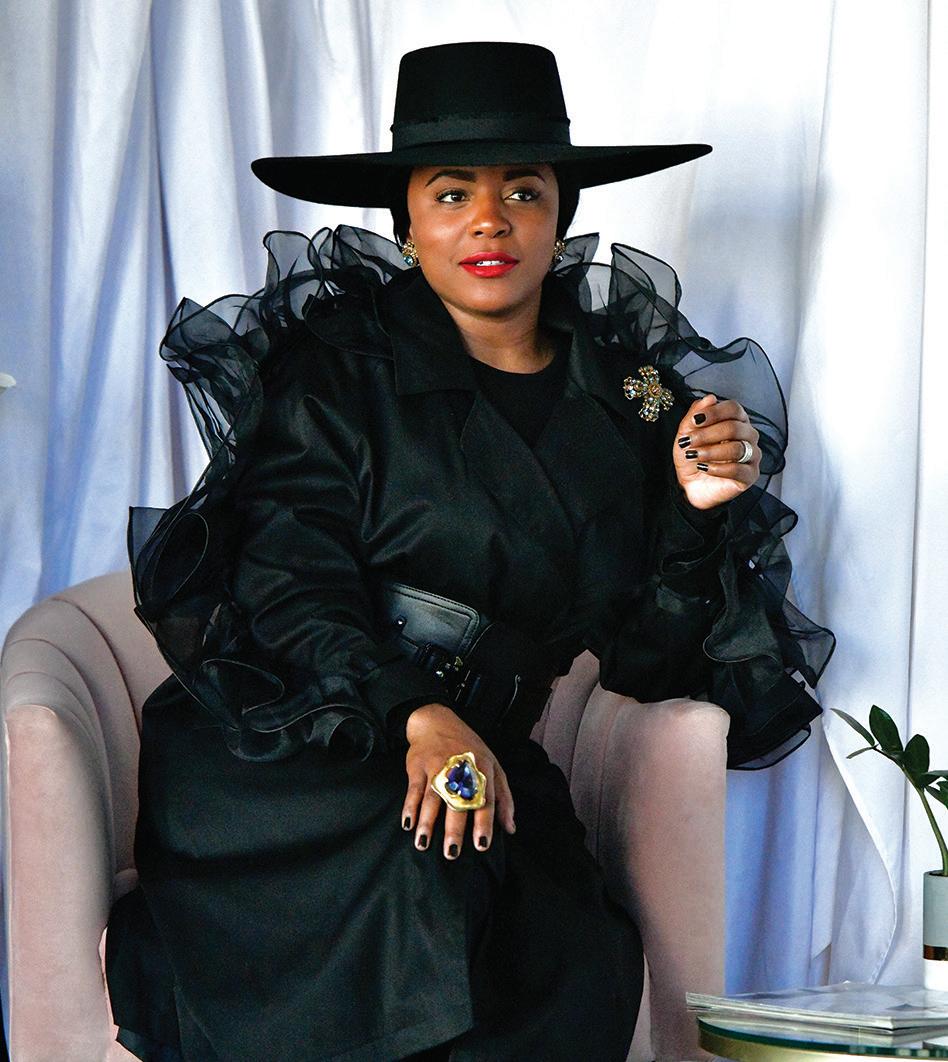
$50-$250 to use for any business expense.
“The money can be used toward gas, getting new inventory in your boutique, or new business cards,” Brown said.
“My plan is to start small because this money is coming out of my own pocket until we start to get the fundraising underway because that’s phase two. Now that we have content for the group that makes sense, people can put a face to what Black in STL Fashion is. We can go forth and get the fundraising, sponsorships, and donations to make this grant program bigger.”
Applicants have until April 1 to apply. For more information, visit https://www.akbrownstl. com/black-in-st-louis-fashionsmall-business-grant-app/. Yolanda Newson, owner of
YoroCreations jewelry line and YoroStyles wardrobe, styling, and set creation services said she met Brown many moons ago and is honored to be included in the photoshoot.
“I’m so honored to be part of it because anybody could’ve been here but she asked us to be here,” Newson said. “I’m here to support my sister in her endeavors.” Other creatives part of this year’s Black in STL Fashion project include Leonard Stewart Jr., Trimayne Boyd, owner of Embleu clothing line and co-owner of HUSTL3 C1T4 (pronounced Hustle City) retail store, and more. Find the photo of all the creatives on Brown’s Instagram profile, @akbrownstl.
Let your spirit of giving heat up the homes of needy children, the elderly, and the disabled.
VISIT OUR RESTAURANT FRIDAY MORNING, FEBRUARY 11
Buy a Sausage Biscuit or Egg Biscuit for $1.00 or drop off a donation.
We’ll donate all of the proceeds to Heat Up St. Louis for Missouri and Illinois charities. Donations accepted January 11- February 13.
Bulk biscuit orders will be taken now through February 9.
See details at
Continued from D1
with the following theme days: Motivational Mondays, Tell Me Something Good Tuesdays, Women Empowerment Wednesdays, What’s Going On Thursdays, and Freedom Fridays. She said season two’s daily themes differ this goround.
“Monday is now Manifest Monday and it airs on Mondays and Tuesdays, we’re manifesting things we’re transforming and we have motivational speakers like Comedian Guy Torry come on,” BerryMcGhee said. “Wednesdays is Woke Wednesdays. It’s about the cup of therapy, airing on Thursdays too. All four of us are on; we talk about women’s issues, and we have exclusives we call ‘Vibrant Vibe Tips’ where special guests will give tips. I always ask what’s in your cup, and I do the affirmations. Justice does ‘Peace in the Streets,’ you’ll always get a piece of spoken word that’ll give you peace. In her ‘Sippin Off the Saucer,’
segment Shameem tells us what’s happening in the community. Friday is ‘Free Yo Mind Friday,’ where talent will perform in front of our studio audience.”
Berry-McGhee said Tendai Morris, ‘The Hair Whisperer,’ president and CEO of Healthy Hair Solutions is one of the special guests who will provide ‘Vibrant Vibe Tips.’
“She will give tips about hair because as African American women we can’t watch Drew Barrymore and get tips,” BerryMcGhee said. “Those tips could include what happens when you lose your edges or what happens when you dye your dreadlocks.”
Lankford said one thing she loves about the show is it allows people to show the world they’re multitalented and have a heart.
“I think it’s important to tell your own story,” BerryMcGhee said. “When you’re owning your now you might even tell us something nobody ever knew because it’s yours to tell.”
Lankford said she hopes the show blesses the world and makes it a brighter place.
“I also wanna encourage
women of a certain age you can be anyone,” Lankford said “It’s never too late to be who you were created to be.”
“Own Your Now Show,” also airs on AH TV Network. It wasn’t something they asked for, Berry-McGhee said, but she knew the community needed it.
“Businesses needed to be seen and heard, new businesses needed a platform, people were dealing with grief, people were dealing with so many things and we needed to connect,” Berry-McGhee said.
Viewers can watch “Own Your Now Show’’ Monday through Friday, 8:30 a.m. on the AH TV Network’s channel on RokuTV, FireTV, and Apple TV. They also can watch on the AH TV Network App, YouTube, and Facebook Live. Dyvona Moore, based in Stockton, California sings the show’s theme song, “Unstoppable” and recently did a remix with Fred Hammond.
Guests interested in being part of “Own Your Now Show”’s studio audience can visit its website ownyournowshow.com for more information.
